SPAIN SUSTAINABLE













As responsible travellers, we all have a role to play. That often means spending our money where it’s needed, but it’s also about supporting those making a difference. It comes down to knowledge. Which is why, in this first Wanderlust guide to sustainable travel, we’ve partnered with the Spanish Tourist Office in the UK to shine a light on a country with plenty to show us. Come discover the people, places and projects in Spain making us all better travellers.
Spain is steeped in layered history, vibrant culture and abundant nature. It has always been a firm favourite for travellers.Visiting Spain’s diverse regions, and enjoying the unforgettable travel experiences that this offers, is only possible if we visit responsibly and sustainably. Spain’s rich history, biodiversity and culture are worth protecting and celebrating, as are the local communities that are home to many unique experiences.With a look at specific destinations, impressive projects and the people pioneering sustainable travel, we thank Wanderlust for producing this comprehensive guide that highlights the best of Spain’s sustainable travel experiences, to ensure that the country’s cultural and natural riches continue to thrive for its citizens and visitors for centuries to come.


16 A sustainable foodie’s guide to Basque Country
Discover the traditional tastes and dining delights of Spain’s gastronomic powerhouse
20 Astrotourism in Gran Canaria
Scan pristine night skies to admire distant galaxies from the Canary Islands
24 The natural drama of Aragon
Learn how a stroll among the Pyrenees helps chart the impacts of climate change
28 Cherishing Lanzarote
Explore the natural beauty of this Canary Island through the eyes of an artist
34 Rural tourism in Asturias
Discover the flavours and wildlife that make this rugged region the toast of the north
40 A green guide to Valencia
Innovative design, local food, famous festivals – how to make the most of the European Green Capital 2024
44 How Murcia embraced trees
Why the story of Sierra Espuña Regional Park offers hope for the future
48 Stretch your legs in La Gomera
This lesser-known Canary Island is quietly building a reputation for adventure travel
52 An eco-guide to Seville
Discover the green side to the famous city of oranges
56 Birding in Extremadura
We look at how efforts to preserve this wild region created a birder’s paradise
60 Mycology in Castile and León
Why truffles and mushrooms are making this north-western region a spot to savour
62 Catalonia’s natural parks
Explore the protected areas nurturing wildlife and supporting local communities
68 Regenerating Navarre
How organic wineries and agrotourism
gave this northern region a new lease of life
72 A slow-travel guide to Menorca
What’s the secret to getting the most out of this Balearic island? Dial down the pace
78 The artisans of Málaga
The inside track on where to find beautiful handicrafts in Andalusia’s artisan hub
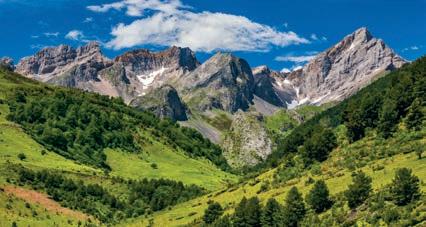
80 Ancient Cantabria
Delve into the past in a region renowned for Palaeolithic cave art and rural traditions dating back centuries
86 Biodiversity in Castile-La Mancha
Why the wetlands and wilderness areas of central Spain offer more than just a glorious escape to the country
94 Rebuilding the past
Stories of restoration and reimagination of some of Spain’s historic landmarks
100 The road to rewilding Spain
How the reintroduction of tauros cattle is rewilding the Iberian Highlands –and sparking thrilling new safaris
110 Spain’s most sustainable stays
Memorable hotels with tiny footprints
118 Hitting the rails
Go low-carbon while discovering one of the great joys of Spain: its extensive rail network
126 Gastronomic greats
Uncover the green secrets of Spain’s culinary success
136 Sail to Spain
Catching the ferry from the UK doesn’t just help lower your carbon footprint – it also offers rare moments of calm contemplation


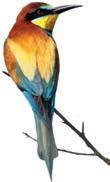


144 Responsible visits to Mallorca
Why only you can help Mallorca keep its Responsible Tourism Pledge
150 Winemaking in La Rioja
The iconic wine region goes green
154 Madrid’s flourishing foliage
The Spanish capital has been named Tree City of the World for five years running
158 Nature tourism in Tenerife
How the volcanic island is embracing its natural gifts to create eco-adventures
162 Accessible Spain
Top tips for planning your visit to an increasingly inclusive destination
166 Sea life in Formentera & Ibiza
The waters of these Balearic isles host one of Europe’s most under-threat ecosystems





172 Camino de Santiago guide
Meet one of the pilgrim route’s most knowledgeable guides: Fran Contreras Gil
176 Activist for cheese
Keep things local with Clara Diez, founder of artisan cheese shop Formaje, who shares her passion for regional varieties
180 Extremadura’s birding hero
Join Hugo Sánchez Mateos on the hunt for the region’s rarest avifauna
182 Queen of flamenco
Sara Baras on why this traditional dance means everything to those who love it
186 Wildlife champion
How Ricardo Almazán, wildlife park director, strives to rewild central Spain
190 Hotelier in Galicia
Director Julio Castro Marcote reveals what responsible hospitality looks like on the Galician coast
192 Nature-friendly farmers
Meet the wildlife-loving family who are transforming a Spanish farm into a biodiverse haven for nature




Like many Spanish cities,Valencia is a fascinating palimpsest, with layers of history laid down one on another.Take its golden-hued cathedral: a Roman temple on this site was replaced by a Visigothic cathedral, superseded by a Moorish mosque. The current Gothic edifice was consecrated in 1238, its medieval octagonal Miguelete bell tower offering spectacular views across the city. But Valencia takes its future as seriously as its past – and the colour is determinedly green. Think transport: this blessedly flat city is laced with over 200km of cycle paths, not to mention the vast, verdant Turia Gardens snaking 9km through the centre. For more on the European Green Capital 2024, see p40. ©VisitValencia
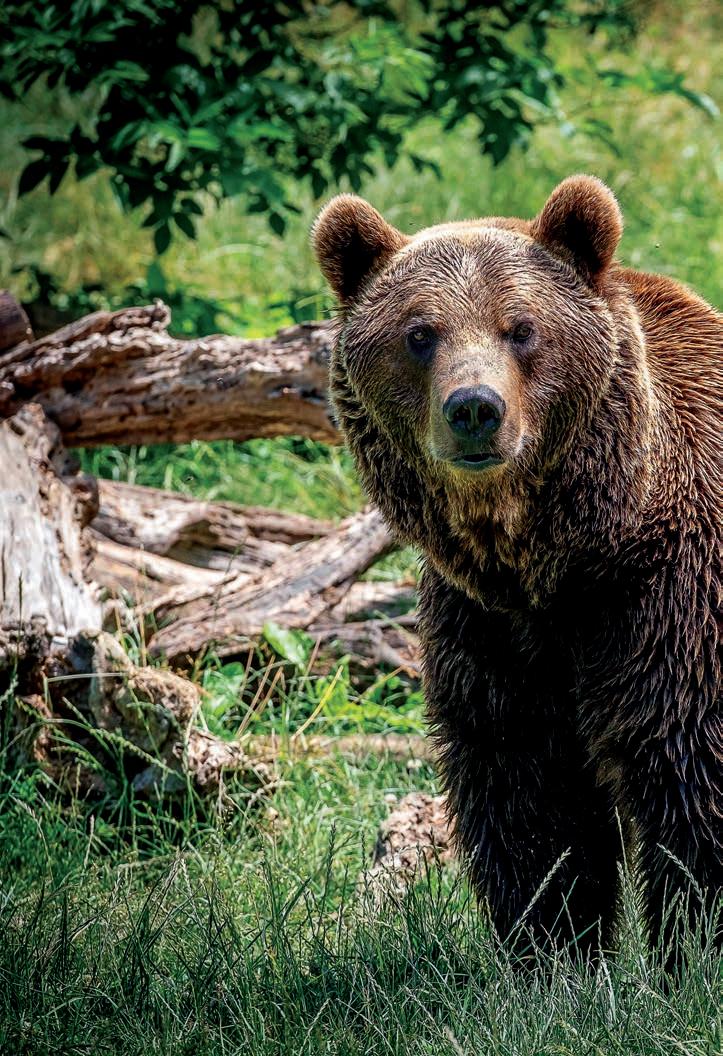

Just a few decades ago, the Cantabrian brown bear was on the brink of extinction, its numbers ravaged by habitat loss and hunting. Thankfully, the story is now a little happier, thanks in large part to the efforts of environmental groups such as the Asturias Bear Foundation; perhaps 300 roam the mountains of northern Spain today. Though they’re unsurprisingly shy, you’ve a decent chance of spotting one of these magnificent mammals in the pristine protected areas of Asturias, such as Somiedo Natural Park. For more ideas on exploring Asturias, see p34. © Lucas Vallecillos/Alamy
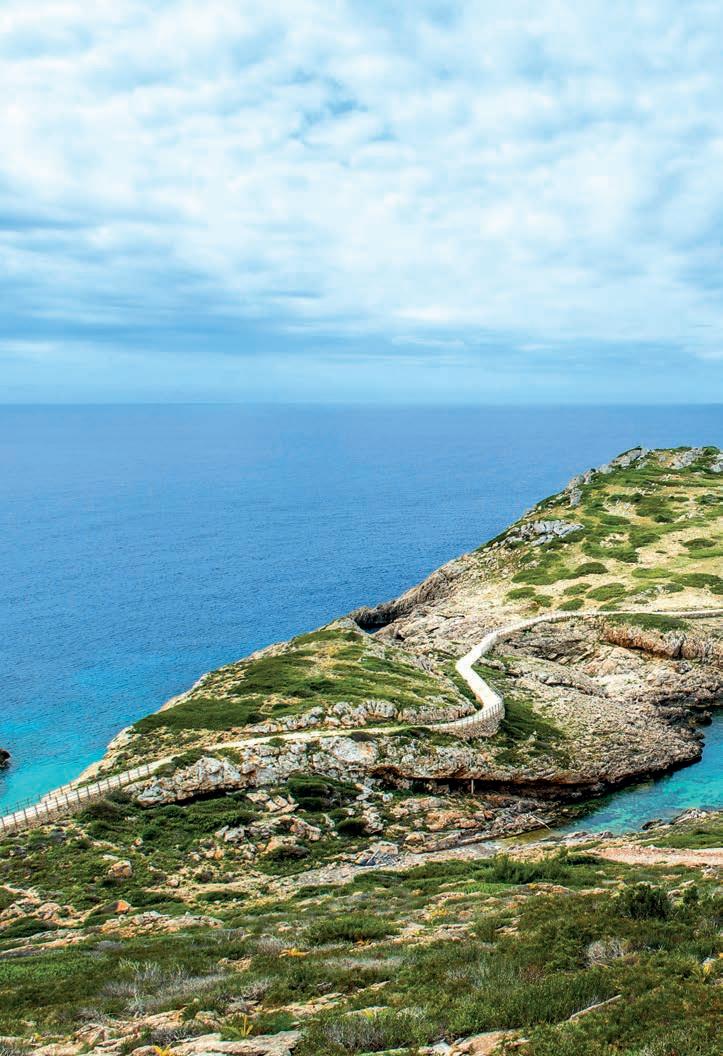
Alluring sites stud this limestone islet off Mallorca’s southern coast: a 14th-century castle, Es Celler Museum, the 20m-high Blue Cave, and the harlequin-patterned n’Ensiola Lighthouse, completed in 1868. But the real treasures lie beneath the waves in the surrounding Maritime National Park: loggerhead turtles, octopus and perhaps 500 more species of marine fauna, plus pristine meadows of swaying posidonia seagrass, so vital in the battle against climate change. To visit, take a boat ride from Colonia de Sant Jordi, watching for dolphins en route. For more on Mallorca, see p144. © Alexander Nikiforov/Alamy


Discover practical insights and recommendations for how to enjoy the many sustainable travel experiences found across Spain. Whether it’s stargazing on Gran Canaria or learning more about Paleolithic cave art in Cantabria, here’s how to make the most of the country and keep your footprint light.





t’s no secret that Basque Country is a foodie’s paradise. But while you’re pintxo-bar-hopping or enjoying a cider-house feast, you might be surprised to discover just how sustainable and ethical the culinary practices of this region are, with strong links to tradition, the land and the sea.That’s bolstered by the efforts of organisations such as AZTI, developing innovative projects around food and the marine environment to nurture a healthier and more sustainable society. Meanwhile, the Basque Ambassador programme showcases culinary professionals who champion the region’s cuisine globally. Eating and drinking in Basque Country is a joyful way to explore the land and meet its people, whether savouring traditional dishes or indulging in fine dining. Here’s how to experience the best regional food culture.
Basque Country’s most famous food experiences represent sustainability in its most organic forms – celebrating engagement with local communities, using zero-kilometre and seasonal products, and respecting centuriesold traditions. Here are a few not to miss.
Visit a cider house
Apple trees abound in Basque Country, so, unsurprisingly, cider-making dates back millennia.Visiting one of the region’s many cider houses is a fantastic way to immerse yourself in the local community and enjoy an experience rooted in ancient tradition.
Listen for the shout of “Txotx!” preceding a stream of golden cider spurting from a giant barrel, filling glasses held out by eager patrons.The probaketa – the traditional tasting of the year’s cider – has now evolved into a culinary celebration featuring a fixed-price menu of seasonal local dishes.
Between courses of pork sausage, omelette, salt cod and txuleta (large rib cuts of steak), laughter fills the air as guests socialise at the cider barrels. Txotx season runs from January to April, but some cider houses, such as Petritegi in Astigarraga, are open year round. petritegi.com/en
Sweet and sparkling (opposite and this page) Basque burnt cheesecake, a local favourite since it was
over three decades ago, has become a global sensation; augment a probaketa – the annual tasting of
Few dishes have gone viral quite as globally as the Basque burnt cheesecake – and La Viña, on Donostia-San Sebastián’s Calle 31 de Agosto, is ground zero. Cheesecakes line the walls of this bar-restaurant that’s become famous for its luscious desserts. The Basque version is lighter and airier than the more familiar dense, rich New York-style cheesecake. Invented almost by accident by Santiago Rivera, second-generation owner of La Viña, it has just five ingredients: cheese, sugar, eggs, flour and cream.The secret to its magic lies in the bake: a very high oven temperature caramelises the top of the cake, creating a beautiful golden-brown crust that encases a creamy, custardlike centre. lavinarestaurante.com/en/

The hearty Basque stew marmitako is a sustainable story in a bowl.This rustic dish, using every part of the prized albacore
⊲
first created at La Viña in Donostia-San Sebastián the year’s cider – with a feast of local Basque dishestuna, originated with fishermen who used part of their catch to sustain them on long trips at sea.They’d cook line-caught tuna with items that were easy to store on board – onions and potatoes, for example – simmered in a single pot over an open flame. Leftover bones fortify the broth, minimising waste.
Centuries on, marmitako continues to celebrate local, seasonal ingredients, using albacore caught during its summer migration to create this delicious hot soup.Taste it fresh from the pot at the simple restaurant Artza, overlooking the harbour in Bermeo.
In Basque Country, many dishes are prepared using beef from humanely reared older cows.Take the thick-cut ribeye txuleta steak, grilled to smoky perfection. The best txuleta come from locally raised, grass-fed cattle, ensuring exceptional quality and supporting Basque farmers while reducing both food miles and carbon


footprint. Another traditional favourite is sukalki, a hearty meat stew made by simmering beef trimmings in a rich broth. This nose-to-tail philosophy minimises waste and honours every part of the animal – a testament to the region’s deep respect for resources.
Any visit to the region must include a few stops for pintxos – small bar snacks similar to the tapas found elsewhere in Spain. Larger Basque towns all boast numerous fantastic pintxo bars – small, family-run spots where you can stop for a bite, a drink and a spot of socialising. Pintxos originated in bars in Donostia-San Sebastián’s old town as small, savoury bites to help soak up alcohol. Local ingredients have


always been prominent: expect to savour pickled olives, peppers and anchovies speared with banderillas (skewers), alongside hearty plates of mushrooms, liver or salt cod sourced from nearby farms and fishermen. Sustainability has long been a part of the pintxo tradition. Leftover cooked ingredients find new life on slices of bread or mixed with bechamel and fried, typically spiked with toothpicks to serve. Instead of large, resource-intensive meals, pintxos emphasise community and encourage exploration of diverse flavours through bite-size portions.
The region has become world-famous for its excellent restaurants, ranging from simple grill houses to Michelin-starred temples of gastronomy. Here are some of the finest places where you can enjoy an incredible meal – and feel good about it.
A meal at this three-Michelin-star restaurant near Larrabetzu, about 10km east of Bilbao, is a symphony of sustainability from start to finish.The striking, glass-clad building itself is powered by nature, incorporating geothermal heating and solar panels, and supplied by rainwater. Named as the world’s most sustainable eatery by The 50 Best Restaurants, Azurmendi serves an haute-cuisine tasting menu focused on local producers, with many ingredients collected or cultivated by the restaurant’s team.Waste reduction is an art form: food scraps are composted, recycling is meticulous, and water conservation is paramount. Under its gorgeous greenhouse ceiling, Azurmendi also hosts an incredible seed bank, part of an effort to safeguard local biodiversity. azurmendi.restaurant/en/
Take the highway inland from DonostiaSan Sebastián to Tolosa to find a small restaurant that’s reimagining Basque farmhouse cooking. At Ama, chefs Javi Rivero and Gorka Rico focus on the rich products
Sizzling and stewing (this page; top and above) Hearty Basque txuleta – thick steaks taken typically from older grass-fed cows – are best prepared by briefly flame-grilling until tender and smoky; the fish stew marmitako, a nourishing dish originally cooked by fishermen at sea using their catch of albacore tuna along with potatoes, onions and peppers, is named for the casserole in which it’s prepared – the name literally means ‘from the pot’ in the Basque languageand culture of their native province, shining a spotlight on lost recipes and less-known ingredients that the farmers and home cooks of the area have always used. Expect deep, rich broths and humble ingredients such as the local bean prepared to perfection and served elegantly, with a wonderful selection of regional wines to match. Ama chooses producers carefully, treating them like family – in fact, some of the dishes on the menu were inspired by meals that the chefs themselves enjoyed while making their rounds to local farmhouses to pick up the week’s produce. amataberna.net
In the heart of Donostia-San Sebastián stands a restaurant that bridges the gap between fisherman and diner, providing insights into Basque maritime heritage. A meal at Kofradia – Itsas Etxea is an immersive experience designed to connect visitors with both the local fishing community and the bounty of the Bay of Biscay. Come to eat a delicious grilled turbot but also to learn about the seasons for harvesting various fish species, traditional fishing techniques, and the sustainable practices of local fishermen, all driven by Basque fishermen’s associations. kofradia.eus
Perched between the renowned Bodega Gorka Izagirre winery, which produces txakoli (a slightly sparkling, very dry white), and Azurmendi, ENEKO pays homage to the region’s culinary heritage – with a modern twist. Double kitchens in the dining room hint at the culinary journey ahead, providing dual perspectives on Basque classics. Both, though, reflect the philosophy of chef Eneko Atxa – the powerhouse behind Azurmendi – linking eating with emotions. ENEKO boasts a Michelin star as well as the Michelin Green Star, recognising responsible sourcing and sustainability. Offering a more affordable fine-dining experience, ENEKO’s Sutan menu is an immersive masterclass in technique and tradition. eneko.restaurant/en/

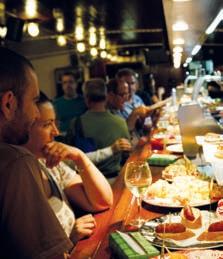
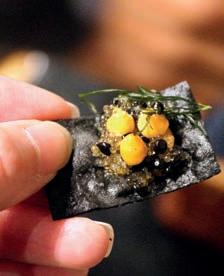




 A culinary journey (this page, clockwise from top) No visit to any major Basque town or city is complete without a pintxo-bar-hopping evening, grazing on tapas-like tidbits arrayed on bar counters; exquisite Azurmendi has been named the world’s most sustainable restaurant; Azurmendi itself is powered by nature; chef Eneko Atxa conjures up explosions of flavour in his eponymous restaurant near Larrabetzu, just east of Bilbao, and at fine-dining Azurmendi next door
A culinary journey (this page, clockwise from top) No visit to any major Basque town or city is complete without a pintxo-bar-hopping evening, grazing on tapas-like tidbits arrayed on bar counters; exquisite Azurmendi has been named the world’s most sustainable restaurant; Azurmendi itself is powered by nature; chef Eneko Atxa conjures up explosions of flavour in his eponymous restaurant near Larrabetzu, just east of Bilbao, and at fine-dining Azurmendi next door
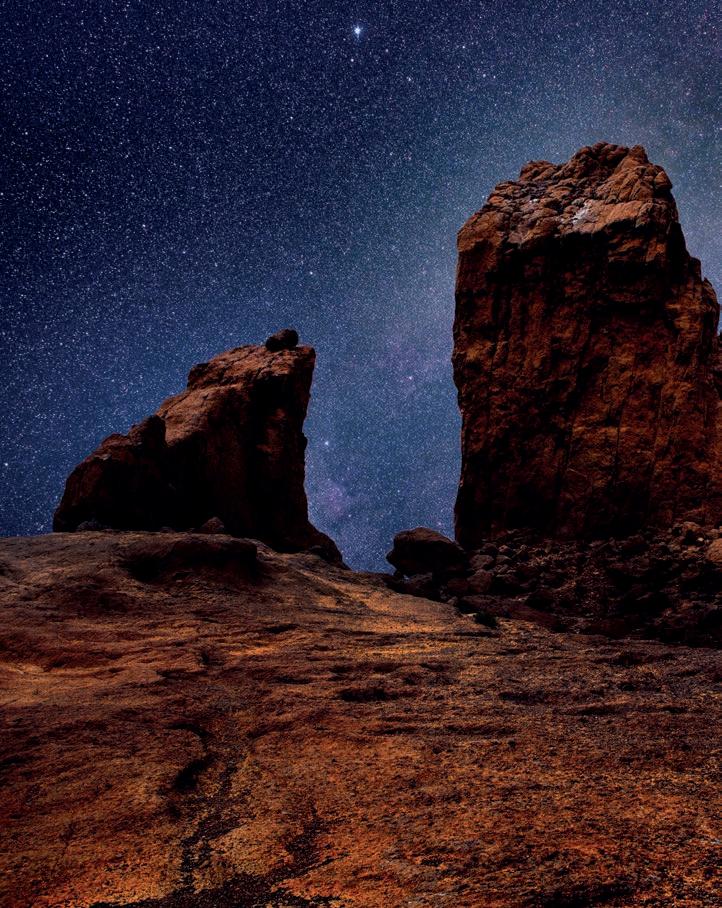
Explore pristine skies and sustainable sights among and above the wild landscapes
Words by Ross Clarke
Think of Gran Canaria, and you probably picture golden sand dunes, dazzling sunshine and buzzing nightlife. But step away from the bright resort lights and you can discover fascinating history – such as that of the island’s cave-dwelling pre-Hispanic inhabitants – expansive mountain vistas, sky-scraping monoliths, and abundant wildlife and flora. And while there’s plenty to occupy you at ground level, it’s what stretches above your head that sets Gran Canaria apart from most other beach destinations. The whole island is a certified Starlight Tourist Destination, so you’re pretty much guaranteed stellar views at any time of year. Its unique landscape has been protected over many generations and, with minimal light pollution keeping skies dark, and extraordinary vantage points, it’s one of the world’s finest stargazing destinations.
Peak practice (left to right) The 80m volcanic crag Roque Nublo provides a dramatic backdrop for stargazing; head into the highlands to admire the skies from Pico de las Nieves
The Starlight Foundation is an organisation striving to keep night skies pristine – and it’s no coincidence that the foundation is headquartered in the Canary Islands, recognised as one of the world’s best regions in which to study the stars. The archipelago is home to Gran Telescopio Canarias, the largest single-aperture optical telescope on the planet, sited on La Palma, as well as other equipment used by top astronomers. But it’s not just the pros who come here to watch the stars, which is why Gran Canaria is certified as a Starlight Tourist Destination, having been assessed by the Starlight Foundation, in collaboration with UNESCO, for its stargazing potential and tourism infrastructure. This recognises the fact that Gran Canaria not only has dark skies, and regulations to protect them, but is also set up to enable
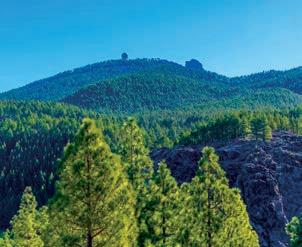
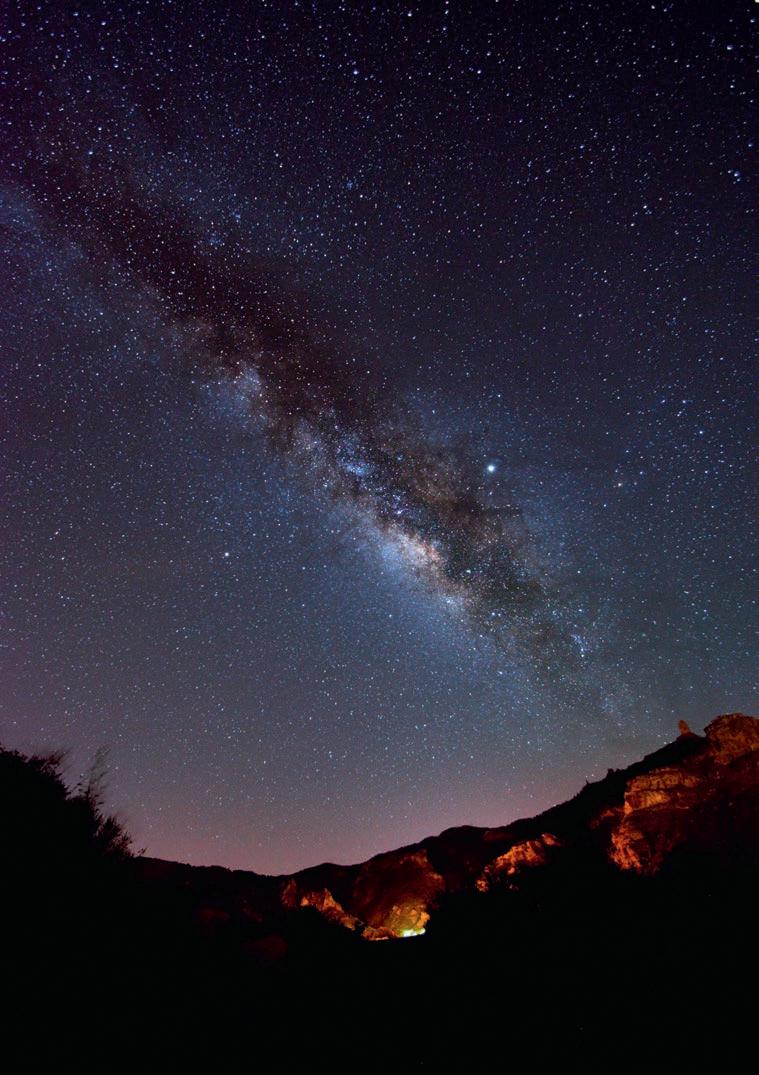
tourists to observe the stars, with dedicated accommodation, tours and viewing points that contribute to the local economy.
On this small island, easy to navigate by car and bus, it’s straightforward to get away from the light pollution created by major resorts, towns and traffic.The craggy volcanic landscape also offers plenty of high-altitude spots away from artificial light, so you’re never far from a great stargazing site. In addition, the natural weather phenomenon known as the Panza de Burro (‘donkey’s belly’), produced by trade winds, often lays a blanket of low-level cloud blocking light from the capital, Las Palmas de Gran Canaria; simply climb into the mountains above that cloud to enjoy the darkest skies.
Many of the island’s most-famous stargazing spots are in the south, where you’ll also find theTemisas Astronomical Observatory, the largest on Gran Canaria. Here you can learn about our galaxy, the various constellations and many more celestial details.You can also visit Roque Saucillo Astronomic Centre in San Mateo for dedicated tourism events, and the Guguy Interpretation Centre and Astronomical Observatory in Tasartico (in La Aldea de San Nicolás) in the west.
There are plenty of public viewpoints ideal for stargazing, too. At the Mirador Astronómico de la Degollada de lasYeguas, just a 15-minute drive from Maspalomas at the island’s southern tip, you can witness the night sky among the majestic mountains and volcanic landscape of a dramatic ravine – bring a picnic for sunset and stay for stargazing. Alternatively, head to the giant crater of Caldera de Los Marteles in the centre, or to Mirador Astronómico de Pinos de Gáldar in the north. astrotemisas.es/en/inicio-en; miradordelcielo.es; guguy.org/inicio-en/

what to look for in the heavens.The company’s founder is a Starlight Astronomy Monitor accredited by the Starlight Foundation. Another option is Astroeduca, an organisation staffed by astrophysicists and other scientists that has been teaching people of all ages about the stars for nearly three decades – more than 75,000 children and 30,000 astrotourists have experienced education programmes including visits to observatories and to the highest points on the island. Astroeduca works with the Canarian government and the tourist board to invest in sustainable astrotourism and the preservation of the natural environment, as well as researching how best to protect the night sky. astrogc.com; astroeduca.com
“The craggy volcanic landscape offers plenty of highaltitude spots away from artifical light, so you’re never far from a great stargazing site”
For beginners, one of the best ways to explore the night sky is to join an organised tour to one of the best stargazing spots in Gran Canaria. Experts bring specialist equipment such as telescopes and binoculars, as well as knowledge of the movements and mythology of the stars.
One such tour company in the south of the island is astroGC, offering five-hour workshops during which you’ll learn how to set up and position a top-quality telescope, and
The original inhabitants of Gran Canaria used the sun, moon and stars to both understand and navigate their environment and lives.When you head up into the quiet of the mountains, surrounded by heat-retaining volcanic rock and resplendent nature, it’s easy to see why. It takes about 20 to 30 minutes for human eyes to fully adjust to darkness – but when they’ve become accustomed to the inky blackness, the sky seems awash with stars.
Dark-sky and astrotourism initiatives are hugely important for maintaining both the natural environment of Gran Canaria and its cultural heritage. Thanks to its Starlight Foundation-certified status and stargazing resources, the island is the
in the far south
ideal place to discover the magic of astronomy.You’ll benefit not only by admiring the celestial beauty overhead, but also from the calm and relaxation that simply being in nature brings. Crucially, when you book onto dedicated stargazing tours and programmes you’ll also be helping to support local communities and the environment. And, because the island is so well connected, you can easily enjoy its sunshine and beaches during the day and head out stargazing that same night.
With its year-round temperate climate and long hours of sunshine, Gran Canaria is perennially popular, though spring and autumn tend to be less crowded than summer. Stargazing is possible year round, though sunset is later in summer. Pack warm clothing: even when the coast is balmy, the mountain air gets chilly at night.
Several airlines make the four-hour flight to Gran Canaria from airports across the UK.
Carnival, typically in February and March, is celebrated with huge parties in towns across the island. Transgrancanaria is a 126km trail running race, also in February. Valsequillo Strawberry Festival is usually held in late April or May.
Look to the skies (left to right) With clear skies and minimal light pollution, Gran Canaria is the ideal place to admire celestial views of the Milky Way draped across the heavens; enjoy spectacular stargazing even close to busy resorts such as MaspalomasGuarded by the high peaks of the Pyrenees, Huesca province opens a window onto the past – and the impact of ongoing climate change on its magnificent nature
Words by Esme FoxTucked into the north-east of Spain lies a rural region dominated by dramatic mountains and studded with quaint hilltop villages stretching down to the vast basin of the Ebro River: Aragon. With the Pyrenees forming its northern border abutting France, Aragon is flanked by Catalonia to the east, Valencia to the south, and Navarre, La Rioja, Castile and León, and Castilla-La Mancha to the west. And each of its three provinces has its own distinct personality. Huesca, in the north, is a playground of Pyrenean peaks; the mighty Ebro snakes through the central province, Zaragoza; and Teruel, the southernmost, is renowned for its medieval Mudéjar architecture, blending Jewish, Moorish and Christian influences.
Adventurous travellers head into the high Pyrenees to roam one of Spain’s wildest, most dramatic protected areas, the Posets-Maladeta Natural Park. Here, waterfalls cascade from snowy peaks, rocky mountains scrape the sky, and lakes and rivers glint in wide, green valleys. It’s also home to the highest peak in the Pyrenees, Spain’s third-tallest: Aneto, soaring to 3,404m.
The park is criss-crossed with hiking trails leading to scenic highlights. Most
Gleaming crags
Jagged limestone ridges loom above the Valle de Hecho in the Aragon Pyrenees – just one of many magnificent vistas along the GR11 longdistance hiking trail snaking across the region ⊲


demanding is the GR11 or Senda Pirenaica, the long-distance hiking trail winding some 840km south-east along the full length of the Pyrenees from the Cantabrian Sea to the Mediterranean. Another popular walk is the testing four-day Route of theThree Refuges circuit, linking the mountain huts of Estós, Viadós and Ángel Orús. For a gentler stroll, try the 4.5km route to the Forau de Aigüalluts, one of the park’s most striking waterfalls, a relatively easy two-hour out and back walk from La Besurta parking area.
As well as hiking, a number of experiences immerse visitors in the natural and cultural history of the park and the wider Pyrenean region of northern Aragon.While enjoying a deeper experience of this remarkable environment, you’ll also be supporting local communities.



Women’s ways (this page, top–bottom) The GR11, or Senda Pirenaica (Pyrenean Path), is among many trails criss-crossing Aragon’s Parque Natural Posets-Maladeta; flower-lined tracks pass traditional stone buildings in that park’s Chistau Valley; discover the culinary traditions and sustainable initiatives of Pyrenean women on a unique tour through the foothills of Aragon
Led by a biologist and guide specialising in mountain ecosystems, PiriNature Experiences’ Liquenometría (Lichenometry) excursion in the Vallibierna valley is a hiking adventure, a voyage of discovery and a scientific investigation all in one. On an early morning hike, your guide will point out patches of lichen growing on the rocks, and explain how studying these enables experts to estimate the rate of glacial retreat and explore the story of those once-expansive ice masses. Contribute to the research using a magnifying glass and measuring device, observing evidence of climate change for yourself and helping track its progress. Along the way, marvel at jaw-dropping views of Aneto and sample traditional Pyrenean produce including goat cheeses and patés. pirinatureexperiences.com
and learn about various sustainable projects being spearheaded by Pyrenean women. Spend the morning on the mountain with shepherdess Sara and her sheep and goats, then learn about plans for her cheese factory. Discover how biologist Azpe is helping to repopulate abandoned villages, and taste Maite’s vegetarian cooking, focusing on seasonal produce and the circular economy. Nature and sustainability are the core values embedded in each activity during the tour. mundoara.com/viajes-en-grupo/
“Discover how a biologist is helping to repopulate abandoned villages, and taste vegetarian cooking focusing on seasonal produce and the circular economy”
Mundo Ara Travel’s three-day Huellas (Footprints) experience shares with visitors the stories of Pyrenean women as told by those remarkable individuals. Stay in a sustainable rural home and join daily guided excursions and activities to learn about the healers, washerwomen and witches of days gone by, visiting peaceful towns and villages, such as Guaso, Boltaña and Aínsa, where local crafts are still made using traditional methods.You’ll also support
Drink in a Pyrenean panorama
Take a 4WD journey to one of the finest mountain viewpoints in Aragon, accessing remote, rugged areas in the Parque Natural de losValles Occidentales in the far north-west. The excursion, offered by adventure company Ojos Pirenaicos – owned by local nature guide David Ruiz de Gopegui – traverses a wild track leading up to the Mirador del Pirineo, with your guide introducing local flora and fauna en route.The journey climbs to 2,000m and a natural balcony affording one of the most spectacular vistas in the Pyrenees range. At the top, take a stroll to admire the views and to absorb the natural spectacle revealed from this lofty eyrie.Vultures soar on air currents above, mountain goats leap from rock to rock, and delicate edelweiss flowers bloom on the mountain’s edge. During the colder months, there’s also an option to strap on snowshoes and tramp around the heights. ojospirenaicos.es



Spring, summer and early autumn are the best times to visit the Aragonese Pyrenees; higher trails can be blocked by heavy snowfall in the colder months. Though summer is high season in much of Spain, the Pyrenees largely remains peaceful and crowd-free – and exploring the mountains is a great way to escape the stifling heat in cities and lower areas.
Getting there & around Ryanair (ryanair.com) operates the only direct flight to Aragon from the UK, flying to the regional capital, Zaragoza, five times a week in just over two hours. From Zaragoza, the best option is to hire a car and drive three hours to reach the Pyrenees. Alternatively, the French city of Toulouse is a three-and-a-halfhour drive south across the border.
The Pyrenean Folk Festival, held in the town of Jaca every other August (next in 2025), features performances from folkloric groups from around the world, as well as exhibitions, workshops and gastronomy. festivaljaca.es
Fiestas del Pilar is a week-long series of events held in Zaragoza on and around 12 October. These honour the Virgen del Pilar, the city’s patron saint, with parades involving gigantes (giants) and cabezudos(‘big heads’) plus fairs, concerts and puppet shows. fiestasdelpilar.com
Deep history (this page, top–bottom) The mountain village of Aínsa is graced with fascinating medieval buildings including the 11th-century Romanesque Church of Santa Maria; trek for far-reaching views across the Pyrenees and rest in refuges like the Estos mountain shelter; the Aragonese Pyrenees are studded with dozens of gorgeous glacial lakes known locally as ibones Making a point The creation of local artist César Manrique’s extraordinary Cactus Garden rehabilitated a neglected agricultural area on Lanzarote
Making a point The creation of local artist César Manrique’s extraordinary Cactus Garden rehabilitated a neglected agricultural area on Lanzarote

Get a fresh perspective on the volcanic island’s spectacular landscapes, nature and architecture through the works of César Manrique
Words by Robin Catalano
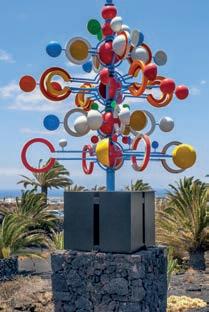
Fertile imagination (this page; clockwise from top left) Manrique’s Cactus Garden features some 4,500 spiny plants of about 500 species from five continents; the artist’s diverse output included colourful Wind Toys, huge mobiles installed across Lanzarote; a Manrique sculpture at Los Jameos del Agua represents the endemic blind albino squat lobsters that survive in darkness in the caves; (opposite; top and bottom) Los Jameos del Agua is a cultural centre and performance venue created by Manrique in tunnels formed by volcanic activity millennia ago, set in lush gardens replete with an alluring al-fresco pool
Of the seven main Canary Islands, prized by travellers for their remoteness and year-round warm climate, Lanzarote is the most unusual. Its lunar landscape, forged by centuries of volcanic eruptions, is enhanced by the jaw-dropping designs of the late visionary architect and artist César Manrique. By fusing art and nature, and fighting against unchecked development on the island, he spearheaded a sustainable tourism model decades before the concept became widespread.
Born in Arrecife, Lanzarote, in 1919, Manrique earned a scholarship and completed a degree in painting from the San Fernando Royal Academy of Fine Arts in Madrid. Following a brief stint in New York City, where he began branching out into other art forms, he felt an “imperious need to return to the land,” coming home to Lanzarote in 1966.
Until his untimely death in a car accident in 1992, the island served as Manrique’s muse. He buried, hid or camouflaged buildings within the island’s volcanic rock, and used local materials such as volcanic ash, vegetation, marine pebbles and stones to decorate his fanciful designs. Alfredo Díaz Gutiérrez of the Fundación César Manrique said of the artist: “He always defended the use of materials from the environment to integrate and adapt his interventions with the least possible impact [on the land].”
Over the last quarter-century of his life, Manrique designed a variety of groundbreaking public and private spaces that worked in dialogue with the natural landscape. Although the majority of his works are in Lanzarote, you can also find Manrique’s indelible modernist style all over the archipelago, including on the islands of Fuerteventura, Tenerife, La Gomera and El Hierro.
Most famous of his Lanzarote designs is Los Jameos del Agua (literally ‘The Holes of Water’), an elaborate underground venue created inside volcanic lava tubes on the island’s northern coast. Designed as a centre for art, culture and tourism, it features a natural auditorium, seating areas, palm garden and a bright azure artificial lake.The venue’s subterranean clearwater pond is the habitat of the island’s population of endemic blind albino crabs (actually squat lobsters). Just beyond the sunny patio, you’ll find the newly redesigned House of the Volcanoes, an interactive museum that details the island’s fascinating geological history. cactlanzarote.com/en/centre/ jameos-del-agua-guide/
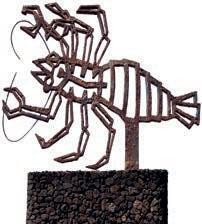
Manrique also created the otherworldly Cactus Garden in Guatiza, in the north-east of the island, filled with prickly vegetation. Stroll through its Seussian greenery before settling in for lunch at the terrace restaurant, which highlights cactus-based dishes across its menu, from prickly pear burgers to nopal ice cream. Finish your meal with a barraquito – a sweet, layered Canarian coffee drink with the kick of Spain’s famous Licor 43 liqueur. cactlanzarote.com/en/centre/jardin-de-cactus Manrique’s home, Taro de Tahíche, lies about 5km inland from the coast and Arrecife, his birthplace and the island’s capital city. At his ‘Volcano House’ he transformed volcanic bubbles into living spaces where he entertained artists and celebrities of his day. It’s now the home of Fundación César Manrique, an organisation dedicated to preserving his legacy. Here you can admire a variety of his paintings and sculptures, films and photos of the artist in action, and even his studio. fcmanrique.org/en/casas-museo-visitas LagOmar, a mansion in Nazaret in central Lanzarote, is a place of stony bridges, shady passageways and living spaces chiselled out of a cliff.This one-ofa-kind design was a collaboration between Manrique and Fuerteventura-born
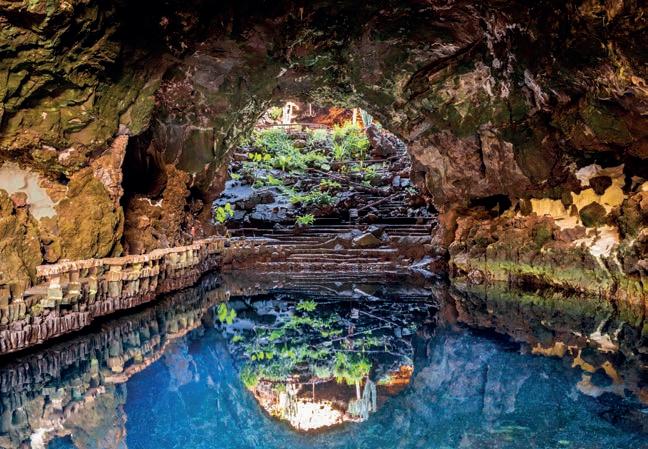





landscape architect Jesús Soto. It owes its name to the story that actor Omar Sharif owned the house for two days – then lost it in a game of bridge. By night it’s a respected restaurant. lagomarlanzarote.com/en/
Near Lanzarote’s northernmost tip is one of Manrique’s most striking creations. El Mirador del Río is a glass-walled, escarpment-carved balcony viewpoint that seems to float 400m above the Chinijo Archipelago Natural Park.Take in panoramic views south along the Famara cliffs and across a narrow strait to sister island La Graciosa.
Nearly 40km to the south-west, inTimanfaya National Park, Manrique designed the café-in-the-round El Diablo Restaurant. Here you can watch chefs roast meat, vegetables and the island’s excellent fish and seafood over the mouth of a hot lava pool.
Islote de Fermina, one of his final projects, opened in 2023. A low-slung, snowy-hued beacon that squats along a peninsula in Arrecife Bay, across a footbridge from the Arrecife Gran Hotel, it houses a new interpretive centre exploring the island’s underwater heritage. A climate change observatory is also in the works. cact lanzarote.com/en/centre/ islote-de-la-fermina/
From the 1950s, Manrique became increasingly outspoken about property and tourism development that he felt threatened Lanzarote, especially along the coast. He sparked discussions on topics such as quality tourism, visitation limits, the need for laws to protect the island’s fragile ecosystem and cultural heritage, and the artist’s responsibility in conservation. “Manrique’s critical discourse regarding the deterioration caused by tourism development is, without a doubt, his great legacy,” said Díaz. “His contribution of useful ideas about sustainability and the much-needed culture of limits transcended his time.”

Thanks in no small part to Manrique’s efforts, Lanzarote was designated a UNESCO Biosphere Reserve in 1993. He was equal parts artist and sustainability pioneer, and he also, according to Díaz, “turned the island into the manifestation of his utopian dream”. In his Lanzarote, Unpublished , he wrote: “It is necessary to attract high-quality tourism, not of rich people but of human quality, because Lanzarote is an island for meditation... like a great symphony that requires time to be understood.”
When to go April to early October is high season, though temperatures can be stifling in high summer. Come in autumn or early winter, when the island receives plenty of sun but far fewer visitors.
Getting there
Until mid-June, weekly Naviera Armas ferries (navieraarmas.com/en) sail from Cádiz, Andalusia, to Arrecife in around 27 hours. Direct flights serve Lanzarote from most UK airports.
Events
Canarians love a festival. Some of the biggest on Lanzarote include Twelfth Night (5–6 January), Carnival (dates vary from mid-February into March), and Canaries Day (30 May), celebrating the island’s autonomy and the first session of the Canarian parliament in 1983. Most eye-catching is Corpus Christi (late May or June), when detailed designs in colourful sea salt are created on roads around San Ginés Church in Arrecife.


Get a taste for rural tourism in Asturias
Discover the unique flavours and flourishing wildlife of this mountainous northern region
Words by Marti Buckley The bear is back
The bear is back



Tucked away on the map of Spain, wedged between Galicia and Cantabria on the northern coast, is a modest green corner: Asturias. Modest only in cartographic terms, though – because this spectacular province is a rough-cut gem.
The highpoints of the region, literally and figuratively, are among the Picos de Europa – the craggy mountain range stretching west to east just inland from the coast.With some 40 summits soaring above 2,500m, these peaks offer marvellous adventure tourism and wildlife-watching, being home to brown bears and birds of prey.
Thanks in large part to the region’s rugged terrain, Asturias’s traditional culture remains largely intact in its gorgeous rural hinterland. That culture encompasses a rich gastronomic heritage featuring unique products including world-renowned cheeses and traditional cider. No wonder slow and sustainable rural tourism is thriving.
There’s one aspect so intrinsically woven into regional identity that it’s been nominated for recognition on the UNESCO Intangible Cultural Heritage list: Asturian cider culture.The production of sidra has flourished here for over 2,000 years, evolving a set of distinctive rules and traditions. Of more than 2,000 varieties of apple growing in Asturias, only 22 are permitted to be used in cider-making, and even the pouring technique has developed into a unique style. That’s not all that’s evolved, though: today, modern machinery such as hydraulic and pneumatic presses have been introduced to the process that produces some 45 million litres of cider each year. But the handling of the apples and the fermentation of the cider are still largely traditional, artisanal affairs.
Cider tourism offers a way to explore Asturian culture with all of your senses. On a tour of a cider producer, you can watch apples being picked over by hand to ensure the highest quality of product, visit the llagar (pressing area) and taste fresh cider straight from stainless steel tanks. Be sure to join a traditional espicha – a meal in which standing diners snack on dishes such as chorizo marinated in cider, empanadas, boiled eggs, fried cod and omelettes, while savouring cider.

Pouring Asturian cider is a skilled ritual and annual contests are held to find the best escanciador. Gijón is the city with the most sidrerías (cider houses), and is therefore a particularly great place to indulge in a local Asturian cider crawl. ⊲
Heights of gastronomy (this page; clockwise from top) Pouring Asturian cider is an art form in its own right; savour lightly smoked Gamonéu cheese; seek out Asturias’s famous cider in Gijón; (right page) the spectacular Picos de Europa range encompasses some 40 peaks over 2,500m in altitude


No fewer than 42 types of cheese are produced in Asturias, some matured in the caves of Picos de Europa National Park. Star of the show is Cabrales, a piquant variety made from cow milk, sometimes blended with goat or sheep milk, speckled blue and traditionally wrapped in maple leaves. Produced here for over 1,000 years, this prized cheese contributes to an active shepherd culture in the mountains.
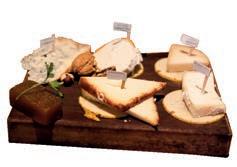
of brown bears in the wild is now possible. For the best chance of a bear sighting, visit the south-western part of the province during April or May, and hire an experienced local guide.
Creatures and cheeses (left–right) Thanks to government policy changes and the efforts of the Asturias Bear Foundation, these magnificent mammals are returning to Asturias; try some of the 42 varieties of cheese produced in the province
Visiting cheese producers is a wonderful way to explore Asturias. Join an organised tour delving into the caves where cheeses are matured for months in the damp chill. Stop in at the Cueva del Queso de Cabrales (Cave of Cabrales Cheese), a museum in Las Arenas de Cabrales featuring a replica of traditional mountain cabins, with exhibits exploring traditional cheesemaking and its important place in the local economy. Visit the town on the last Sunday in August to enjoy the annual Cabrales contest, at which you can taste an astonishingly wide variety of this flavoursome blue cheese.
Cabrales is only one of those dozens of traditional cheeses you should try in Asturias. Gamonéu is a lovely, lightly smoked cheese with a thin, natural rind, made from a combination of cow, goat and sheep milks. Discover the producers while walking the 3km Onís Cheese Route around the village of Benia de Onís, visiting various cheesemakers, farms and caves across Gamonéu country.
Journey even farther off the beaten path to find Asturias’s lesser-known cheeses. There’s Taramundi, a variety typically made with the milk of young cows and studded with walnuts and hazelnuts, produced in the far west of the province. Or try the rare Beyos, a small cheese made by only a few families in a strictly artisan fashion. Then there’s the oldest cheese in Asturias, the Afuega’l Pitu, made with milk from cows milked late in the day. fundacioncabrales.com/cueva-exposicion/
The brown bear is the largest wild land animal on the Iberian Peninsula. Only four decades ago, this magnificent creature was facing extinction after years of overhunting. Fortunately, following policy changes and environmental activism by groups such as the Asturias Bear Foundation (La Fundación Oso de Asturias), numbers are recovering. Nearly 300 bears now roam the wider Cantabrian range.
Thanks to intensive conservation work in the mountains of Asturias, catching a glimpse
To learn more about this spectacular species, and for the latest information on wildlife sightings in the area, stop in at the Casa del Oso (Bear’s House), the Asturian Bear Foundation’s headquarters in Proaza, housing an exhibition on brown bears in Asturias. Or explore on foot or bike along the Senda del Oso (Bear’s Path), a 50km greenway trail following the route of a former mining railway. En route, stop at the Cercado Osero, fenced compounds that are home to Paca and Molina, Cantabrian brown bears rescued by the foundation. osodeasturias.es
When to go Asturias’s climate is temperate and mild, but winters are very wet. Summer is the best time to visit, though August weekends can be busy.
Getting there & around
Year-round, direct flights from various UK cities serve Asturias Airport near Oviedo and, less frequently, Santander, further east along the coast from Asturias province. Brittany Ferries (brittany-ferries.co.uk) sail frequently overnight from Portsmouth and Plymouth to Santander.
Renfe Cercarias AM (formerly Feve; renfe.com/es/en) runs a high-speed train between Pola de Lena and Madrid. Car hire is often the most convenient way to get around.
Events
Fiesta de L’Amuravela in Cudillero (29 June) features a sermon given in pixueto, the local dialect of Asturian. El Bollo in Avilés (Easter) sees starshaped bollos cakes handed out. Fiesta de las Piraguas (August) witnesses hundreds of canoeists descend 20km along the Sella River.
Languages
Asturianu is spoken in rural districts, along with Spanish.

Spain’s third-largest city is a hub of local gastronomy, culture and the outdoors. Here’s how to make the most of it…
Words by Laura Field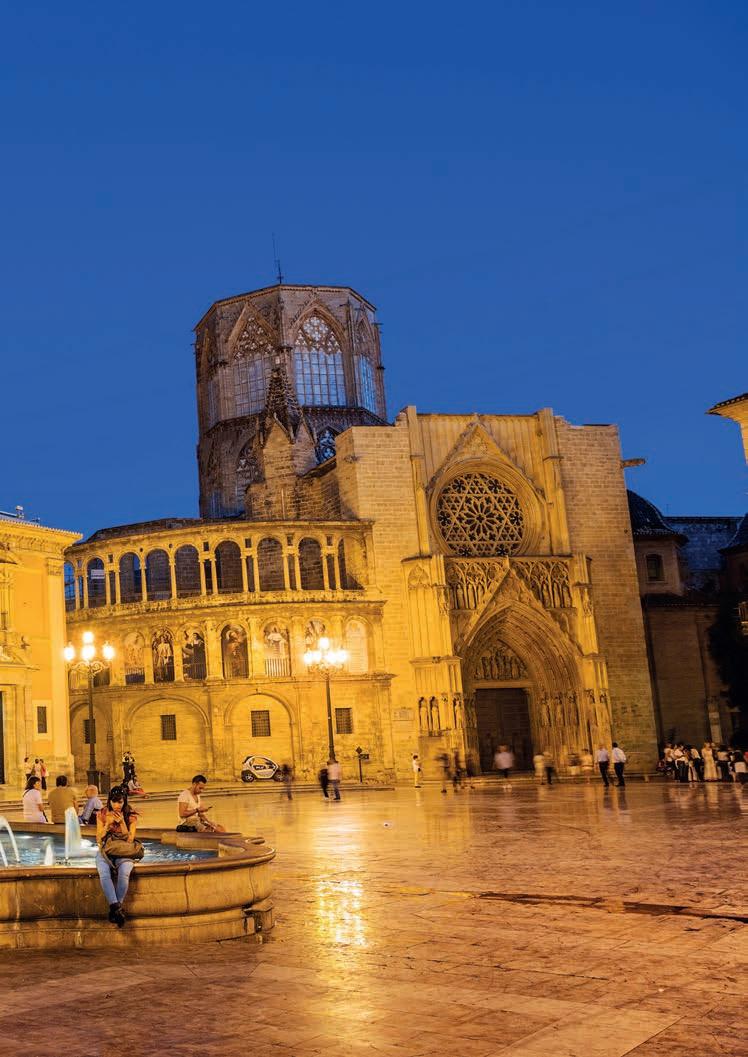
Past and present Valencia might be a forward-thinking city, but at its core lies a historical centre and traditions that date back centuries


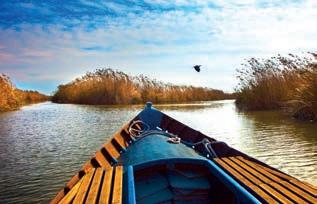

 City life (this page; clockwise from top left) The González Martí National Ceramics Museum is set within a glorious example of Valencia’s Baroque architecture; the wetlands of Albufera Natural Park lie just 10km from Valencia and are surrounded by rice fields and forests; Turia Garden weaves a lush trail through the city for 9km and across 18 bridges; settle down for some fine eating and people-watching in Plaza del Mercado, where you’ll also find the city’s largest food market; the futuristic City of Arts and Sciences takes the breath away; (right page; top to bottom) dazzling architecture and paella are just two of Valencia’s calling cards
City life (this page; clockwise from top left) The González Martí National Ceramics Museum is set within a glorious example of Valencia’s Baroque architecture; the wetlands of Albufera Natural Park lie just 10km from Valencia and are surrounded by rice fields and forests; Turia Garden weaves a lush trail through the city for 9km and across 18 bridges; settle down for some fine eating and people-watching in Plaza del Mercado, where you’ll also find the city’s largest food market; the futuristic City of Arts and Sciences takes the breath away; (right page; top to bottom) dazzling architecture and paella are just two of Valencia’s calling cards

Valencia is green by nature – and now also by title, crowned European Green Capital 2024. The seeds were sown when the Turia River was redirected around the city after a flood in 1957.Valencia’s citizens rejected the motorway proposed to run along the river’s former course, which was instead transformed into a 9km-long park, Turia Garden, now the city’s lungs.
Valencia has blended past and present with ease – for evidence, just gaze from the 14th-century Serranos Towers to the ultra-modern City of Arts and Sciences. Then there are the city’s profuse natural gifts. Nourished by the Mediterranean sun,Valencia is fringed by the sea, rice fields, orange groves and Albufera Natural Park, a protected area of coastal lagoon that hums with birdlife.
Experiencing these delights is now easier and more sustainable than ever, thanks to four Green Routes designed to showcase the Green Capital. One roams the 120ha expanse of the Turia Garden; the second explores the historic centre; the third uses bike or public transport to delve into Valencia’s fertile and beautiful hinterland.A fourth integrates highlights of the other three for a succinct introduction to this verdant city.
Valencia is undeniably spectacular.The futuristic City of Arts and Sciences transformed the urban skyline when it was completed in 2009, but this complex has substance to back up the flash.Within lies L’Umbracle, which houses plant species native toValencia; the Palau de les Arts Reina Sofía, an opera house and performing arts centre; and the Museu de les Ciències Príncipe Felipe, which offers an interactive take on a science museum.
This sense of discovery continues across the city squares. Near Plaza de la Reina lies the GothicValencia Cathedral, which is thought by some to be home to the real
Holy Grail, while the Plaza del Mercado is the setting forValencia’s bustling Art Nouveau food market. Even more invitingly, many of these plazas have been pedestrianised in recent years, making them more pleasant to stroll and helping lower emissions for the city.
Food miles are important here.Valencia has been the birthplace of several culinary gems, including paella.The local take includes

rabbit, chicken, veg and more, which would traditionally all have come from La Huerta (The Orchard), the vast belt of farmland that lies on the outskirts of the city. For many local restaurants today, this is still the case.
Valencia is also home to vibrant orange trees, so try sampling some freshly squeezed juice or Agua deValencia, a cocktail from the city that fuses fresh orange juice with Cava (plus gin and vodka for the more ambitious).
Learn about heritage crafts
Make the most of Valencia’s artisans. This is a city of crafts, and the small boutiques and ateliers are a link to its past. Ensedarte, for example, sells naturally dyed and handpainted silk garments that hark back to Valencia’s history as a key port on the Silk Route.
Elsewhere, the González Martí National Ceramics Museum is a great place to spend a few hours admiring porcelain and ceramic works, as well as other decorative arts such as textiles, furniture and traditional costumes.
Go boating on a wetland lagoon
Albufera Natural Park is a biodiversity treasure trove just 10km from the city centre.
Surrounded by rice paddies, this is where paella was born and adventures are found. Guided boat tours of the Albufera lagoon, the largest freshwater lagoon in Spain, reveal the depth of its diverse birdlife as well as the traditions of the local fishermen, who have worked in these waters for generations. Best seen at sunset, this park provides one final example of just why this city is so green.
It’s possible to fly directly to Valencia from London and Manchester airports. The flight takes 2 hours and 15 minutes from London. Valencia is just under two hours by train from Madrid, and about five hours by ferry to Ibiza
For accommodation, Hotel Puerta Serranos (doubles from £120pn) is a lovely boutique hotel that lies next to the Serranos Towers in the historic centre. Parador de El Saler (doubles from £175pn) is a splendid beachfront hotel set within Albufera Natural Park. The Valencia Tourist Card can be bought for 24, 48 or 72 hours (£13–21) and includes free entry to municipal museums and monuments, as well as free public transport around the city.
Valencia comes alive every March for its Fallas Festival, a celebration of the coming of spring involving fireworks, light shows, dancing and parades. UNESCO has declared this festival to be part of Spain’s Intangible Cultural Heritage, and locals painstakingly prepare the costumes, dresses and sculptures that are key to the festivities. The region has its own dialect, Valencian, which is similar to Catalan, but most people in the city will likely speak Spanish.

A forest that once had no trees is now the lush jewel of south-east Spain
Words by Xenia Taliotis
It’s hard to believe when standing among the dense greenery of Sierra Espuña Regional Park, in the cooling shadows of the towering ash, elm and Aleppo pines that shield visitors from the midday sun, that there was nothing but desert here just 135 years ago. Centuries of relentless logging, farming and mining had taken their toll, before a flood finally washed away what remained. This mix of human-caused destruction and natural disasters devastated this huge expanse of what had once been flourishing forest. What you will see today is very different.
“All of this amazing nature is young, and largely the work of one man: Ricardo Codorníu. We call him the ‘Tree Apostle’,” said local guide Carlos. “He is revered here, because without him there wouldn’t be any of what stretches out before us.”
When Codorníu, a forest engineer, visited in 1889, he documented the lamentable state of an area that sits on the eastern point of the Baetic mountain range, in the Murcia region of south-east Spain.
‘I climbed to the top of the snow-covered Morrón de Espuña, carrying out an inspection of the slopes of the Guadalentin River,’ Codorníu wrote in his diary on 19 March 1889. ‘In the descent, crossing the high basin of Espuña… I saw neither a single pine tree nor a single oak tree. I decided, therefore, that we had to re-forest everywhere.’
And re-forest he did. With the help of two associates, José Musso and Juan Ángel de Madariaga, he planted saplings and scattered seeds in that desolate landscape. He constructed paths and bridges, dykes and viewing points, cycling routes and trails. In total, the trio created an green oasis that now spans 17,000-plus hectares and sustains more then 15 million trees, leaving behind a year-round pleasure for all to enjoy, whatever your age or range of movement.
A local hero (left) At the end of the 19th century, the entire mountain range that makes up the modern-day Sierra Espuña Regional Park was in a terrible state. It took the intervention of forest engineer Ricardo Codorníu, who replanted the area, to turn it into the green wonderland that it is today
In greening the land, they also built an incredible environment for wildlife. Golden eagles, Eurasian jays, eagle owls and red crossbills are just some of the 123 bird species that share their home here with 500 species of butterfly, 19 types of bat and another 38 species of mammal – including the Espuña squirrel, red fox, wild boar, European wildcat and beech marten. In addition, the area has become a fertile habitat for close to 1,000 different plant species. Indeed, more than a third of the flora that’s found in the region grows here.
Visitors can hike, bike, climb, trail-run, paraglide, learn to make pottery or even cook in the park. Its centrepiece, however, is its 65km of official paths, many of which lead to the pozos de la nieve, a cluster of 16th-century ice houses that remained in use until ⊲




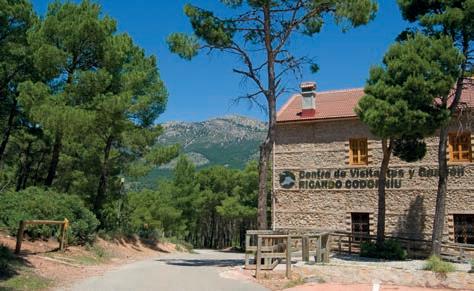
the arrival of electricity in the early 1900s. Others end at viewing points where natural wonders such as the lunar landscape of Barrancos de Gebas loom – a formation of ravines and canyons known as the Badland, which is at least 10 million years old.
Having worked up an appetite, visitors can try local specialities such as arroz a la leña (wood-fired Calasparra rice and vegetables) and mushroom croquettes at Rincon del Grillo restaurant, deep within Sierra Espuña, or rest up in the exquisite 12-bedroom Bajo el Cejo Hotel, which is built into a ravine filled with pomegranate and fig trees.
Like other hospitality businesses in the park, the food miles racked up by what they serve hover at around zero.
is a multi-faceted project that promotes the food, services and crafts produced by growers, restaurateurs, hoteliers and artisans from the six villages around the area – Aledo, Librilla,Totana, Mula, Pliego and Alhama.
“Sustainability protects our local traditions and foods, our architecture and history, and our landscape and environment,” says Juan Francisco Martinez Carrasco of Murcia’s Institute of Tourism.
“Pottery from Totana was first made some 2,000 years ago, with skills being passed down through the generations from then on”
Such success stories make Sierra Espuña – which was awarded regional park status in 1992 – not only one of the Murcia region’s most gorgeous places to while away several days, but also one of its most sustainable. It has even received accreditation from the EUROPARC Federation, which represents Europe’s protected areas and works to improve their management.
Among the park’s many achievements as an eco-tourism destination is the work being done to enrich the local communities.This is done through various initiatives, including Territorio Sierra Espuña, which
“It covers everything we want to retain, including our traditions, our culinary heritage and our crafts.The pottery from Totana, for instance, was first made some 2,000 years ago, with skills being passed down through the generations from then on.”
For extra enjoyment, as well as a taste of the cultural wealth of the region, try to time your visit with one of the local festivals. At Easter, during the Fiesta de la Noche de Los Tambores (the Night of the Drums), the streets of the town of Mula fill with thousands of drummers playing continuously from midnight on HolyTuesday to late afternoon the next day, with additional performances on Good Friday and Easter Day.
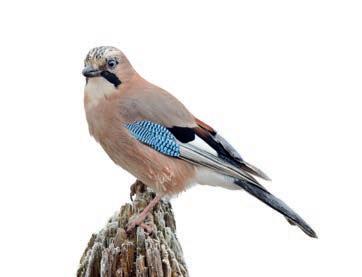
Lovers of ancient music should note the dates of the Festival Internacional de Música Antigua de Sierra Espuña, which always takes place in the summer, followed on the first weekend in August by the magical Noche en Vela (Sleepless Night) in Aledo,
during which the town is lit by thousands of candles. Booking is essential for this spectacle, as poets, musicians and dancers perform against a backdrop of candlelit houses, bustling restaurants, streets, squares and alleys in this ancient town.
But whatever your passion, whatever you choose to do here, you have Ricardo Codorníu to thank for turning the valleys and slopes of Sierra Espuña Regional Park into the lush wonderland that it still is today.
The Sierra Espuña Regional Park is located in the central part of the Murcia region, between the districts of Alhama de Murcia, Totana and Mula. You can fly direct to Murcia, the capital city of the Region of Murcia, from the UK, or take a train via Paris, Lyon, Barcelona and Madrid
A 50-minute drive east of Murcia, along the RM-2, will take you to Sierra Espuña Regional Park. Public transport is also available but will only take you part of the way – take the train from Murcia’s train station to Alhama de Murcia, then you will have to book a taxi. Once in the park, your first stop should be the Ricardo Codorníu Visitor Centre. There you’ll find lots of information about Sierra Espuña and the various activities you can do here. You can also pick up a map that will get you to the viewing platforms to soak up this magical green land.
 Sights from the saddle Various cycling routes offer diverse views of La Gomera, from road circuits to challenging mountain-bike trails in Garajonay National Park
Sights from the saddle Various cycling routes offer diverse views of La Gomera, from road circuits to challenging mountain-bike trails in Garajonay National Park
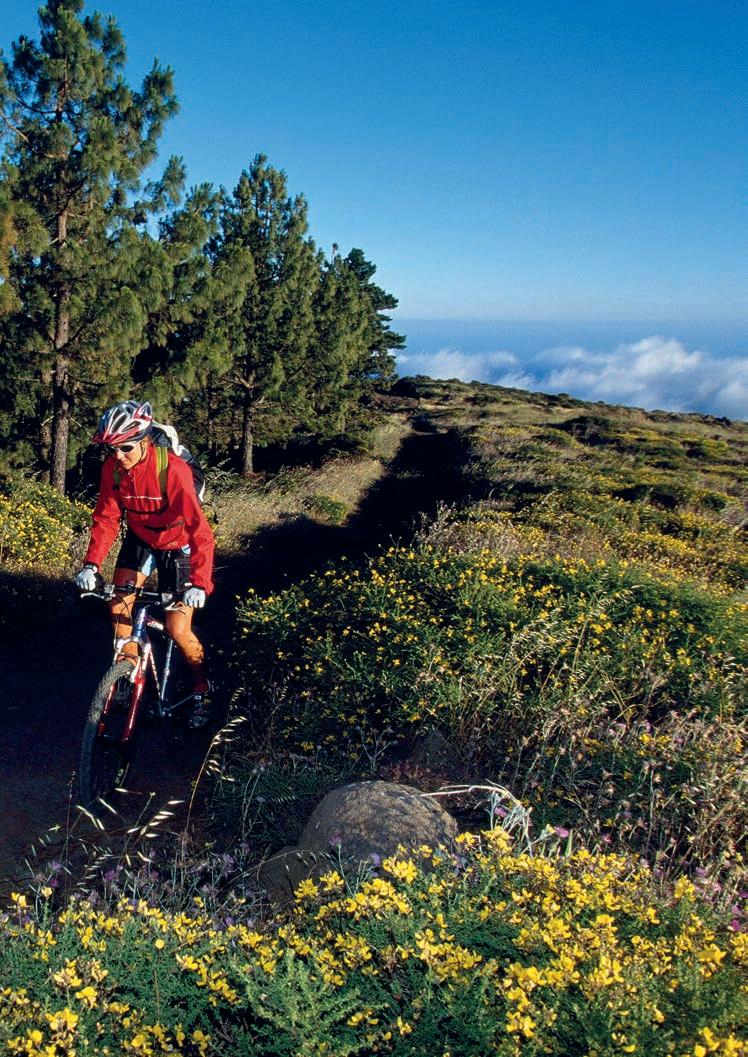
Get active on the trails, seas and cliffs of this lesser-known but spectacular Canary Island
Words by Ross Clarke

 Island of adventures (this page; clockwise from top left) Over 600km of walking trails criss-cross the island, offering outings ranging from easy strolls to longer, more testing routes such as the 12km Vallehermoso hike; scuba divers explore coral walls and spot whales, sharks and turtles around La Gomera’s shores; the tradition of leaping between ravines was practised by La Gomera’s pre-Hispanic Guanche inhabitants; (opposite page) look up when hiking on La Gomera and you’ll be rewarded with spectacular views, from craggy mountains to the canopy of Garajonay National Park’s laurel forest
Island of adventures (this page; clockwise from top left) Over 600km of walking trails criss-cross the island, offering outings ranging from easy strolls to longer, more testing routes such as the 12km Vallehermoso hike; scuba divers explore coral walls and spot whales, sharks and turtles around La Gomera’s shores; the tradition of leaping between ravines was practised by La Gomera’s pre-Hispanic Guanche inhabitants; (opposite page) look up when hiking on La Gomera and you’ll be rewarded with spectacular views, from craggy mountains to the canopy of Garajonay National Park’s laurel forest

Though one of the smaller Canary Islands, and often overlooked by sun-seekers in favour of its larger and betterknown siblings, La Gomera is no retiring wallflower. On the contrary: this rugged isle, lying some 30km west of Tenerife, lures active travellers seeking outdoor adventures away from the crowds. La Gomera boasts dense, ancient forests, dramatic volcanic landscapes and a storied history, having been Christopher Columbus’ last port of call before heading west on his first transatlantic expedition. No wonder its younger people, many of whom had been leaving the island to find jobs elsewhere, are now staying or returning to showcase La Gomera to active visitors keen to experience its great outdoors.
With over 600km of routes, ranging from beginner-friendly paths to challenging hikes, La Gomera is a tempting destination for anyone aiming to lace up those walking boots.The best-known trails lace Garajonay National Park, which stretches across the island’s mountainous centre. Here you’ll find precious surviving swathes of often misty laurisilva forest – living fossils of the lush rainforests that once covered much of Europe. Further north, a popular 12km circular walk around Vallehermoso delves into juniper groves and among a range of other plant species; watch for birds such as buzzards soaring overhead.
La Gomera is a favourite with cyclists of all levels; indeed, many top athletes come
here to train. Road cycling is popular, not least because the routes on La Gomera are never too busy with traffic. For beginners and those less confident about cycling solo, local companies such as Gomera Cycling & Walking offer guided excursions. This family-run outfit leads various small-group tours – both on and off road – that can be adapted to suit different experience levels, as well as providing bike hire and sales. For a gentle guided road circuit, try the SouthernVillages tour, a 45km loop rated ‘Easy’. gomeracycling.com
The waters around La Gomera are warm and clear, with visibility typically around 30m, so scuba diving is a delight year round. Spectacular dive sites include Playa de la Cueva, off the island’s easternmost tip, and Los Órganos, beneath those namesake basalt ‘organ pipes’ on the sea cliffs of the north coast, where you might spy whales, dolphins, rays and schools of barracuda. On any dive, it’s common to spot creatures including parrotfish, moray eels, lobsters and sea turtles. Book with a local outfit such as Splash Gomera to ensure your dive is both safe and sustainable. splashgomera.es
To admire dramatic cliffs and appreciate the island from a different perspective, rent kayaks to explore at sea level. La Gomera’s many sheltered bays range around the coast and ensure calm waters, so it’s an ideal family activity; favourite spots for beginners include Playa de Santiago, where Splash Gomera hires out kayaks and paddleboards. The waters around La Gomera are bustling
with loggerhead turtles, bottlenose dolphins and various whales – in fact, 23 of the world’s 90 or so cetacean species have been sighted in the strait betweenTenerife and La Gomera, Europe’s firstWhale Heritage Site.
Rock-climbing opportunities are mainly suitable for experienced enthusiasts.The most famous site is Roque Cano; climbing here requires permission from La Gomera government, in an effort to preserve the rock for future generations. Instead, why not try the Canarian pastime of leaping?The tradition of salto del pastor (shepherd’s leap) – a little like pole-vaulting using a long wooden asta or staff – was possibly developed by the islands’ pre-Hispanic Guanche inhabitants as a technique for crossing ravines.Try it yourself and help preserve this ancient activity. saltodelpastorcanario.org
When to go
Spring and autumn are the best seasons for hiking and active pursuits; summer can be very hot, though winter days can be great for walking.
Getting there
Fly with one of several airlines linking the UK with Tenerife South Airport (about four hours), then catch one of the frequent fast ferries sailing from Los Cristianos to San Sebastián de La Gomera (50 minutes).
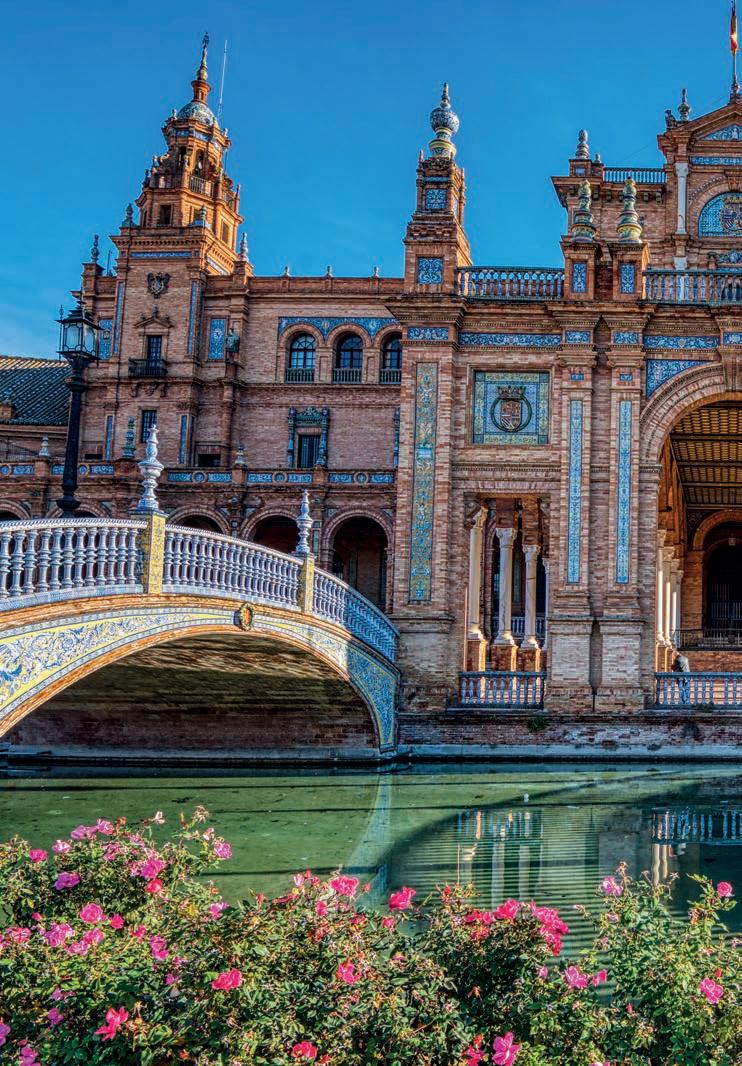
Spreading the love Seville’s showstopping Plaza de España was built in 1928 and combines several Spanish architectural styles, including Art Deco, Renaissance Revival, Baroque Revival and Neo-Mudéjar
Seville
Seville: a green guide to the city of oranges
Discover how this Andalusian city is prioritising ‘smart tourism’
Words by Eddi Fiegel


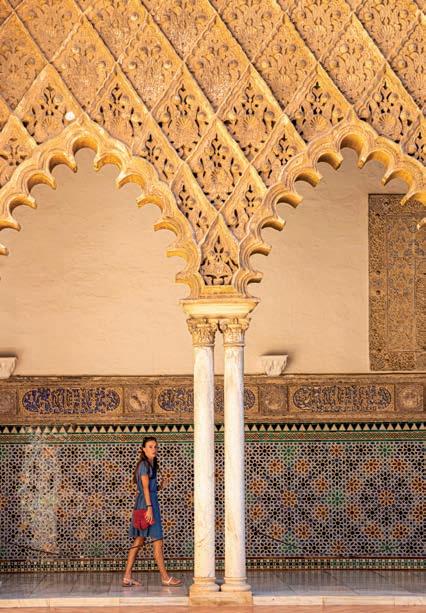
With its Moorish palaces, Baroque churches and orange tree-shaded plazas, all bathed in sultry, honeytoned sunlight, it’s no surprise that Seville is often called the ‘jewel of Andalusia’. But the capital of that southern region is not just a feast for the senses. It’s also at the forefront of responsible tourism in Spain. Jointly awarded the title of European Capital of Smart Tourism 2023, Seville is leading the way in using digital technology to counteract the impacts of climate change and improve visitors’ enjoyment of the city.
Seville is among the easiest Spanish cities to visit on foot, with most of its key sights within easy walking distance.The centre is dominated by the vast Gothic cathedral and its soar-
ing bell tower, the 12th-century Giralda, originally built as the minaret of the Great Mosque.The city’s Moorish heritage is also evident at the nearby Alcázar, the palace complex largely dating from the 14th century, with its fountain-cooled patios, filigreed stonework and superb ceramic tiling. Tempting food and drink are never far away.The narrow streets and alleys of the Barrio Santa Cruz, Seville’s old Jewish quarter, are lined with tapas bars offering ample options for cooling down with a refreshing manzanilla sherry or cold beer. For a spot of fresh air, wander among the majestic trees, ponds, pavilions and fountains of elegant María Luisa Park just to the south.

The city’s range of responsible tourism initiatives include the creation of 120km of cycle lanes and an extension of the city’s tram network, plus various smart tourism projects using digital technology.


One ‘smart’ scheme currently being piloted in the Barrio Santa Cruz measures the flow of tourists in the most-visited districts. If readings show that one area is getting overcrowded, tourists can be redirected to less-thronged parts of the city along alternative routes – one of many initiatives aiming to improve the experiences of visitors and residents alike.
Spring and autumn, when temperatures are balmy but not too hot, are the ideal seasons to visit. British Airways (britishairways.com), easyJet (easyjet.com), Ryanair (ryanair. com) and Vueling (vueling.com) fly to Seville from London and some other UK cities. Hotel rates soar during Semana Santa (Easter) and Feria de Sevilla (Seville Fair, two weeks later).


The visionary conservation of this wild region’s mountains, valleys, meadows, waterways and towns nurtures spectacular avian life – and avid birdwatchers
Words by Emerson Mendoza AyalaOSoaring species (this page; left–right) Griffon vultures are booming in Monfragüe National Park, where more than 600 pairs thrive amid the rocks and forests; spy Iberian magpies in Extremadura’s historic capital, Mérida, a rewarding destination for urban birdwatching
n the leafy slopes of Extremadura’s high mountains, in its glacial valleys through which crystalline rivers flow, and across its golden dehesas (wooded meadows) rolling on to the distant horizon, silence prevails. Despite its rich natural and cultural heritage, this kaleidoscopic region, nestled between the cork oak groves and vineyards of Portugal and the windmills of La Mancha, goes largely unnoticed – by humans, that is.
Seen through a bird’s eyes, though, the diverse landscapes and well-preserved ecosystems of Cáceres and Badajoz – Spain’s two largest provinces, which comprise Extremadura – are highly desirable for the 385 avian species recorded here. Indeed, the region has become a sanctuary for species rarely seen in the Iberian Peninsula, such as the Spanish imperial eagle, cinereous vulture, black stork and black-tailed godwit.
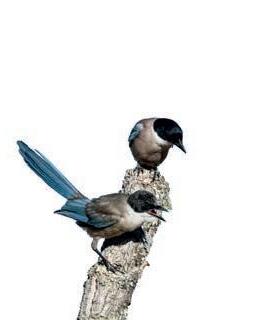
In Extremadura, protection of the natural environment is tightly linked to bird conservation. Almost 75% of its territory is classified as Important Bird Areas, including 71 Special Protection Areas for birds (SPAs) covering over 26% of the region.
habitats in Extremadura. For example, the LIFE Iberian Agrosteppes project succeeded in bringing together nature conservationists, livestock breeders and farmers to safeguard steppe birds. More work is needed, though, particularly for species dependent on agricultural environments. In recent years, little bustard numbers have declined by over 60% in La Serena and Sierras Periféricas, Extremadura’s largest SPA.
Already, though, the region has led the way in protecting various bird habitats. Recognising that some species now prefer to nest in human constructions – cathedrals and churches, or spaces in other buildings – Extremadura became the first European region to designate as SPAs several of its urban centres hosting nesting colonies of lesser kestrel, one of Spain’s smallest breeding birds of prey.
Add the Villuercas-Ibores-Jara UNESCO Global Geopark, three Biosphere Reserves – Monfragüe, Tajo Internacional and La Siberia – and the Protected Landscapes of Monte Valcorchero and Castañar Gallego, and it’s clear why Extremadura is the birding paradise of southern Europe.
Extremadura’s best birding spots
In addition, EU-financed nature conservation and management projects of the LIFE Programme have contributed to the recovery of various endangered bird species in the Iberian Peninsula by improving their ⊲
Venture into the dense chestnut and oak forests among the southern foothills of the imposing Sierra de Gredos, in Extremadura’s far north-east, and you’ll be serenaded by the murmur of water and the




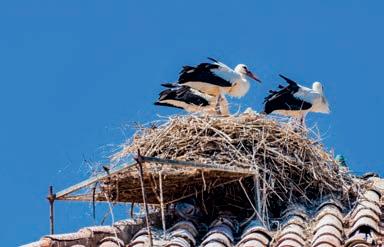

whisper of wind through the treetops mingling with the melodious songs of blackcaps, chiffchaffs and nuthatches. Descend from those picturesque highlands into the valleys of La Vera, Jerte and Ambroz to hear the calls of bluethroats and golden orioles (so rarely seen in the UK), and to spot goshawks, European honey-buzzards, Thekla’s larks and great cormorants.
Around Plasencia, further to the south, you might spot vultures, buzzards and eagles flying over the area’s characteristic cork oaks and glittering granite formations.This is where I grew up, and I remember with nostalgia the croaking of the graceful white storks perched on their nests in the cathedral complex, and the swooping flight of lesser kestrels above the Plaza de San Vicente Ferrer.
The Tagus River snakes around the rocky outcrops of Monfragüe National Park, some 30km south of Plasencia. Standing at the lofty Salto del Gitano lookout in the far west of the park, you might spot Egyptian and griffon vultures, red kites and eagle owls soaring over the Peña Falcón crag.The sight of these majestic birds of prey circling above the 300m cliff, or perching to feed their chicks, is one of Extremadura’s most unforgettable images.
When to go
Birdwatching in Extremadura is wonderful at any time of year. Mid-autumn to late winter is the best period to see most of the resident and wintering birds, including impressive flocks of egrets and cranes feeding and relaxing in the dehesas.
The UNESCO World Heritage-listed Old Town of Cáceres makes a memorable base from which to head out birding in the surrounding plains, known as the Llanos de Cáceres, and across the wider province.

“Be serenaded by the murmur of water and the whisper of wind through the treetops mingling with the melodious songs of blackcaps and chiffchaffs”
La Siberia Biosphere Reserve, in north-east Badajoz province, encompasses vast steppes, dehesas, mountains, Mediterranean forest and irrigated areas. It also features five reservoirs, including La Serena – Spain’s largest – and Orellana, a Ramsar site hosting a large colony of gull-billed tern and an estimated 65,000 wintering waterfowl each year. Despite gradual changes in Extremadura’s steppe systems, they remain refuges for pin-tailed and black-bellied sandgrouse, singing calandra larks, nightjars, stone-curlews and bombastic great bustards.
Extremadura Birdwatching Fair is held in Monfragüe National Park each February. At the most important ornithological tourism fair in southern Europe, you can take guided tours, attend talks from specialists and enjoy creative workshops focused on bird conservation. fioextremadura.es/inicio-english/
Getting there & around Cáceres, Plasencia, Mérida and Badajoz are all accessible by bus or train from Madrid. Buses also run direct from Lisbon to Badajoz, Mérida and Cáceres.
Travelling by public transport from cities to villages can be challenging. Ask at bus stations or tourist offices for local timetables, or check the websites of regional transport companies such as Cevesa (cevesa.es) and Leda (leda. es); another handy website providing information on multiple transport providers is movelia.es/en. Carry cash to pay for services.
Events
Come in spring or summer to enjoy diverse local festivals celebrating the history, culture and exuberant nature of Extremadura.
Just east of Monfragüe National Park stretches the Arrocampo reservoir, created in the late 1980s to provide cooling water. It now hosts numerous species that relish its warm waters and nest among its abundant bulrushes. It’s home to Extremadura’s largest populations of purple swamphen, black-crowned night heron and purple heron – indeed, eight species of heron nest here.
Mérida – another city boasting World Heritage-listed archaeological sites – is considered one of Spain’s finest settings for urban birding. From the Roman Bridge over the Guadiana River you can watch swallows, penduline tits, European bee-eaters, blackwinged kites, and graceful Iberian magpies flying over the ninth-century Moorish Alcazaba.The capital of Extremadura is also a fine base for exploring the ancient Roman reservoirs of Proserpina and Cornalvo or the rocky Sierra Grande de Hornachos mountains, and for birdwatching in Zafra and quaint villages among the vineyards and olive groves towards the Andalusian border.
The Cherry Blossom Festival, held in the villages of the Jerte Valley from late March to early April, marks the arrival of these delicate blooms with exhibitions, medieval markets, openair celebrations and tasting sessions. turismovalledeljerte.com
Martes Mayor, held in Plasencia on the first Tuesday in August, reputedly dates back to the 12th century. Celebrations begin on the Monday night with parades and music. Then, on the Tuesday, the walled centre is transformed into a boisterous medieval market showcasing the best of the area’s local produce, particularly vegetables and fruits, while locals dance to the music of the flute and the tambourine.





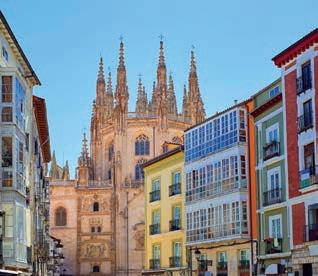

If mushrooms and truffles tickle your taste buds, head to Spain’s largest region to discover its earthy culinary delightsWords by Isabelle Kliger
Heard of mycology tourism?
No?You’re not alone. But as we seek more sustainable ways to see the world, including travelling off season and minimising negative impacts on the planet and local communities, the time is ripe to start planning your first mushroom-foraging trip.
Mycology tourism offers an unbeatable combination of culture, fresh air, nature immersion and local gastronomy. Put simply, it is travel dedicated to searching for and collecting wild edible mushrooms – then, ideally, savouring them in a delicious meal. When undertaken responsibly, preferably guided by an experienced forager, picking wild mushrooms has been shown to support biodiversity in forests and promote the growth of a variety of plants and fungi.
Eating mushrooms is good for you, too.

Edible fungi are low in calories, boost the immune system, contain anti-inflammatory compounds and are packed with vitamins and minerals such as selenium, zinc and vitamin B6.
Castile and León, north-west of Madrid, boasts the largest expanse of forest cover of any region in the country. It’s home to about 5 million hectares of forest, within which some 2,700 species of wild mushroom grow; of these, about 50 are sold commercially.The region also boasts large areas of planted black truffles. A more recent addition to the mycology ecosystem is the first-ever Castile and León black truffle market, which is held on Thursdays in Soria – where some of the world’s most sought-after black truffles grow.The market is creating plenty of buzz during truffle season, and generating considerable economic benefit for local growers.
Many wild mushrooms can be picked almost all year round, but autumn – the months of October and November, in particular – are when most foragers can be spotted filling their baskets to the brim with local varieties such as chanterelles and oyster mushrooms.
dense pine forests studded with chanterelles. Vibrant yellow in colour, these small but tasty specimens are even more prevalent further north. In the towns of Viana de Cega and Boecillo, nearValladolid, you can attend the annual Festival of Exaltation of the Chanterelle; activities include cooking workshops and mushroom-picking outings with professional foragers.
For two weeks from late October into early November, many restaurants across Castile and León participate in the Buscasetas (mushroom-hunting) Gastro-Mycological Days event.These venues develop individual tapas and full menus based on locally foraged mushrooms. Clearly, mycology tourism is not just good for you and the planet – your taste buds will thank you, too. buscasetas-es
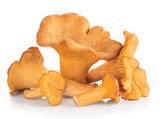
A top spot for mushroom-hunters is Las Quilamas nature area in the Sierra de Francia mountain range south of Salamanca, its

Direct trains (renfe.com) and buses (alsa.es) take under three hours to reach Soria from Madrid.
A permit is required to pick mushrooms in Spain, so make sure to do your research. The Montes de Soria Association is a non-profit body dedicated to the management of nearly 164,000 hectares of mushroom-producing forests in the northern provinces of Soria and Burgos. On its excellent website (asociacionmontesdesoria.com), which features an English-language translation, you can apply for your permit online as well as finding maps and information about local mycology events and activities.

The long view Visiting Spanish National Parks such as Aigüestortes i Estany Sant Maurici doesn’t just offer a great day out –it brings money and jobs to the surrounding rural communities

How visiting Catalonia’s natural parks benefits local communities
Glimpse wildlife, history and wilderness while bringing income and jobs to rural Catalonia by exploring its parks
Words by Esme Fox

Tucked into the north-eastern corner of Spain sits the region of Catalonia, bordered by the Pyrenees,Andorra and France to the north, Aragon to the west and the Mediterranean to the east.While most travellers are well acquainted with the touristic hubs of Barcelona, Girona and the Costa Daurada, it’s the region’s interior and natural side that foreign visitors have yet to discover.
A total of 32% of Catalonia is protected. It’s home to 13 natural parks and one national park, all spread over the four provinces of Girona, Tarragona, Lleida and Barcelona. Landscapes range from wetland river estuaries and craggy coastal bays to towering peaks and glacial lakes.The majority of its parks, however, are within the Pyrenees, a vast wilderness where rugged mountaintops punctuate verdant valleys, and freshwater streams flow freely. It’s also where you’ll find the majority of Catalonia’s wildlife, including brown bears, wild boars, mountain goats, deer, lynx and birds of prey such as vultures and eagles. In total, 330 bird species call this region home – more than half of those that exist in the whole of Spain.
What’s unique about Catalonia’s parks is that they don’t only celebrate the natural world, but also embrace historical and architectural elements too.They’re strewn with vestiges of the past, including grand monasteries, Romanesque architecture,
medieval villages, archaeological ruins and even prehistoric sites.
Each park offers a slightly different experience, coupled with trails that span different lengths and terrains. But you don’t have to be an experienced hiker to enjoy them; you can get taste of the Spanish wilderness in only a few hours. Best of all, just by visiting these areas you can help out local communities.
The Fem Parc Project was designed to promote ecotourism within Catalonia’s natural parks at the same time as stimulating the local economy. It does this by encouraging residents in and around the parks to embrace their setting by developing offerings for tourists, thus creating new jobs.
The project is encouraging visitors to rural areas, drawing them away from busier places like Barcelona. By providing them opportunities for trekking, wildlife spotting, wine excursions, olive oil tastings, gastronomy tours and cultural visits, the money that brings in can in turn help support rural communities.
Many of Catalonia’s natural parks sit within areas of rich gastronomical heritage, adding another layer to the types of tour on offer here. For example, Urgell and Cerdanya cheeses come from the region around Parc Natural del Cadí-Moixeró and have a protected designation of origin (DO), while Montsant and Priorat DO wines come from the
vineyards around Parc Natural de la Serra de Montsant.
The money from these tours and activities is then ploughed back into the local economy. In addition, 5% from any Fem Parc tour goes towards local conservation projects, such as reintroducing endangered species, replanting and water preservation. The following are just a few parks in which you can both explore and give back…
Parc Natural de I’Alt Pirineu
Sitting to the west of Andorra, just below the French border, Alt Pirineu is the largest natural park in Catalonia, spanning over 80,000 hectares and filled with bottle-green valleys, fresh mountain lakes and forestclad peaks. Among these is theVirós Forest, which is among the most extensive and important wilderness areas in Catalonia. Roe and fallow deer stalk its meadows; vultures, buzzards and golden eagles soar overhead.
The park is home to the highest peak in Catalonia – Pica d’Estats (3,143m) – and has a rich archaeological and architectural heritage.There is evidence here of pastoral activity ranging from the Neolithic period to the Middle Ages, as well as Ibero-Roman mines and ancient dolmens.The park has a great religious significance, ⊲
 Parc life (leftÐright) Visitors cross the bridge over the river Fluvia and head into the medieval village of Besalú, one of many small communities on the fringes of Volcànica de la Garrotxa park that you should visit while in the area; Aigüestortes i Estany de Sant Maurici park is filled with towering peaks topping 3,000m; the Escaladei Monastery offers a glimpse of a unique history; the rare bearded vulture is making a comeback in the skies above Cadí-Moixeró park
Parc life (leftÐright) Visitors cross the bridge over the river Fluvia and head into the medieval village of Besalú, one of many small communities on the fringes of Volcànica de la Garrotxa park that you should visit while in the area; Aigüestortes i Estany de Sant Maurici park is filled with towering peaks topping 3,000m; the Escaladei Monastery offers a glimpse of a unique history; the rare bearded vulture is making a comeback in the skies above Cadí-Moixeró park







too, and it is dotted with houses of worship such as the sanctuary of Arboló, the church of Santa Maria d’Àneu and the hermitage of Santa Magdalena.The area also saw intense activity during and after the Spanish CivilWar, leaving behind several bunkers to explore.
Parc Nacional d’Aigüestortes i Estany de Sant Maurici
Aigüestortes i Estany de Sant Maurici is Catalonia’s only National Park. Set within the north-western corner of the region, deep in the Pyrenees, its snow-capped, sky-high crests rise to more than 3,000 metres against a backdrop of emerald-coloured valleys.
Water is an integral part of the park, which is veined with rivers, waterfalls, ponds, glacial valleys and almost 200 lakes. The most remarkable of these is Lake Sant Maurici (after which the park is named), whose glassy waters reflect the mountainous surrounds. It’s a popular spot for adventure sports, with trails set aside for hiking, mountain biking, mountaineering, and skiing in the winter.
Parc Natural del Cadí-Moixeró
Lying south-east of Andorra, Cadí-Moixeró is named after the two mountain ranges it spans.These twin chains are joined by the Tancalaporta pass, which divides the Pre-Pyrenees and the Pyrenees. It’s a glorious patchwork of valleys and summits, with peaks rising to 2,500m high. Scattered in between lie several medieval villages filled with traditional Pyrenean architecture, including the 11th-century Benedictine monastery of Sant Llorenç del Munt, near Bagà. Elsewhere, chamois and red deer clamber the slopes and bearded vultures – one of the rarest birds of prey in Europe – can be spotted overhead.
Parc Natural de la Zona Volcànica de la Garrotxa
North-west of Girona lies the otherworldly landscape of the Zona Volcànica de la
Garrotxa, set within an ancient volcanic landscape. Some 40 volcanic cones rise majestically across the park, each carpeted in oak forests and interspersed by over 20 basaltic lava flows.There are several signposted walking routes of varying length throughout, and it’s even possible to hike to the top of the Croscat Volcano (786m).
Surrounding the park are three fascinating towns to visit: Olot, which has four volcanoes of its own; medieval Besalú and its fairy-tale bridge; and Banyoles with its gorgeous swimming and boating lake. This region even has its own volcanic cuisine, which includes interesting ingredients such as cornmeal porridge, purple potatoes, white corn, truffles, the local piumoc dried sausage, sheep’s milk cheeses and buckwheat.
In the south-western corner of Catalonia, bordering the regions of Aragón and Valencia, the Parc Natural dels Ports extends across 35,000 hectares. Across its wild landscape rises craggy massifs that tower between wild pine forests and serene oak groves.
Vultures, Iberian lynx and golden eagles are just some of the fauna that call this park home. It also has one of Spain’s most important populations of Iberian ibex, which are more typically known locally as ‘Spanish wild goats’.Their long, curled horns make them a majestic sight for wildlife watchers.
Because of its landscape of limestone caves, ravines and cliffs, the park is also notable for its array of adventure sports, ranging from rock climbing to caving and canyoning.
In the rocky terrain north-west of Tarragona lies the Parc Natural de la Serra de Montsant, dominated by the Montsant mountain range and located in the area of Priorat. It’s characterised by bizarre rock formations that stack
themselves like pancakes and reach high above the clouds.These are interspersed by towering rock walls, dramatic ravines and gorges. One of the most striking sights here is the Fraguerau Gorge, where the Montsant River has cut a deep gash through the rock.
Throughout history, humanity has found Montsant to be a spiritual place. A monastery and dozens of hermitages have been built here, with the most famous of these being the 12th-century hermitage of Sant Bartomeu and the Carthusian Monastery of Escaladei – the first monastery of the Sant Bruno order in Spain.Visitors can still walk around the latter’s tranquil cloisters and see where the monks used to live.
Besides its spiritual links, Montsant is known for both its wildlife and its wines. Keep a look out for the endangered Hermann’s tortoise, a startling black-and-yellow Mediterranean tortoise. Meanwhile, a tour of the local bodegas or vineyards – home of the DO wines Montsant and Priorat – could easily be paired with a natural park visit. Or just grab a glass at the end of your hike and relax.
From the UK, you can fly direct to Barcelona El Prat or Girona airports. Figueres, Girona and Barcelona are also connected by high-speed train from Paris, in under 7 hours. You can also take a train up to Girona from Barcelona (which takes roughly 40 minutes) and then hire a car from there if you’re heading to the Pyrenees. Late spring, summer and autumn are the best times to visit Catalonia, with winter and early spring seeing plenty of snow. Although summer is high season in Barcelona and along the coast, the natural parks are still quiet and make for the perfect places to escape the intense heat in the cities. Catalan is the co-official language in Catalonia, along with Spanish. Most locals also speak Spanish, but Catalan may be more prevalent in Pyrenean villages and rural communities. If your trip coincides with the summer solstice and surrounding dates (mid- to end of June), check out the region’s Fallas del Pirineo festivities, which are inscribed on UNESCO’s list of Intangible Cultural Heritage. In Catalonia, this festival is celebrated particularly around the regions of Alta Ribagorza, Berguedá, Pallars Jussà, Pallars Sobirá and Val d’Aran.

The statue of Christ has kept watch over the old town
since the 1940s, though the city’s history stretches back much further –and is being preserved through restoration work
of Tudela
Explore the local flavours, cultural traditions and historic architecture of this regal region
Words by Marti Buckley Navarre
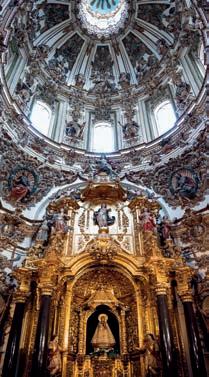



To find many of Spain’s most fascinating cultural gems, you’ll need to look beyond major cities such as Barcelona and Madrid.Turn your gaze to Navarre, abutting the Pyrenees and Basque Country to the north. Long a kingdom whose monarchs were major players in Spain’s story, Navarre boasts well-preserved historical sites, vibrant festivals and a push for agricultural renewal, with a focus on zero-kilometre eating and winemaking. No wonder Navarre is a hotspot for sustainable tourism, a land brimming with restored cultural landmarks, culinary traditions and inspiring agrotourism stories.
For centuries, Tudela – now Navarre’s second city, in the far south – was a cultural hub linking the Castilian plains and France, across the Pyrenees to the north-east.Today, a stroll through its streets, lined with wellrestored historical buildings and monuments, is a journey back in time. At the entrance to the city, the medieval stone bridge over the Ebro River reflects Tudela’s legacy as a cultural melting pot. Combining Muslim, Jewish and Christian influences, the 360m-long span features 17 arches and offers dramatic views across the river to the city and the distinctive towers of the Cathedral of Santa María. But the city is very much forward-looking.
One such place is Plaza de los Fueros, the central square built in 1687 to serve as a bullring but which now houses a bandstand instead. Among its grand façades looms the Clock House, a more ornate structure built for government officials to watch the bullfights. During Easter week, visitors here can watch El Volatín, a wooden puppet with a firecracker cigar placed in his mouth, be mocked by the crowds before he goes up in flames and disintegrates.That’s followed on Easter Sunday by the Descent of the Angel, a more solemn affair marking the resurrection of Christ.
Investment in restoring and conserving Tudela’s historic monuments has made the town a paragon of cultural heritage, supporting the local economy and delighting residents and visitors alike.

prized white asparagus. Indeed, Navarre has 15 products with Protected Designation of Origin (PDO), including asparagus, ruby red piquillo peppers and artichokes.
In the Ribera area – the fertile lands flanking the Ebro – you can help out on farms growing these prized vegetables.The Vegetable Festival, held from mid-April to the start of May each year in Tudela and the Ribera, features tastings of local products and cookery workshops, plus traditional Basque handball games and cultural events.
In the heart of Tudela, Trinquete is one of the city’s best-known restaurants. Diners can see the gardens where chef Santi Cordón cultivates vegetables for the restaurant, defining slow food for a town that champions local ingredients. Santi’s MascotasVerdes Foundation also takes children to the farm and shows them how to harvest and cook vegetables.
Navarre is prized for its red and rosé wines, traditionally made with grape varieties including tempranillo, garnacha and viura. Navarre’s Denominación de Origen is one of the oldest in Spain, dating back to 1933.To sample the finest drops, trace the wine route through the heart of the region between Pamplona and Tudela. Along the way you can stop at numerous bodegas, ranging from traditional, familyrun spots to modern wineries with cathedrallike underground barrel rooms.
Perhaps more than any other part of Spain, Navarre is renowned for the vegetables that power its traditional cuisine, from menestra (vegetable stew) to the

Much wine production in Navarre has developed in harmony with its surroundings, embracing the efficient use of water, biodynamic methods and renewable energy. Whole communities based on winemaking contribute to the local economy; these also offer visitors the chance to participate in a sustainable industry with far-reaching benefits.
Tradition reigns in the region, clearly, but there is also plenty of innovation, as you’ll discover while exploring wine and the customs behind its production in Navarre. One groundbreaking winery is family-run Quaderna Vía, based at a vineyard surrounded by forests and scrub southwest of Pamplona. Raúl and Jorge Ripa, who launched their first organic wine in 1998, are now recognised as pioneers. Their agroecological approach helps preserve the natural habitat and promotes biodiversity in their vineyards.While away the morning among the vines before enjoying a tasting of three organic wines, served alongside local meats and cheeses. quadernavia.com/en
Average temperatures plummet to 2ºC in winter and soar to 28ºC in summer when crowds build, particularly during Pamplona’s San Fermín festival. The north tends to be cooler and rainier, while the region near the Ebro River in the south has a hotter microclimate.
San Fermín festivals are held 6–14 July in Pamplona – known for the running of the bulls – and 7 July in Lesaka.
Getting there & around
Pamplona Airport currently receives no direct flights from the UK, but several connections daily from Madrid. Bilbao and Biarritz Airports are both under two hours’ drive from Pamplona.
Language
Basque is spoken throughout the northern half of the region, less so south of Pamplona.

A slow-travel guide to Menorca
Dial down the pace to explore this Balearic island’s rugged landscapes and long, rich history
Words by Donna Richardson
Seemingly the calmest of all the Balearic Islands, Menorca is the ideal slow-travel destination, where visitors quickly sync to the relaxed pace of life. But don’t mistake the chilled-out atmosphere for indolence: the island has been a UNESCO Biosphere Reserve since 1993, testament to the efforts made by locals to conserve their cultural heritage and the biodiversity of land and sea.
That commitment to sustainability is reflected in the restoration of the Camí de Cavalls – the ancient ‘horse path’ that runs right around the island. But though you should certainly take time to explore the beautiful coastline, with its rust-red and white beaches, golden coves and sapphire waters, don’t neglect the interior. Here you can roam rolling hills and forests, quaint hilltop villages and fascinating historic sites. Without the large-scale package tourism embraced by parts of neighbouring islands, in Menorca travellers can absorb the rich local culture and scenic splendour in peace.
Take the plunge to clean the sea
The clear waters surrounding Menorca are a scuba-divers’ dream, with an abundance of corals, arches, caves and crevices to explore. But these seas need protecting – and during dive excursions with the nonprofit movement 0 Plastic Menorca, volunteers remove discarded plastic from around the coastline, cleaning the environment for marine
life. Previous outings collected 50,000 microplastic fragments and over two tonnes of plastic. Efforts continue on land, encouraging changes in behaviour – reducing the use of plastics, especially single-use, or refusing them altogether – organising beach cleans involving young people, and promoting conscious and responsible tourism. The annual plastic-collecting dive excursions depart from Port Mahón, visiting Illa de l’Aire and Cala Rafalet to the south. The movement is a member of the Plastic Free Menorca Alliance, which aims for the island to be plastic-free by 2030. 0plastic.es
Hike the restored Camí de Cavalls
The origins of this ancient path can be traced back to the Middle Ages, when the knights of Menorca were ordered to patrol the coast. That practice was continued by French and British soldiers during occupations across the following centuries. Over the years, parts of the trail then became privatised, inaccessible and, in parts, began to disappear. Fortunately, following government-backed restoration, the full 185km route reopened, allowing hikers, cyclists and horseriders to circumnavigate the entire island. Divided into 20 shorter sections, the trail has boosted the economy of local communities by dispersing tourism across many remote areas. The shortest stretch runs along the north coast from Cala Morell to Algaiarens, a spectacular 5.4km walk beginning at Cala Morell’s prehistoric



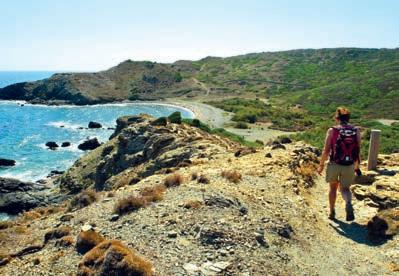

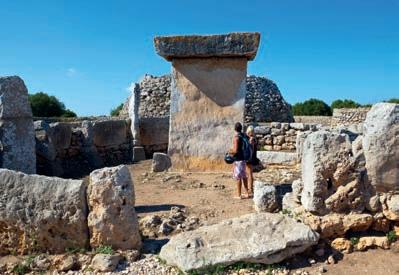
necropolis and ending at the twin goldensand beaches of Platja desTancat and Platja des Bot at Algaiarens. En route, you’ll pass several alluring bays including Codolar de Biniatram and Cala Fontanelles.The longest section winds some 13.5km from Favàritx, its rocky promontory sporting a namesake lighthouse, via pastures and fields to finish at the glorious beach of Arenal d’en Castell. camidecavalls.com
As well as the Camí de Cavalls, a thrilling ride for mountain-bikers, Menorca has a tantalising range of cycling routes tracing the coast and venturing into woodlands, farmlands and coves. One challenging 40km route loops from the central towns of Ferreries and Es Mercadal to the island’s northernmost tip and its oldest lighthouse, Far de Cavalleria.
Pedalling the island’s south-east, you’ll find pristine coves, prehistoric monuments and intriguing settlements such as E Castell and Sant Lluís, linked by an easy 6km ride. Founded by the British in 1771, Es Castell – which guards access to Mahón harbour – was originally called Georgetown after King George III. Sant Lluís, meanwhile, is a picture-perfect traditional Menorcan town with quaint shops and whitewashed houses. Another route rich in history loops south from Trepucó, on Mahón’s southern outskirts, to Mirador de Punta Prima on the island’s southernmost tip. Start from Poblado Talayótico de Trepucó, a Bronze Age settlement home to two conical megalithic talayots (watchtowers) and a tall, T-shaped altar known as a taula. Menorca’s Talayotic culture has now been recognised as a UNESCO World Heritage Site.
No visit to Menorca would be complete without mounting a horse – specifically the indigenous Cavali Menorquí breed, perfectly suited to exploring the various trails and beaches. There are plenty of options, many offered by specialist tour company Menorca a Cavall. For beginners, the scenic ride along Cala Mitjana is a great introduction – a 90-minute outing visiting one of the world’s finest beaches. A longer route visits Cala Fustam.
Experienced riders can enjoy a full day heading to Cala Binigaus, a long, unspoilt beach on the southern coast, saddling up at the company’s farm base, close to the Barranc deTrebalúger, then taking wooded trails that lead to the coast and onto beautiful beaches at Trebalúger, Escorxada, Binigaus, Sant Tomàs and San Adeodato. menorcaacavall.com/en
Historic attractions (this page; top–bottom) The Camí de Cavalls trail around Menorca, established in the Middle Ages to enable knights to patrol the coast, now provides wonderful walking; a statue of Christ watches from the 358m-high peak of El Toro, loftiest point on the island; discover ancient Talayotic structures including altars and watchtowers dating back to the Bronze AgeMahón, with its blend of Spanish and British influences, is a vibrant city on one of the world’s largest natural harbours. To start your journey back in time, head for Fortaleza Isabel II, the castle also known as La Mola, built between 1850 and 1875 during the reign of that namesake Spanish queen on the site of an earlier British fortress. From here, delve into the labyrinth streets, admiring their Georgian architecture and traditional houses. Here you’ll fine stylish boutiques selling avarcas, simple leather sandals typical of Menorca.
Head west right across the island to explore Ciutadella, the second city and Menorca’s capital until the arrival of the British. It’s nicknamed Vella i Bella – the ‘old and beautiful’ – and no wonder, with its honey-hued sandstone homes.The port is lined with traditional shops, bars and restaurants, while the main square, Plaça des Born, is surrounded by historic buildings dating back to the 17th century, such as Palacio Salort and Casa Olivar. Nearby stands the squat, imposing cathedral, with its impressive Baroque façade, and the cool cloisters of Museum Convent de Sant Agustí. For a glimpse of old Menorca, visit the former fishing village of Fornells in the north, now a popular stop-off for sailors.
Mediterranean flavours dominate Menorcan cuisine, but the island’s diverse legacy is reflected in Moorish, French and British flavours, too.The signature dish is caldera de llagosta, a rich soup made with red lobster. Venture inland to traditional villages and you might be offered warming meals of rice, marinated chunks of lamb and slow-cooked aubergine stuffed with meat. Another delicacy is snails with spider crabs – a dish with clear French influences.
Menorca is blessed with an abundance of figs. Cheese production on here dates from at least the fifth century; the medium-hard white Mahón variety is buttery, slightly salty and a little nutty. Another treat to look out for is coco bamba, a spiral brioche-like cake dusted with sugar.
In Mahón, foodies should head to the Art Deco fish market, try roadside tapas and sample the menus of the various seafood restaurants overlooking the harbour. Menorca is also reputedly the birthplace of mayonnaise – or Mahonesa – the egg-based sauce carried back to Europe in the 18th century by French settlers. Toast your gastronomic tour with Mahón Gin, made in the Xoriguer distillery.

glories Boats bob at anchor in the port of Ciutadella, which served as Menorca’s
restaurants, earning it the affectionate nickname Vella i Bella – the
Menorca’s landscape is in turns rugged and untamed, bucolic and serene. Away from the cherished coastal paths, hikers venture inland to roam the island’s verdant forests and trails. In the north-east, nature-lovers watch for fish eagles and coots on the lagoon at the Parc Natural S’Albufera des Grau, where you might even spot a tortoise. In the heart of the island’s largest gorge, Barranc d’Algendar, stroll between moss-clad rocks, sheer stone walls and wild olive trees along the Pas d’en Revull near Ferreries.
The highest point on the island is El Toro (‘The Bull’), soaring to 358m and topped by a statue of Christ at LaVirgen delToro, from where dramatic views stretch across to neighbouring Mallorca. Far below, an intricate network of caves runs beneath the island and into the sea.The largest is the Cova des Coloms, a subterranean ‘cathedral’ accessed via a 2km walk from Es Migjorn Gran in the central south. Further south-east, around Calescoves, prehistoric tombs are set into rocky ravines, one dating back some three and a half millennia; follow signs painted on the rocks to reach this ancient necropolis. Finally, early risers head to La Mola, the most easterly point in Menorca – indeed, in the Balearic Islands –to witness the first sunrise in Spain.

Average summer temperatures are around 25°C, often nudging 30°C in the hottest part of the day. Even in January, temperatures stay around 11°C, so Menorca is a pleasant destination for winter sun.
Between April and October, several airlines offer direct flights from various UK airports, taking around 2.5–3 hours. Regular ferries sail to both Mahón and Ciutadella from Barcelona; Ciutadella also receives ferries from Alcudia on neighbouring Mallorca. Buses link towns across the island.
A packed calendar of festivals includes the International Jazz Festival (spring), International Film Festival of Menorca (tbc), Pedra Viva Performing Arts Festival (June–September), and the Premi Born Theatre Awards (autumn) Various towns host fiestas during the summer, and Easter is celebrated with gusto; festivities begin on Palm Sunday, and processions follow during Semana Santa (Holy Week).
Languages
Menorquin, a dialect of Catalan, is spoken, along with Spanish.





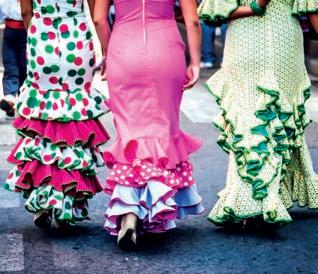
Málaga is one of Spain’s leading centres for the arts. Building on the reputation of Pablo Picasso, who was born and spent his early years in Málaga, it now has an array of globally lauded art galleries. But traditional handicrafts have always formed an important part of the local economy. The variety of Málaga’s artisan crafts – in diverse shapes, sizes and materials – speaks volumes about the region’s cultural and historical heritage, from flamenco to the enduring ornamental influence of its Islamic rulers.
Ceramics
Clay pottery was first made in the region thousands of years ago, but the form was elevated under Islamic rule in the 13th century with the introduction of Nasrid lustreware, painted with iridescent metallic pigments. Look, too, for barros malagueños, small clay figurines depicting personalities from the worlds of flamenco and bullfighting in the 18th and 19th centuries, painted and lacquered in fine detail.You can admire both forms of ceramics at the Museo de Málaga. Such pieces fetch nosebleed-high prices at auction, but you can buy good tiled murals, plates and planters at La Recova, a combined tapas bar and artisan shop. museosdeandalucia.es/web/museodemalaga; recovamalaga.wixsite.com/larecova
Málaga was once well known for its master cabinetmakers, who served a burgeoning social class eager to purchase fine pieces for their homes.Wood carving, which reached
its zenith in the 16th and 17th centuries, typically featured natural or religious iconography. Since then, the skills of ornamentation and design have been passed down the generations.Today, such talents are employed in restoration, undertaken by artisans such as those at Reinventar Vintage. Some of the finest flamenco guitars are produced by the region’s luthiers; head to Guitarras Maldonado for handmade instruments, or Pablo Requena for monthlong flamenco-guitar-making courses. reinventarvintage.com; pedromaldonado guitars.com; guitarmakingcourse.org
Visitors to the CAC Málaga modern art museum often overlook the nearby iron monument to the Marqués de Heredia. This seated statue is on the avenue named for Manuel Agustin Heredia, the reputedly self-made industrialist who pioneered metalworking in the city. His company was once the go-to producer of bespoke wrought-iron gates, doorknockers and other metal accoutrement for elegant homes across Spain and around the world. Today, limited metalwork is accessible at the craft level in Málaga, but you can find filigree lamps with Moroccan design motifs at La Casa Bella. lacasabella.es
In a city with so many churches, it’s no surprise to find a rich heritage of stained glass, engraving and other decorative glasswork.ViarcaTaller deVidrierías is one of the few workshops in the country producing and restoring stained glass. Museo del Vidrio y Cristal de Málaga showcases some 3,000 pieces of glass art, while the Centre Pompidou Málaga’s entrance hall is a colourful
glass cube. viarca.com; museovidrioycristalmalaga.com; centrepompidou-malaga.eu
In Málaga, textiles are most striking when connected to cultural traditions. Semana Santa (Holy Week) is the best time to witness the city in its finest regalia. Some of the Brotherhoods who parade through the city at Easter have established their own textile workshops to produce ornate tunics, pointed capirote hats and gold embroidered textiles decorating the large tronos (thrones) carried on floats. A handful of shops sell flamenco dresses, including Dos Lunas on Calle Fajardo, and nearby Viva la Feria. vivalaferia.es/en/
When to go
Spring and autumn are the best times to visit, when the weather is warm but tourist numbers drop. During the peak summer season, when Andalusians typically take holidays, many shops are closed. If you want to see Málaga at its wildest, visit during the Feria, a nine-day street party in August when participants don fine flamenco outfits.
Getting there
Málaga is served by regular direct flights from Belfast, Birmingham, Cardiff, East Midlands, Edinburgh, Glasgow, London (various), Manchester and Newcastle, plus seasonal summer flights from cities including Bristol and Aberdeen.

Embrace a slower pace of life in this rural region of painted caves, historic trails and spectacular landscapes
Words by Marti Buckley
Gleaming peaks
The limestone summits and crags of the
mountains soar to over 2,600m in the west of Cantabria, where visitors are encouraged to discover traditional lifestyles and crafts

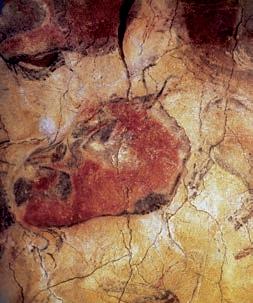

importance recognised with UNESCO World Heritage designation;
through a range of tourist-focused projects

Cantabria may well be Spain’s best-kept secret. Its lush, green pastures are home to cows whose milk gives flavour to some of the region’s famous culinary delights, from sobaos (buttery sponge cakes) to quesadas, dense puddings spiced with cinnamon and lemon. And Cantabria is also home to some of mankind’s earliest creative expressions in the Palaeolithic art adorning UNESCO World Heritage-listed caves. It offers a wealth of immersive experiences, too, from the natural to the agricultural – and we’ve picked the best for you to try here.
The Camino del Norte, a challenging variant of the famed trail to Santiago de Compostela, traces the Cantabrian coast. But for an alternative pilgrimage, tackle the Camino Lebaniego (LebaniegoWay), a route dating back to the sixth century that snakes 72km south from San Vicente de la Barquera to the Monastery of St Toribio in the picturesque Liébana Valley.
According to legend, St Toribio brought a piece of the true cross to northern Spain; it was then carried to the site of the monastery that bears his name.This relic soon attracted pilgrims, thousands of whom continue to visit the monastery each year, seeking spiritual connection and the healing properties attributed to the relic.
The Camino Lebaniego winds through breathtaking natural scenery, starting on the astonishingly beautiful northern coast and skirting the Picos de Europa mountains to the west.This verdant land is home to abundant wildlife, not least majestic eagles and falcons. Along the way, you’ll not only
explore the region’s rich history but also discover Cantabrian life and cuisine in villages and towns such as Cades, Cicera and Potes, with their exquisitely preserved churches, ancient bridges and cultural treasures culminating in the fabulous Monastery of St Toribio perched high in the foothills of the Picos de Europa above Potes.
However spectacular the scenery topside, it’s below the surface where things really get interesting. Cantabria is the region with the highest density of caves in Europe –more than 6,500, many containing spectacular geological formations. Of its 60-odd caves containing prehistoric paintings, ten have been recognised with UNESCO’s World Heritage designation for their Palaeolithic art, including Altamira El Castillo, Las Monedas, Las Chimeneas, La Pasiega, La Garma, Covalanas, El Pendo, Hornos de la Peña and Chufín.
“The earliest of the cave’s charcoal drawings and paintings of local wildlife and human hands date back more than 36,000 years”
caused by water vapour and carbon dioxide emitted by the large numbers of people admiring the images, visits by the public are no longer permitted. Instead, accurate reproductions of its art have been created, and are displayed in the National Museum and Investigation Centre of Altamira near the cave. It’s fascinating to see the polychrome paintings of now-extinct bison, horses, deer and wild boar – images that have played a key role in mapping the history of human development over the millennia. cultura.gob.es/mnaltamira
To discover a different aspect of Cantabria’s historical underground network, delve into the 27km-long El Soplao Cave. Here, the headline act is geology – or, rather, the extraordinary array of stalactites, stalagmites and other curious mineral formations sculpted over countless millennia. Mining tools used in the cave are also on display, and guides are available in several languages. elsoplao.es/en/
If you have time for only one cave, make it Altamira, outside the beautiful town of Santillana del Mar. It was discovered in 1868 after a fallen tree cleared the rocks blocking the cave entrance, allowing its drawings to be admired; in fact, it was one of the first such caves in Europe to be found and promoted.The earliest of its charcoal drawings and paintings of local wildlife and human hands date back more than 36,000 years.Today, to curb the damage
Some towns have art museums. Arnuero and the surrounding villages, however, are different.This marshy area between Santander and Bilbao is home to Trasmiera Ecopark, an ‘open-air museum’ that links four villages, each with its own facilities exploring local heritage, art and nature. Spread out over about 25 sq km, this culturally rich complex is worth a full day’s visit. Laced with walking trails leading through swamps and lowlands, along cliffs and up ⊲

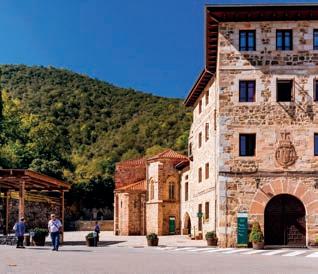
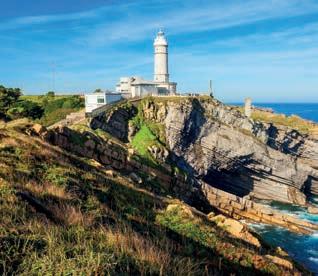
to the cross-capped viewpoint atop 249mhigh Monte Cincho, the area is teeming with natural wonders.
The various routes around the Ecopark visit an array of fascinating sites.Your first stop could be the Molino de Santa Olaja, accessible only at low tide. Here you can learn the story and workings of this historic hydraulic mill, showing how such medieval structures were powered by the tides.
Another highlight is the Art Observatory alongside the Church de la Asunción (Church of the Assumption) in Arnuero.The Trasmeran people of this area were known for their skills as masons, sculptors and altar makers, making a significant impact on Spanish architecture and leaving their legacy across the Iberian Peninsula.The observatory displays some of their masterworks, and a visit includes the chance to admire the church’s richly ornamented plateresque altar.
Benath Monte Cincho lies the village of Isla, whose old centre is graced by medieval towers, a historic palace and the beautiful Church of St Julián and St Basilisa, superb examples of local architecture. The Ecopark’s fine beaches are particularly alluring during the warmer months –try the golden sands of wide Playa de la Arena or secluded little Playa de los Barcos. ecoparquedetrasmiera.com
If you’ve ever dreamed of a rural lifestyle – or even just thought of trying it on for a day – De Granja en Granja (‘from farm to farm’) is for you. Part of an initiative to highlight the value of farmers’ work and encourage the preservation of agricultural heritage, this route links dozens of farms across Cantabria’s rolling countryside.Visitors aren’t just welcomed – they are encouraged to roll up their sleeves and get their hands dirty with a range of experiences, learning skills passed down through generations and hearing from farmers sharing the traditional techniques of the region.
You might visit Carnicería Quintana, a family farm at the foot of the Cabuérniga Valley, birthplace of the native Tudanca cow. Or Flor de Limón, an organic citrus-fruit plantation. En route you’ll learn about ancestral wisdom and food production practices on real Cantabrian farms, and it’ll give you the chance to taste traditional produce in an experience that is so much more rich and authentic than simply popping into a local restaurant.You might walk through the vineyards of a

local natural winemaker, churn butter made from Cantabria’s famous cow milk, or visit the sheep that produce the milk for Pendo cheese. For a hands-on cooking experience, join a quesada and sobao workshop to learn how to make two of Cantabria’s most celebrated sweets – those custard desserts and buttery cakes. degranjaengranja.es
Cattle have always been important elements in the landscape of the Valles Pasiegos district. Residents of these valleys nurtured a wealth of artisanal knowledge about farming this livestock, but the practice suffered a downturn in the late 20th century as younger generations moved to big cities. The mission of La Lleldiría fermentation project (lleldar means ‘to ferment’ in the Cantabrian dialect) is to demonstrate the value of a traditional agrarian lifestyle, showing young people that a living can be earned without leaving the valleys and cutting ties with their homeland. Hence Aitor Lobato and Sarah Hart launched the project in two cabañas (traditional mountain houses) they purchased over a decade ago. At La Lleldiría, the principal product is cheese – but you’ll also find less-typical fermented treats such as kombucha, vermouth and mead.

Visiting is a great way to experience the slower side of Cantabrian artisan life, and to hear Aitor and Sarah recount their personal experiences and the challenges of starting a fermentation project. Choose between two different packages: the Lleldiría Visit + Tasting (€10/£8.50) or the Valles Pasiegos Tasting (€15/£13). The first visits the creamery
where the cheese is made, and the cellar where it matures.You’ll explore fascinating sustainable processes that maintain links with the environment, and end with a tasting of cheese and kombucha.The Valles PasiegosTasting allows you to try La Lleldiría’s full range of products, from cheese and cured meats to mead and vermouth. lalleldiria.com
When to go
Cantabria is temperate and mild, with the chilliest months (lows of 6ºC) being January and February, which are also wet. Cantabria receives 120cm of rain annually. Summer is the best time to visit; even August, popular with Spanish holidaymakers, is manageable, especially outside weekends.
There are direct flights to Santander from London, Birmingham, Edinburgh and Manchester that run between March and October. Brittany Ferries (brittany-ferries.co.uk) sails to Santander from Portsmouth twice weekly in around 33 hours. Buses run infrequently along the coast; self-drive is the easiest way to explore inland.
La Vijanera, held in Silió on the first Sunday in January, is a colourful carnival with ancient roots. La Folia, held in San Vicente de la Barquera on the second Sunday after Easter, is a fascinating nautical festival in which the Virgin Mary is carried to the port and out to sea at high tide.
 Purple patch The countryside around the village of Brihuega in Castile-La Mancha is striped with over 1,000 hectares of lavender fields, scenting the air with a distinctive aroma
Purple patch The countryside around the village of Brihuega in Castile-La Mancha is striped with over 1,000 hectares of lavender fields, scenting the air with a distinctive aroma

From bears to blossoms and peaks to predators, this long-overlooked region boasts an array of attractions to tempt nature-loving travellers
Words by Mark Eveleigh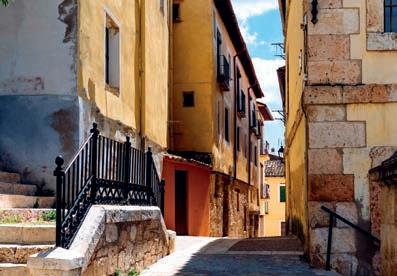


‘The Alcarria is a beautiful region which people apparently have no desire to visit,” wrote Spanish Nobel Prize-winning author Camilo José Cela in his 1948 book Journey to the Alcarria. Some three centuries earlier, Miguel de Cervantes had one of his characters harangue Don Quixote about “the empresses and queens of the Alcarria”.The comment was clearly ironic because until recently this forgotten part of Castile-La Mancha was considered very much a sleepy backwater.
Today, however, this long overlooked region of wetlands, gorges and plateaus is justly celebrated for its natural beauty and timeless rural way of life. It seems almost inconceivable that an area of such rich biodiversity should lie less than 40km from the Spanish capital. Unsurprisingly, Madrileños are finally being lured to highland villages where life revolves around the production of natural honey, olive oil and lavender, much as it has since Cervantes’ time.
A large part of the Alcarria is visible from the region’s highest points, the twin peaks officially known as Las Tetas de Viana –literally ‘Viana’s Boobs’.You can climb the most southerly peak via a mountain trail and an iron ladder to take in views over vast expanses of traditional dehesa. Such areas of mixed pasture and woodland are not only precious resources for rural communities, but also provide havens for creatures such as deer, boar, marten, badger, wild cat, fox, genet, otter and the endemic Iberian hare.
The Alcarria is only one of the magnificent wild expanses of Castile-La Mancha.The jagged ridges of Sierra Norte de Guadalajara Natural Park – one of southern Europe’s last glacial refuges – hosts such creatures as snow voles. El Hosquillo Animal Park, in the Serranía de Cuenca Nature Reserve, is home to brown bears as well as Iberian wolves. For a chance to spot wild lynx, head to CastileLa Mancha’s southern boundary and the isolated highland ridges of Alcudia Valley and Sierra Madrona Natural Park in the Sierra Morena.
Pico del Lobo (Wolf Peak) – the region’s highest point, at 2,273m – rises in the far north. But the lows are tempting, too: you can also descend, through ancient forests of oak, poplar, willow and ash, into the spectacular Barranco del Río Dulce, or ‘Sweet River Ravine’. Crystal pools stud this tributary of the mighty Tagus River, the longest in the Iberian Peninsula.

A range of well-marked day hikes, typically covering around 11km, lace Barranco del Río Dulce Natural Park. There’s even a 1.5km interpretive nature ⊲
Unsung beauty (this page, from top) The historic and natural delights of Castilla-La Mancha – including the medieval core of Brihuega, the wildlife of El Hosquillo Animal Park and the 15th-century Castle of Jadraque – have long been under-appreciated; (opposite) purple is the hue of Brihuega, famed for its Lavender Festival each July






A taste of the wild (clockwise from left) Toledo is perched on a hill and its historic quarter is a UNESCO World Heritage Site; honey from the Alcarria region of Castile-La Mancha is famed for its floral notes; historic windmills, like these in Mota del Cuervo, are an iconic part of Castile-La Mancha’s landscapes; spot spoonbills and other wetland species in Las Tablas de Daimiel National Park
walk developed to be enjoyed by visually impaired visitors.
Hiking through shady oak glades, the dehesa has a mesmerising effect, with scents of thyme, rock-rose, gorse, broom, sage, marjoram, rosemary and lavender drifting on the hot breeze. As Camilo José Cela noted: “You get dizzy smelling it.”
But smell isn’t the only sense being tickled. Each July, the town of Brihuega hosts an unforgettably picturesque Festival of Lavender, during which white-clad townsfolk gather amid swathes of the purple blooms to enjoy sunset musical events and culinary delights created by Michelin-starred chefs.
Regional cuisine in Castile-La Mancha includes specialities such as Cordero Manchego (lamb from the Manchega breed, most famously roasted in the medieval town of Jadraque) and honey infused with a dozen different flavours. That from Colmenar de Valderromero, in Sigüenza, has hints of lavender, rosemary, thyme, eucalyptus and orange blossom.
This area also boasts rare flora such as a recently discovered species of grass (the delightfully named Carex quixotiana) and the Paular geranium, found only in the volcanic hills of La Miñosa and in a small area of neighbouring Madrid province.
Birdwatchers flock to wetlands such as Las Tablas de Daimiel National Park and Buendía Reservoir for sightings of black storks, Eurasian spoonbills and flocks of cranes and greater flamingos. Elsewhere, the craggy cliffs and canyons of Alto Tajo Natural Park host golden eagles, Bonelli’s eagles and unforgettable congregations of dozens of griffon vultures.
This region has sparked the imaginations of generations of Spanish writers. Alto Tajo itself inspired the fictional setting for José Luis Sampedro’s 1961 novel The River That Takes Us
“You live with dignity when you live with authenticity,” Sampedro wrote in that book. He would surely be relieved to see that dignity and authenticity continue to march hand in hand through the wilds of CastileLa Mancha.
In spring, entire plains are carpeted with wildflowers including the Paular geranium. Autumn is equally spectacular for the burnished forests that line the valleys. Temperatures can soar into the 40s (ºC) in midsummer, while from December to March you can expect snow and ice.
The provincial capitals (Albacete, Ciudad Real, Cuenca, Guadalajara and Toledo) are all only around 90 minutes or less from Madrid by train. Hiring a car offers more freedom to explore far-flung areas.
Honey Museum (Peñalver, Guadalajara) offers a chance to explore the Alcarria’s tradition of apiculture, and the human appetite for honey that dates back at least 10,000 years. Museo del Viaje a la Alcarria (Torija, Guadalajara) claims to be the first museum in the world dedicated to a book – a celebration of Camilo José Cela’s classic JourneytotheAlcarria–housed in the medieval Castle of Torija. El Hosquillo Animal Park opens from March to December. This park offers the chance to learn about a captive breeding programme for brown bears and other wildlife. Advance bookings are essential; adults €13.15, concessions €6.57 and children under four go free. parqueelhosquillo.com
Fire Procession (Humanes, Guadalajara). On the second Saturday in September, the Peñahora Virgin is carried from her shrine to the village along a 2km path lined with fire.
Battle of the Dancers and Sinners (Camuñas, Toledo). This ritualised battle between good and evil is re-enacted each year between Corpus Christi and the following Sunday.
Manchego May Festival (Pedro Muñoz, Ciudad Real). This feast of colourful folklore, enlivened with music and traditional dress, is held overnight from 30 April to 1 May.
Festival of Lavender (Brihuega, Guadalajara). The purple crop is celebrated each July. festivaldelalavanda.com

Delve deep into how to experience sustainable travel across Spain. From the places we stay to the methods of transport we choose, these stories look at what it means to travel slowly and responsibly.
Ernest Abentin A dish called ‘The goose that laid the golden eggs’, which is a fried egg with crustaceans served at Disfrutar restaurant in Barcelona
A dish called ‘The goose that laid the golden eggs’, which is a fried egg with crustaceans served at Disfrutar restaurant in Barcelona
Mixed legacy Córdoba’s Mezquita, first built as a mosque in the eighth century then augmented with a Renaissance cathedral at its heart, is an early example of reimagining a Spanish landmark monument

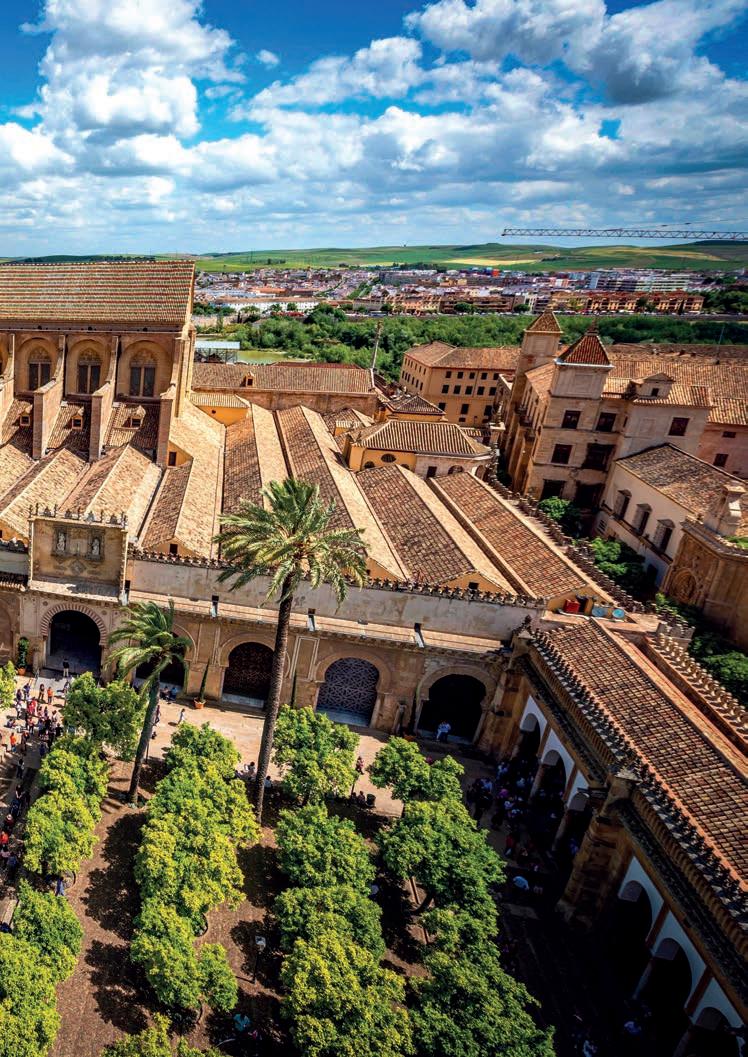
Discover how the revival of key monuments is creating venues and benefitting communities
Words by Laura FieldSpain has a rich, complex, often tumultuous history – one that has yielded hugely diverse architecture and engineering feats, from Roman aqueducts to Moorish palaces, medieval monasteries to modern bridges. Indeed, it spans so many eras that landmarks and monuments across the country have inevitably suffered the ravages of time. Many have also been repurposed or augmented – Córdoba’s Mezquita being a prime example, built as the city’s Grand Mosque then converted into a Christian cathedral.
Recent initiatives to restore and revive historic structures have been recognised for both their innovation and the importance of their efforts. Here we shine a spotlight on some of the most impressive projects.
Over many centuries, houses in Córdoba were built around central courtyards, often containing fountains and plants, to help cool homes in the hot, dry Andalusian climate. The PAX-Patios de la Axerquía initiative is restoring patio houses to encourage urban
regeneration and social cohesion. By regenerating abandoned properties in the Axerquía district, the initiative aims to create communal living spaces that celebrate Córdoba’s Mediterranean and Moorish heritage. It is also repopulating the city’s historic centre and creating cooling spaces to protect residents from the intense summer heat. patiosaxerquia.org
The main landmark on this petite island, lying in the centre of Mahón’s long natural harbour, is a former hospital built





by the British Royal Navy in 1711. After the hospital closed in 1964, the building deteriorated. Now, thanks to a collaboration between volunteers of the Illa del Rei Hospital Foundation and Swiss contemporary art gallery Hauser &Wirth, it has been restored and reimagined as a grand modern art gallery and museum. menorca.hauserwirth.com
Founded by King García I of León in 912, the Monastery of San Pedro de Eslonza in Gradefes was ravaged under Moorish rule later that century, setting a pattern of rebuilding and ruination. Having enjoyed major restoration in the 16th century, by which time it was a thriving Benedictine monastery, it was then abandoned in 1835.
After decades of degradation, a project was launched to reinvigorate the buildings and integrate them into the surrounding landscape of the EslonzaValley. A key aim was to enable tourists to visit, ensuring the monastery’s legacy, and guided visits now run by appointment fromWednesday to Sunday between July and September. aytogradefes.es
The stone bridge over the Deba River, near its mouth between Bilbao and Donostia-San Sebastián, was built in 1866 to link local communities. Now an important historical landmark on the northern variant of the Camino de Santiago, by 2018 the bridge was on the brink of collapse.Thanks to an initiative propelled by local governments, the Deba Bridge was successfully restored
and once again connects the communities of Deba and Mutriku. tourism.euskadi.eus
Originally built in 1882 to supply Barcelona’s residents with water, the iconic Torre de les Aigües del Besòs (BèsosWater Tower) is a striking symbol of the city’s industrialisation. Abandoned in 1992, it was neglected until 2010 when a restoration project was launched, taking painstaking care to restore the tower in alignment with its original structure.Two spiral staircases were installed, and today the tower is open to visitors as a cultural centre that promotes and fuses art and industrial heritage, as well as offering spectacular city views. torredelesaigues.cat

The introduction of tauros cattle in the Iberian Highlands, which straddle Castile-La Mancha and Aragon, is boosting biodiversity and creating opportunities for spectacular wildlife safaris
Words by Jessica Vincent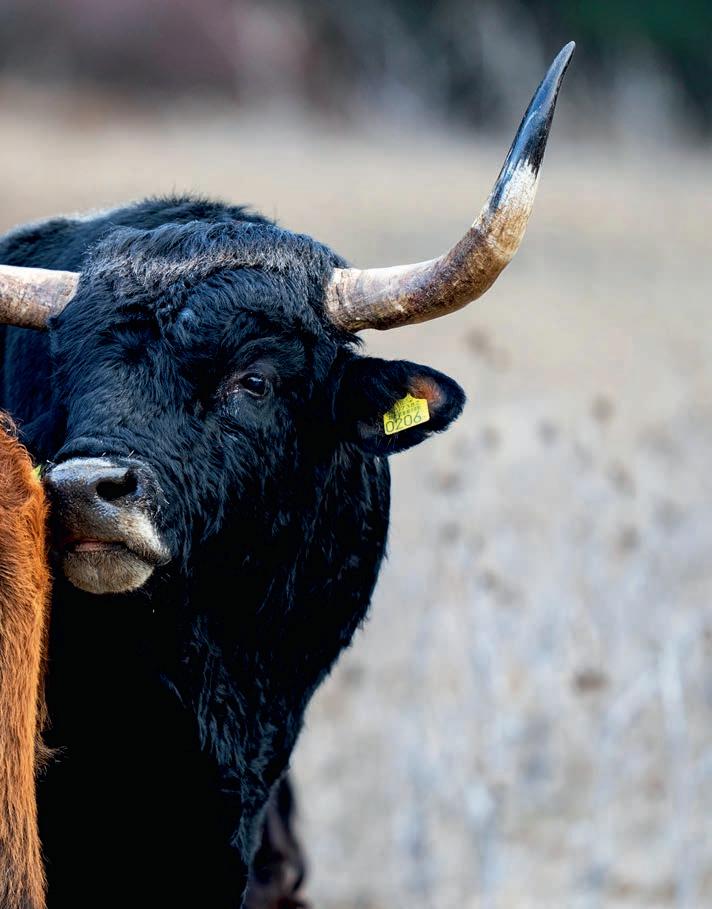
The snow had started to fall when three enormous bulls charged toward us. I heard them before I saw them: heavy, short breaths and the thunder of hooves clattering on rock, trembling the mud beneath my boots like an earthquake. The biggest horns I’d ever seen, curving sideways and up to the sky like the handlebars of a Harley Davidson, were almost upon us. And there was nothing but open steppe between me and a creature big enough to flip a car.
It was a cold winter weekend when I travelled into the Sierra de Albarracín range in Teruel province to see Spain’s first herd of semi-wild tauros. Specially bred to be released into Europe’s wild forests to improve biodiversity, they’re now genetically the closest living animals to the extinct aurochs, the ancient wild cattle from which all domesticated breeds are descended.
“The aurochs was our continent’s defining animal,” reads the foreword to The Aurochs: Born to beWild, published by Rewilding Europe and the Taurus Foundation, two Dutch NGOs working to introduce tauros and other species to Europe’s wild landscapes. “Not only was it a keystone species ... but it also became crucially important to the history of mankind.”
The aurochs has been extinct since 1627 when the last individual, a female, was killed in what’s now Poland. In previous centuries, large numbers of this huge herbivore – bulls weighed up to a tonne – roamed freely in regions across the Old World, from Britain and southern Scandinavia to North Africa and Central Asia. But it was in Europe that aurochs had a particularly profound impact.
For millennia, the aurochs was the largest mammal on the continent, after the woolly rhino and mammoth went extinct during the last Ice Age. It drew the ploughs of the ancient Minoans, and provided ancient Greeks with milk and hides. More importantly, these large herbivores – along with European bison, wild horses, deer and ibex – were vital for healthy ecosystems.
“Aurochs were the architects of the European landscape,” explained Pablo Schapira, biologist and team leader at Rewilding Spain, the local NGO partner of Rewilding Europe. “Aurochs fertilised the soil with their dung, removed excess biomass in the forests and created open spaces for other plants and animals to thrive.”
As aurochs declined over the centuries, large numbers of domesticated cattle grazed enough forest to maintain a thriving landscape. In recent years, though, a decline in livestock farming and increasing land abandonment across Europe has allowed
Welcome back the wild
The rewilding team runs safaris to bring much much-needed tourism to the area and to allow visitors to see the benefits of rewilding for themselves ⊲



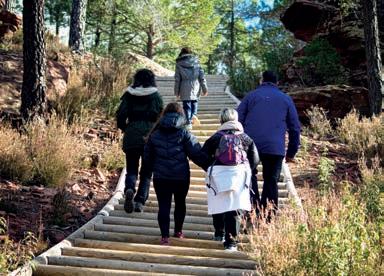

forests and shrubs to grow unchecked, Schapira explained, increasing the risk of wildfires and reducing the overall biodiversity of European forests.
“We have a misconception of what a healthy forest should look like,” observed Schapira. “In Spain, we have a real problem with wildfires.This is because there is too much biomass in the forests and less open grassland to slow the spread.”
Nearly four centuries after the aurochs’ extinction, Rewilding Europe and the Taurus Foundation are working to introduce tauros to European forests. Referred to as ‘aurochs 2.0’, the tauro is the result of cross-breeding several types of European bovines – including the Spanish breeds Limia, Sayaguesa and Pajuna del Sur – to create a cow that looks, eats and behaves like the ancient aurochs. To date, some 500 tauros have been born, and the Tauros Programme has released herds in Portugal, Croatia, the Czech Republic, Romania, the Netherlands and, most recently, in the Iberian Highlands of central Spain.
The three young tauros hurtling towards us pulled up just 100m away – but our safari guide, Ricardo Almazán, didn’t even flinch.
“They won’t hurt us,” he smiled, as a thunderous, high-pitched ‘Moooooo!’ rent the air. One tauro raised his head to the sky like a wolf, nostrils flared and tongue hanging lopsided from his mouth. “They’re gentle animals – towards humans, at least.” Suddenly, two of the bulls turned to face one another, butting heads with a bone-cracking crunch, hind legs kicking at the earth. Grunting, they waltzed from side to side with horns interlocked, thick breath rising from their nostrils, tails swaying.Yet though the fight looked fierce, they soon broke apart and continued as if nothing had happened.
Safari Rewilding La Maleza, a wildlife tour introducing visitors to Spain’s first herd of semi-wild tauros, is Ricardo’s brainchild. As well as being sustainability advisor to the local municipal government, he’s the director of Parque de Fauna La Maleza, a sanctuary for rescued Iberian animals including wolves, ibex and, soon, lynx.
When Rewilding Spain contacted Ricardo about bringing the first herd of tauros to the area, he agreed to run the project alongside La Maleza, funding much of the initial costs – more than €50,000 – himself.The safaris, launched in summer 2023 with a loan from the Rewilding Europe Capital fund, help repay some of those costs and bring muchneeded tourism to the area. Most importantly, though, they enable people to see the benefits of rewilding first-hand.





“Spain has an urgent need to change its attitudes towards wildlife,” said Ricardo, a former restaurateur and hotel owner who, before opening La Maleza and reading extensively on the subject, knew little about running a rewilding project. “It’s all well and good releasing animals into the wild, but we need people to stop seeing them as a threat. If we’re ever going to succeed in rewilding Europe, we need people to want to live alongside these animals.”
Our journey had begun an hour earlier, boarding an open-topped Land Rover Santana to climb steep off-road trails flanked by dense pine forest, its trees planted in orderly, clearly artificial rows.
“When you look at these pine forests, you see green,” said Ricardo pointing at the trees. “But what you’re actually seeing is a desert. Look at the forest floor: what do you see? Nothing.When one species dominates, nothing else can grow.”
I followed his gaze. He was right: beneath the canopy lay nothing but brown earth and desiccated pine needles. As we drove deeper into the forest, I watched keenly for a deer or a wild goat – this was, after all, a wildlife safari. But I saw nothing – not even a bird.
As we approached tauro territory, though, everything changed.The pines thinned out, allowing the mountainside to be flooded with natural light. Instead of uniform forest, I spied young, leafy trees and rocky mounds sprouting with rosemary, thyme and dozens of flowering plants and shrubs I couldn’t name.Within minutes of our arrival in this wilder area, a fallow deer bolted across the landscape. Moments later, a wild boar waddled idly across our path, his snout wrinkling as he sniffed the air. My eyes were caught by a flash of yellow, white and black as overhead an Egyptian vulture circled.
“This is what the Iberian Highlands would’ve looked like thousands of years ago,” said Ricardo. “There are maybe 40 or 50 plant species just in this area. At sunset, it’s just incredible – you wouldn’t believe how much wildlife there is.”
Straddling the regions of Castile-La Mancha and Aragon, the Iberian Highlands rewilding project landscape encompasses 850,000 hectares of pine and juniper forest, wide steppes and deep river canyons. Mass land abandonment since the 1960s has led to a population of fewer than two people per square kilometre here – the area is often referred to as “empty Spain” – and the return of deer, wild boar, mouflon and vultures. Over half of the area was already protected within Natura ⊲
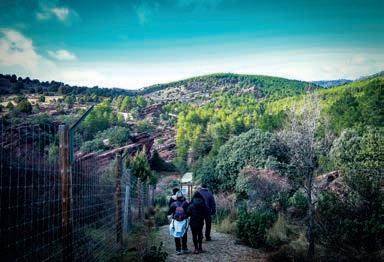


Animal magic (opposite page; clockwise from top left) Ricardo Almazán explains about the area’s rewilding efforts; visitors can head on safari to learn about the local fauna; the more-varied forest habitat created by tauros is ideal for fallow deer and other herbivores; (this page; top–bottom) suggested routes around La Maleza park lead visitors to meet spectacular wildlife, including Iberian wolves; watch for Egyptian vultures circling above cliffs in the tauro-occupied areas of the mountain range


The nature we need (this page; clockwise from top left) Predators such as wolves are key components in a well-functioning ecosystem; previously common species such as spiral-horned mouflon have been returning to the region dubbed “empty Spain” after the human population declined and land was abandoned since the 1960s; (opposite page; top–bottom) semi-wild Pottoka ponies from Basque Country have also been released in the tauro zone; Safaris Rewilding La Maleza takes visitors into tauro-grazed habitat; in the same area, protected nest holes in pine trees provide havens for rare greater noctule bats
Parque de Fauna La Maleza; Alamy2000 sites but, in 2022, the Iberian Highlands became part of Rewilding Europe’s initiative to turn the continent’s least populated areas into natural wildlife sanctuaries.
The tauro territory currently spans 1,000 hectares. It’s a relatively small space for such large, free-roaming animals, Ricardo told me, but big enough to make finding them tricky, especially in bad weather. On the day I visited, Ricardo used a satellite tracker, and Paco, a local employed by Rewilding Spain to care for the herd, helped locate them in the incoming snowstorm. As tauros gathered, we stepped out of the car and walked deeper into the forest, watching as the cattle browsed twigs and stripped bark like butter curls from young pine trees.
“They’re the only animals that do that,” said Ricardo, admiringly. “Tauros eat what other wild and domesticated animals won’t touch.”
of pine forest covering the mountainside, and a sadness washed over me as I thought of all of the species unable to thrive in the darkness of that dense monoculture. But then a large black tauro strode past me, and the flash of light brown fur running down his spine – a trait passed down from ancient aurochs –reminded me that there is hope.
“Tauros are just one part of the puzzle; rewilding is about restoring natural processes such as grazing, scavenging and predation, so that the whole ecosystem benefits”
Among the feeding tauros, Ricardo showed me a large hole in the bark of an enormous pine: a protected nesting site for the rare and vulnerable greater noctule bat, the largest and least studied in Europe. Alongside a river we spotted webbed toeprints and musty, jasmine-scented droppings – signs of an otter, not seen in the area for decades. Ricardo is confident that these species are returning here as a direct result of the introduction of the tauros.
“This isn’t just about releasing a load of cows into the mountains,” said Ricardo. “The tauros are making these forests liveable again for other species – they’re bringing them back life.”
On a forest trail carved out by the tauros, we see seven Pottoka ponies, a semi-wild breed from Basque Country released here in early 2023. Like tauros, these large grazing herbivores help regenerate the soil and reduce the risk of wildfires. Elsewhere in the Iberian Highlands, Rewilding Spain has released small herds of endangered Serrano and Przewalski’s horses, as well as cinereous vultures, which disappeared from the region a century ago.There are also plans to release Iberian lynx in the area.
“Tauros are just one part of the puzzle,” Pablo told me. “More than recovering individual species, rewilding is about restoring natural processes such as grazing, scavenging and predation, so that the whole ecosystem benefits.”
In a small clearing in the woods, just past the sleek black Pottoka ponies, I saw swathes
Because of people such as Ricardo and NGOs including Rewilding Spain, one day the Iberian Highlands – and, perhaps, the whole of the European continent – could not only be inhabited by ancestors of the extinct aurochs, but also by thousands of other wild species, big and small. Biologists and rewilding experts have highlighted the benefits of returning our planet to its wilder state yet, for most of us, such dramatic change –and personal sacrifice –can be hard to imagine, let alone believe in.
As we headed back to the car, I asked Ricardo what motivated him to invest his life savings into rewilding his homeland. “Madness,” he laughed, unlatching the back of the Land Rover for me.The snow started to fall again, and it was time to head back down the mountain. “This is a life of constant work and expense. But if I left it to the government, it wouldn’t happen. Change starts with us.”
Need to know
Safaris Rewilding La Maleza tours depart from Parque de Fauna La Maleza, 15km from the town of Albarracín, every Saturday, Sunday and bank holidays between March and October around sunset, either at 5pm or 6pm depending on the time of year. In summer months (late July to early September), there are daily safaris at 9am and 7pm. Trips last around two hours and must be booked in advance via the park website. The safari vehicle carries a maximum of eight people. parquelamaleza.com/safari-la-maleza
Further information
Rewilding Spain (affiliated with the continent-wide Rewilding Europe organisation) has a range of projects in the country. rewilding-spain.com/en; rewildingeurope.com




Finding memorable accommodation doesn’t have to cost the earth, thanks to eco-friendly options that also benefit local communities
Words by Eddi Fiegel
Just as the world’s eyes have turned to Spanish cities for leadership on sustainable tourism, in recent years Spanish accommodation providers have been blazing a similarly impressive trail. From state-of-the-art new-build hotels with award-winning energy-efficiency systems to restored medieval monasteries and abbeys offering Green Michelin-starred fine dining, to ground-breaking initiatives that protect the local environment and communities, there’s no shortage of choice.
Whichever region you’re visiting – from Asturias, Catalonia and Basque Country in the north to Galicia in the west, Castile-La Mancha in central Spain and Andalusia in the south – you’ll find stylish, sustainable places to stay. Here are ten top choices.
Sustainability has been at the heart of this collection of eco- and pet-friendly cabins in Galicia from the outset. Clustered in seven sites about half an hour’s drive west of Santiago de Compostela, these collections of stylish, architect-designed cabins are made in part using recycled wood. Many sit amid the treetops in forests of pines, chestnuts and cork oaks; others have views of rivers or meadows. You’ll also find hydromassage baths on terraces as well as nestled snugly in well-appointed bathrooms.
The location of each cabin has been carefully chosen to ensure that it integrates sensitively with the landscape,
with reforestation undertaken where necessary. Renewable energy sources are used where possible, such as solar panels and aerothermal heat pumps.
You might gaze out at surrounding woods through huge picture windows, waking up to the sound of birdsong.You’ll certainly breakfast on homemade bread, honey, jam and freshly squeezed orange juice, delivered to your door in a wicker basket. Cabins are also equipped with kitchens to allow guests to self-cater, though dinners made with locally sourced produce can be provided on request. Cabins from £128 per night; cabanitasdelbosque.com

Set in the Miramón forest district on the southern outskirts of Donostia-San Sebastián, the Arima Hotel & Spa is as impressive for its state-of-the-art green credentials as for its eye-catching wood, glass and aluminium exterior.
Since it opened in 2019, Arima – Basque for ‘soul’ – has become the first hotel in Spain to be awarded the internationally respected Passivhaus certification for
energy efficiency and, with 69 rooms, the largest such property in Europe. Setting new standards in sustainability, 77% of its energy comes from aerothermal and geothermal sources; rainwater is recycled for cleaning; and excellent insulation, tripleglazed windows and aluminium tiles help regulate temperature.
Stylish and minimalist yet luxurious rooms feature fetching forest views as
well as organic bed linens and bath products, plus a recycling drawer for separating used plastic, paper, glass and organic waste.There’s also an eco-friendly spa and Foresta wellness centre, plus a chlorinefree infinity pool.The bright, informalTilia Deli & Café offers sustainably sourced food, including vegan and vegetarian options. Average room price £150 per night, room only; arimahotel.com
There’s a real sense of getting away from it all at this luxurious yet supremely sustainable boutique hotel in the little-visited Matarraña area of far eastern Aragon, abutting Catalonia and Valencia. Built on an 89-hectare estate that encompasses certified organic farmland, olive and almond groves, rose gardens, forests and a lake, the hotel building – which dates back to the 15th century – seems a world away from modern life. No wonder that, thanks to the absence of light pollution and frequently clear skies in the area, this is the first Relais & Chateaux Hotel in Spain to be awarded UNESCO-backed Starlight Certification.
Ingredients at the award-winning, farmto-table restaurant are sourced from the estate’s own fields and gardens, and from local cattle farmers and shepherds. A range of other sustainable measures includes waste recycling, vegan toiletries and electric car-charging facilities. Enjoy days swimming, walking, cycling or horseriding in the surrounding hills, with the Sistema Ibérico mountains looming in the distance. Guided tours, cookery courses, wine tastings and stargazing sessions round off the offer.Doubles from £279 per night, room only; torredelvisco.com

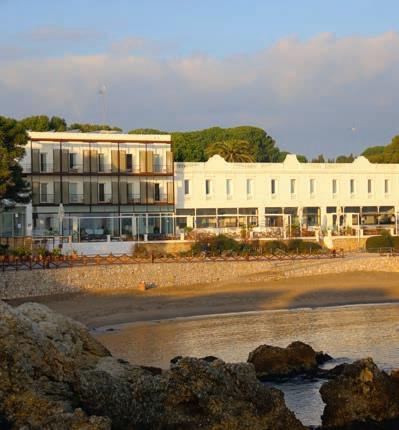
Far from the madding crowds of Spain’s busier coastlines, yet just yards away from the waves on one of the Costa Brava’s wildest and most unspoilt beaches, stands the first hotel in Europe to win the internationally recognised LEED (Leadership in Energy and Environmental Design) Gold certification in 2010.
Under an hour’s drive from Girona and its airport, the hotel flanks the ancient Greco-Roman ruins of Empúries and the spectacular Camí de Ronda coastal footpath along the Costa Brava. The sleek, minimalist extensions to the original 20th-century building feature bright, fresh rooms and vast picture windows looking out across a pine-fringed beach. Constructed using sustainable materials, the hotel’s eco-friendly measures range from chemicalfree paints to water recycling systems.
Ingredients in the hotel’s three eating areas, including fine-dining options in the superbVillaTeresita restaurant, are sourced from the organic kitchen garden. There’s also a luxurious spa, yoga workshops and excursions to local organic wineries. Average room price £179 per night, room only; hostalempuries.com ⊲

You might not expect a medieval Benedictine monastery to be at the forefront of sustainability, but that’s the case at this Parador in the foothills of the Picos de Europa mountains.The San Pedro deVillanueva monastery, founded in the eighth century on the banks of the River Sella, is now an atmospheric hotel, all beamed ceilings, Romanesque arches and four-poster beds. Its pioneering Nature for the Senses programme immerses guests in the local environment and culture, encouraging them to delve into the region’s traditional lifestyles and heritage, supporting local craftspeople and conservation schemes.
Choose from a range of excursions including visits to nearby Romanesque churches, walks on trails along the Cantabrian coast, outings with local shepherd dogs, and sheep, cheese and cider tastings as well as workshops exploring the medieval monastery’s traditions of herbal medicine. Needless to say, food here highlights Asturian produce, notably its famed beans, ciders and cheeses. Average double price £172 per night, room only; paradores.es/en/paradorde-cangas-de-onis
Many Paradores occupy beautiful historic buildings – medieval monasteries, palaces, even Moorish fortresses. Yet they also embrace a very modern ethos of sustainability. The Parador de El Saler, though, is distinctly contemporary in architecture and comfort as well as its green approach.
Set low amid the sand dunes and pine forests of Albufera National Park, less than 30 minutes’ drive south of Valencia, this sleek, chic building with spa and alluring pool has roof-mounted solar panels and recycles water to irrigate lawns and plants; it also supports local environmental projects.
Spacious, comfortable bedrooms are furnished with side tables refashioned from recycled fishing nets, and wastepaper baskets are made using plastic collected from the nearby beach.
Two restaurants celebrate local ingredients and traditional regional dishes.The Parador is involved in projects protecting and reintroducing animals such as turtles, as well as a seedbed scheme nurturing endangered species for replanting along the Valencian coast. Average room price £202 per night, room only; paradores.es/en/parador-de-el-saler


High amid the idyllic meadows and mountains of Andalusia’s Serranía de Ronda region, Finca La Donaira is focused on helping visitors get back to nature.This stylish Andalusian farmhouse featuring nine guest rooms and suites – seven in the stone-built house, plus two luxury yurts –is set on an organic farm with vineyards, beehives and a stud breeding Lusitano horses. Guests are invited to savour their
surroundings, whether simply relaxing in the outdoor pool or exploring the farm and its biodynamic vegetable garden, or ranging more widely through the hills.
The farm-to-table ethos takes centre stage here, with ingredients sourced from the hotel’s own gardens and local producers. Expect to savour ricotta cheese, yoghurt and butter made with local organic cow and goat milk, self-produced extra virgin olive
oil, and free-range eggs from the farm’s own chickens. Freshly picked herbs are used in the restaurant’s cuisine as well as in healing infusions.
There’s a yoga platform overlooking the surrounding countryside and a luxury spa with a large indoor pool, plus wine tastings and kombucha and natural cosmetics workshops. Average room price £853 per night (full-board only); ladonaira.com

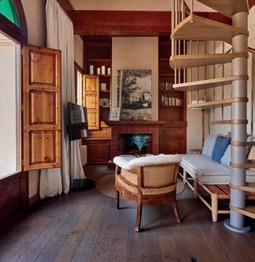

Stretching north-east from Barcelona, just inland from the coast, is a rough-cut emerald – the Parc de la Serralada Litoral.This swathe of wooded peaks and ridges rising to 530m, a key stop-off for birds on their annual migrations, is littered with archaeological remains dating back some 5,000 years. And set into its heart is another green gem: the first 100% eco-friendly hotel in Spain – Mas Salagros EcoResort.
The resort’s Green Globe certification reflects its total commitment to sustainability.That extends from building materials through amenities, the AIRE Ancient Baths spa, waste management and energy efficiency to cuisine. Whichever one of the sleek but welcoming eating areas you choose, you’ll savour inventive dishes made with organic, seasonal, locally produced ingredients, accompanied by organic wines.
Gazing out from your airy room or suite over the lush gardens or into the surrounding wooded hills, the urge to explore is irresistable. Fortunately, a range of activities encourage guests to spread their wings, including cycling into the park, wine tasting, sketching and cookery classes, yoga and mindfulness – even a spot of forest bathing. Doubles from around £190 per night, room only; massalagros.com/en/
The countryside around Cuenca in central Castile-La Mancha is among Spain’s less-visited regions. One good reason to explore is this magnificent Parador housed in an imposing castle built by Moorish conquerors in the eighth century, expanded and reinforced after it was taken by the forces of Alfonso VIII in 1184.
Set on a hilltop overlooking the River Júcar and its dramatic limestone gorges, the hotel provides a wonderful base for activities ranging from winery visits to country walks along river beaches, through forests and to fishing spots on the nearby reservoir.
The Parador has embraced sustainability, too, using 100% renewable energy sources, monitoring and managing water consumption, and eliminating single-use plastics. It also plays a key role in the local walled village of Alarcón, the population of which was long dwindling. By employing more than 10% of the village’s residents, the hotel brings much-needed economic opportunities, as well as helping residents maintain the local school. Average room price £202 per night, including breakfast; paradores.es/en/parador-de-alarcon


Less than an hour’s drive east of Bilbao and its show-stopping, Frank Gehry-designed Guggenheim Museum, this eco-friendly boutique hotel is ideally placed for exploring the cliffs, wetlands, forests, medieval towns and coastal villages of the Urdaibai Biosphere Reserve.
With its Scandi-influenced, minimalist interiors, the hotel’s aim is that the gorgeous countryside takes centre stage, encouraging guests to retreat from modern life and explore the local surroundings at leisure.
Certified by Europarc (the European Charter for Sustainable Tourism of Protected Spaces), sustainability is at the heart of the hotel’s ethos. Initiatives range from installing solar panels and using water from the on-site natural spring to sourcing ingredients locally for the fine-dining restaurant – some from the hotel’s orchard. Around three hectares of land is being rewilded and a non-seasonal approach to recruiting local workers ensures stable employment. Activities available to guests include organic wine tastings, cooking workshops, forest massages and bike rides. Average room price £215 per night, room only; hotelnafarrola.com

Keeping it local
The slower Cercanías commuter trains (known as Rodalies in Catalonia) often link major cities to the scenic suburbs and charming small towns Words by Paul Stafford
Words by Paul Stafford

From the train window I could see gleaming white towns tucked into the olive tree-studded folds of a hillside, the wrinkled contours of a surf-bashed coastline and the arid plains of the Spanish interior.
Coupled with the knowledge that trains are one of the lowest-carbon forms of travel, exploring by rail is easily the most satisfying way to see Spain.
Like all the best global train experiences, the railways of this country provide an ever-changing picture of its wildernesses and human spaces. One minute, you might be traversing a mountain river stained red by the mineral-rich soil; the next, you’re pulling into a new city filled with the promise of history-laced adventure, soulful culture and genre-defining art.
Ever since taking my first train journey into Spain from France, I have been in awe of the way that places are mythologised here. On that earlier journey, I had trundled through the tunnel beneath the French-Spanish border to emerge at the border town of Portbou, where the philosopherWalter Benjamin spent his tragic final days during the Second World War. From there, the train pressed onwards to Figueras, the hometown of Salvador Dalí – a fact that gave this unremarkable little station near-mystical powers.
Ever since that first rail adventure, I have taken trains all across Spain: to Granada and Guernica, Santiago de Compostela and Seville, Barcelona and Zaragoza. Each stop has been preceded by a keen reputation that hinted at the riches waiting to be discovered and explored.
On other occasions, I have taken the train simply for the sake of the ride itself. A slow rail journey to anywhere in Spain can be satisfying, as long as it works its way languidly through the countryside. This approach is filled with just as much wonder: perhaps it’s the sight of thick medieval walls in a town you’ve never heard of before, or the regimented rows of grapes that will contribute to a wine from a denomination you’ve yet to try.
The country’s national railway operator, Renfe (Red Nacional de los Ferrocarriles Españoles), runs trains across a network that connects practically every major Spanish town and city. A handful of additional companies, such as Ouigo, operate other high-speed routes between major stops, while regional alternatives like the Basque Country’s Euskotren complement a vast network of suburban and intercity trains. It means that you can go virtually anywhere by rail.
Trains that speed through the country or chug gently through rural climes offer a range of possibilities to suit any travel tempo. And with every hour spent on the railways of Spain, it becomes clear that there’s so much more to the country than can ever be contained within a guidebook. Every time I set foot on a train here, it furnishes me with new itineraries for future trips and adventures.



Across Spain, Cercanías (aka Rodalies around Catalonia) are slower commuter trains linking major cities to their suburbs and outlying towns. For more extensive journeys, a variety of long- and medium-distance trains provide the perfect way to explore Spain beyond the resorts and major urban hubs. These include AVE, EuroMed, Intercity and Alvia (long distance), and Media Distancia and Avant (medium distance) services. Whether taking high-speed or slower-paced trains, you’ll get a fresh perspective on Spain’s dazzling sierras and sparsely populated hinterlands from your seat.
The Spanish railways have enjoyed persistent investment and development in recent years. The biggest change came in 2020, when restrictions on competition between providers were relaxed, allowing multiple companies to operate on the same high-speed, long-distance routes. This has ostensibly pushed down ticket prices for local residents and, more pertinently, travellers in Spain.
and seeks to provide combined train, hotel and plane tickets in the near future, making it one to watch for travellers.
Much of the investment into Spain’s railway network has gone into what is more than 3,200km of high-speed lines. You can now travel from Madrid by high-speed train to places all over Spain, such as Gijón, León, Valencia, Málaga, Valladolid, Cuenca and Galicia. In recent years, competition among providers of high-speed rail travel here has seen a huge improvement in services and prices available to the public.
“One minute, you might be traversing a mountain river stained red by the mineral-rich soil; the next, you’re pulling into a new city filled with soulful culture”
But there’s joy to be found in the slow approach too, particularly along Spain’s most picturesque routes. Some regional lines pass relics of empires and the kind of landscapes that have inspired some of the country’s finest literature and art. For example, the Torre del Oro train between Barcelona and Cádiz is a beauty. At a distance of around 1,300km, it’s one of the country’s longest direct trains, taking a leisurely 12 hours.
On routes connecting major cities, such as Barcelona, Madrid, Valencia and Seville, Renfe now shares the timetable with Ouigo España and a low-cost Renfe subsidiary called Avlo. In 2022, Iryo also hit the country’s high-speed rails; this is a private venture between train and airline providers,
The three-and-a-half-hour Alvia train from Madrid to Oviedo (capital of Asturias) passes through a host of historic cities, such as Segovia and Valladolid, on its way to the country’s north coast. North of León, however, the undulating landscape becomes the main attraction, as the route navigates through the lush, nature-rich Cantabrian

Making tracks (clockwise from left) A host of luxurious train routes operate out of Bilbao, where the Guggenheim Museum sets the tone for a cultured escape; the train between Sóller and Palma rattles through the rural scenery of Mallorca; a high-speed train crosses a viaduct near Zaragoza

Mountains. The same is true for most routes to north-coast cities from Madrid.
Up in the north of Spain, one of the country’s great luxury train journeys is the Transcantábrico Gran Lujo. Making the most of the north’s effortless natural beauty, this eight-day narrow-gauge route runs between Ferrol and Bilbao, with connections to Santiago de Compostela (the destination of Camino de Santiago hikers) and San Sebastián (unofficial capital of Spanish fine dining), where trips begin and end. Gourmet food, endless rolling mountains, religious pilgrimage and world-class art
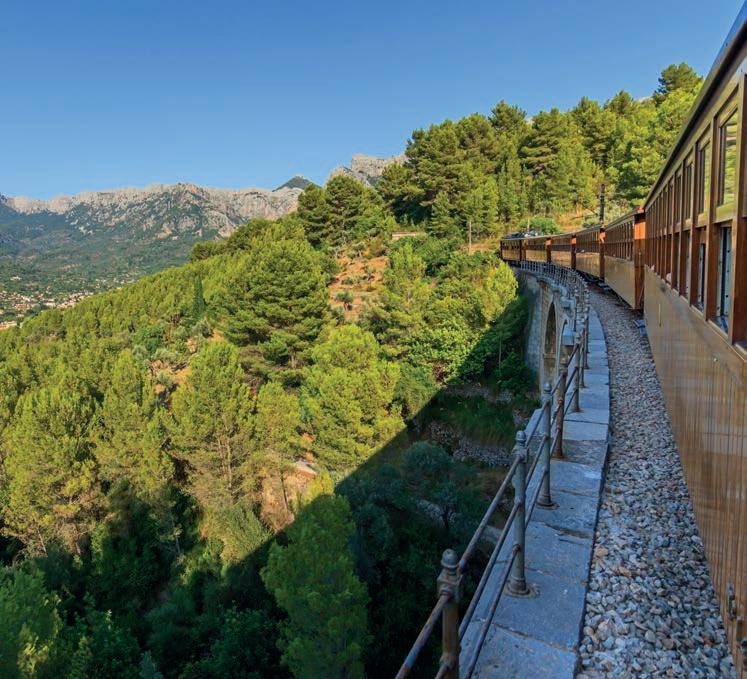
are all included on tours aboard this Belle Époque-inspired train, which runs between March and October.
Over shorter distances, Cercanías trains are handy, regular commuter trains that generally don’t need to be booked in advance. Some routes are particularly picturesque, despite their mostly suburban confines. The train to Monistrol de Montserrat from downtown Barcelona connects to a rack railway that clanks up to the top of Montserrat mountain, overlooking the great city. ⊲
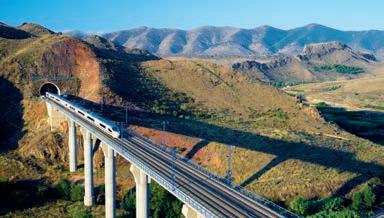

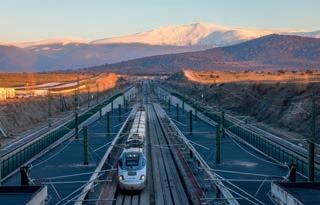
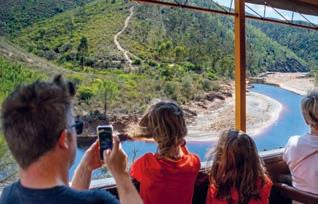



Perfect service (clockwise from top left) Staff distribute local strawberries aboard the Tren de la Fresa; the Ferrocarril Turístico Minero service was once a mining service; the train to Figueras drops you into the world of Salvador Dali; it’s luxury all the way on the Al-Andalus; a high-speed train arrives at Segovia
Through the north of the country, much of the narrow-gauge rail network used by the luxury long-distance trains is also used by local Cercanías AM (formerly Renfe Feve) services. This means you can hop between north coast settlements at your leisure and for less than the price of a cerveza per journey.
Spain is littered with short routes that offer spectacular scenery and connect larger cities to towns that aren’t easy to reach by plane. On the island of Mallorca, the Sóller train from Palma still has leather seats and lacquered wooden carriages. It’s a wonderfully retro affair that lumbers through the Tramuntana Mountains to the attractive coastal town of Sóller. In Andalusia, Intercity trains from Córdoba to Ronda, and between Almería and Granada, pass pretty pueblos blancos before slaloming through the Sierra Nevada.
Elsewhere, Zaragoza lies right in the middle of the high-speed line connecting Madrid and Barcelona. This oft-overlooked city is worthy of a stop in its own right, but it is also a great base from which to take a shorter train journey into the Autonomous Community of Aragon. The hour-long train
ride to Huesca departs from Zaragoza Goya station, which is dedicated to the city’s famous artist. It then passes through the trench-riddled land where George Orwell fought alongside soldiers during the Spanish Civil War – a period depicted in his Homage to Catalonia.
Lastly, in Basque Country, Euskotren links the cities of Bilbao and San Sebastián with the French border town of Hendaye.
Southern Spain has its high-class answer to the north’s Transcantábrico in the Al-Andalus train. Th is seven-day l uxury train ride works its way languidly through the Andalusia sierras and plains between cities of historical and cultural value, including Seville, Córdoba and Granada. Its nickname (‘The Palace on Wheels’) is more than simple hubris. Its carriages were initially constructed for the British royal family, and are said to be among the world’s most spacious. During the trip, you’ll have time to explore the four lounge cars, the ballroom and the dining car.
For a budget-friendlier, go-slow alternative to the Transcantábrico through northern Spain, try taking either the Costa Verde Express, which follows a similar route, or La Robla, which runs through the mountains from Bilbao to León. Both are impressive luxury train experiences offering a shorter three-day itinerary.
A few unique train journeys exist outside of Spain’s main rail network. These are often relics of once popular routes that are now redundant, or simply use infrastructure that was put in place to service heavy industry but is no longer in use. A great example of the latter is the Ferrocarril Turístico Minero in the Huelva province of Andalusia, which runs alongside the beautiful blood-red Tinto River.
Other quirky train journeys include the Tren de la Fresa (the Strawberry Train) from Madrid that runs through strawberry-farming country. Travellers are greeted by stewards serving fresh strawberries as you travel to the UNESCO-listed city of Aranjuez.
For literature lovers, the Tren de Cervantes departs from Madrid for Alcalá de Henares, the hometown of Don Quixote author Miguel de Cervantes. Alternatively, there is a service to the medieval city of Sigüenza that sees passengers joined by staff providing onboard entertainment dressed as knights and princesses. And lastly, the old Tren dels Llacs rattles through the mountainous Catalan Pyrenees, conne cting Lleida with La Pobla de Segur. All of these trains are seasonal, running from spring to autumn each year.
Tickets can be purchased from the websites of Renfe (renfe.com), Ouigo (ouigo.com) and Iryo (iryo.eu), all of which have English-language versions. Renfe runs by far the most extensive countrywide network. As with UK trains, pricing tends to operate on a tiered system, with tickets being cheaper the earlier you book. Outside of national holidays, prices only really start to trend steeply upwards when you’re a week or less from the date of travel. This is particularly true for high-speed trains and longer-distance journeys. Tickets are released up to two months (three months for AVE trains) in advance.
For most local and regional services, you can often only buy a ticket on the day. These are purchased from machines, found either in the station or on the platform, which function in multiple languages (including English). Before travelling on a high-speed route, you must pass your luggage through the station’s x-ray security scanners. Budget some extra time to complete this process ahead of your scheduled train. When on board, the general quality of even the smaller passenger trains is high. For mediumand long-distance travel, your seat will often have a tray table and a plug or USB socket for charging devices. When on a high-speed train, such as AVE or Iryo, check your ticket for the phrase ‘Combinado Cercanías’, which means you’re allowed to take any Cercanías train in the cities of your departure and arrival for four hours either side of your train journey (including Rodalies in Barcelona and Alicante TRAM network trips). In Madrid, Malaga, Valencia and Murcia/ Alicante, you can use the same ticket; elsewhere, present a valid ticket at the ticket office or use the machines at the station to receive a Cercanías pass. If you plan to take multiple longdistance train journeys during your time in Spain, it might be worth considering one of the many rail passes available. Renfe’s Spain Pass is one of the best options, covering four, six, eight or ten single trips on all long-distance trains. Interrail (for EU citizens; interrail.eu) and Eurail (for non-EU; eurail.com) passes are available in Spain, but you must pay additional reservation fees for seats on long-distance trains.
 Ocean bounty In the spirit of celebrating local ingredients, Andalusian chef Ángel León creates innovative dishes using only the fruits – well, the fish, seafood and plants –of the coastal waters near his restaurant, Aponiente
Ocean bounty In the spirit of celebrating local ingredients, Andalusian chef Ángel León creates innovative dishes using only the fruits – well, the fish, seafood and plants –of the coastal waters near his restaurant, Aponiente

A love of the land and exceptional seasonal produce powers Spain’s gastronomic triumphs
Words by Eddi Fiegel

Lauded for the freshness of its vibrant, colourful, healthy produce – from Mediterranean fruit and vegetables to world-class olive oil, outstanding seafood and jamón (dry-cured ham) – Spain’s culinary traditions have also played a key part in the explosion of its restaurant scene.
The World’s 50 Best Restaurants list for 2023 featured no fewer than six Spanish entries, with three in the top five: Barcelona’s Disfrutar, Madrid’s DiverXO and Asador Etxebarri in Basque Country. Spain boasts 271 Michelin-starred establishments, including 15 with three Michelin stars. And many of these top chefs are leading the way in using seasonal local produce.
A deep love of the land and of quality produce is nothing new here. For the Spanish, the idea of savouring exceptional food during leisurely lunches and festive dinners is an essential part of social, family and business life. Good food is not an optional extra but is key to Spanish culture. If you know where to look, you’ll find superb food in cafes and restaurants at all levels, from the humblest tapas bar or beachside chiringuito to Michelin-starred temples of fine dining.
The history of Spanish cuisine
Spanish food wears its history on its sleeve. Look at a list of key ingredients, and you’ll see links to major episodes in Spain’s past. Almonds, saffron and dried fruit were brought to the Iberian Peninsula by the Moors, while conquistadores introduced tomatoes, peppers and potatoes from the New World. Wave after wave of invaders and settlers have left their marks on Spain’s culinary culture, from Greeks and Romans to Phoenicians and Jews. Even the rice used in arguably Spain’s most famous dish, paella, was introduced by the Moors.
Science to savour
Though culinary theatrics are part of the experience at Coque in Madrid, chef Mario Sandoval’s research into sustainable food production and dietary health informs the menu
As with any of the world’s great food cultures, though, Spain’s culinary traditions are inextricably connected to its own land. With both Mediterranean and Atlantic coastlines, and a diverse array of landscapes – from the dramatic peaks and valleys of the Pyrenees and the dry plains of CastileLa Mancha to the lush orange groves of Andalusia – Spain’s climate and topography yields produce as varied as its scenery, creating a rich tapestry of regional dishes. Hearty stews were created to warm the bones in winter, while refreshing gazpacho (chilled tomato-based soup) wards off the heat in summer. Jamón serrano is dry-cured in mountain regions, while fish- and seafood-based cuisine evolved in coastal areas. In short, each place makes the most of what’s available locally.




This buzz phrase of sustainable green cuisine has grabbed global attention in recent years.Yet the concept of using organically and sustainably produced ingredients that have travelled under 100km from farm to fork is as old as the Cantabrian hills.
Wherever you travel in Spain, from the Costas of Catalonia to the Sierras of Andalusia, you need head only a little way off the beaten track in order to find small villages in which residents shop at the community’s food market and prepare traditional dishes using ingredients from local farmers and producers.
That idea has now been recognised as key to sustainability – and Spain’s restaurants are leading the way, with top chefs across the country drawing on their own regional traditions and ingredients, as well as embracing initiatives such as waste recycling and green energy.
No fewer than 49 restaurants across Spain have now been awarded a Michelin Green star recognising sustainable practices. Look out for that designation, and you can be sure you’ll enjoy food that is not only healthy and tasty, but also kinder to our planet.
near Larrabetzu,
Set high on a hillside about 10km east of Bilbao, with floor-to-ceiling glass windows looking out over the countryside, the stylish Azurmendi could almost be a state-of-the-art greenhouse. In fact, this restaurant has won not only three Michelin stars for its seasonal local food, but also a Michelin Green star. Having been named Sustainable Restaurant of theYear in 2018, chef and founder Eneko Atxa advocates “using cooking to achieve a more sustainable, healthy and just society”. Related to that concept, his restaurant is constructed from local and recycled materials, and is powered sustainably. Atxa has also created the largest seed bank in Basque Country in an effort to secure local floral biodiversity. azurmendi.restaurant/en/
Spain’s position at centre stage on the world restaurant scene owes more than a little to the longstanding global reputation of Ferran Adrià and his groundbreaking El Bulli restaurant in Catalonia, which five times secured top spot in the World’s 50 Best Restaurants list. Although El Bulli closed in 2011, Adrià’s legacy endures – notably at Disfrutar, opened in 2014 by ex-El Bulli chefs Oriol Castro, Eduard Xatruch and ⊲






Ideas from the ocean (this page; clockwise from bottom left) Chef Ángel León is hugely serious about the seasonality and quality of his local ingredients harvested from the sea, and has conducted research and lobbying to promote more sustainable food production. Yet once in the kitchen, his culinary inventions are astonishingly playful and creative – take his sea urchins served with sea honey, elderflower and plankton, or the ‘veal shank’ sculpted from tuna, using a juice reduction to make a glaze giving this fish dish the appearance of meat
Mateu Casañas.Taking second place in the World’s 50 Best Restaurants list in 2023, and boasting three Michelin stars, Disfrutar creates dishes combining culinary invention and innovation with a deep respect for ingredients. It also uses 100% renewable energy and adheres to the zero-kilometre philosophy. disfrutarbarcelona.com
Chef and ownerVictor Arguinzoniz grew up with food cooked on open-flame charcoal grills. Now he has refined their use into a fine art – so much so, in fact, that his restaurant was awarded the number-four slot in theWorld’s 50 Best Restaurants list in 2023.
In a stylishly converted stone farmhouse in the tiny Basque mountain village of Axpe, Arguinzoniz uses his personally designed adjustable-heat grills to prepare and showcase local produce.Various types of wood coals are used to grill the diverse different ingredients, imbuing everything from homemade chorizo to buffalo cheese, salted anchovies and tender beef chops with a wonderfully subtle smokiness. asadoretxebarri.com/en/home
Combining theatrical presentation with culinary experimentation – plus the results of research into green methods of food cultivation – Coque has claimed two Michelin stars and a Green star. Set over several floors of a stylishly refurbished nightclub, it’s the brainchild of brothers Mario, Diego and Rafael Sandoval. Many ingredients are sourced from the Sandovals’ own farm, featuring a vegetable plot into which they’ve reintroduced previously forgotten crops.There’s also an agrolab in which chef Mario researches links between sustainable food produce and dietary health.A vegetarian menu is available. restaurantecoque.com/en/
Dubbed the ‘chef of the sea’, Andalusian Ángel León focuses exclusively on ingredients sourced from the brine at his three-Michelin-starred restaurant in the small harbour town of El Puerto de Santa María, between Jerez and Cádiz. He is also considered a leader in the field of sustainable gastronomic practices, both at his restaurant and in creating new food sources and lobbying the EU to allow the human consumption of foods derived from marine microalgae. Aponiente was named Sustainable Restaurant of theYear in 2022, and has also been awarded a Michelin Green star. aponiente.com/en/ ⊲




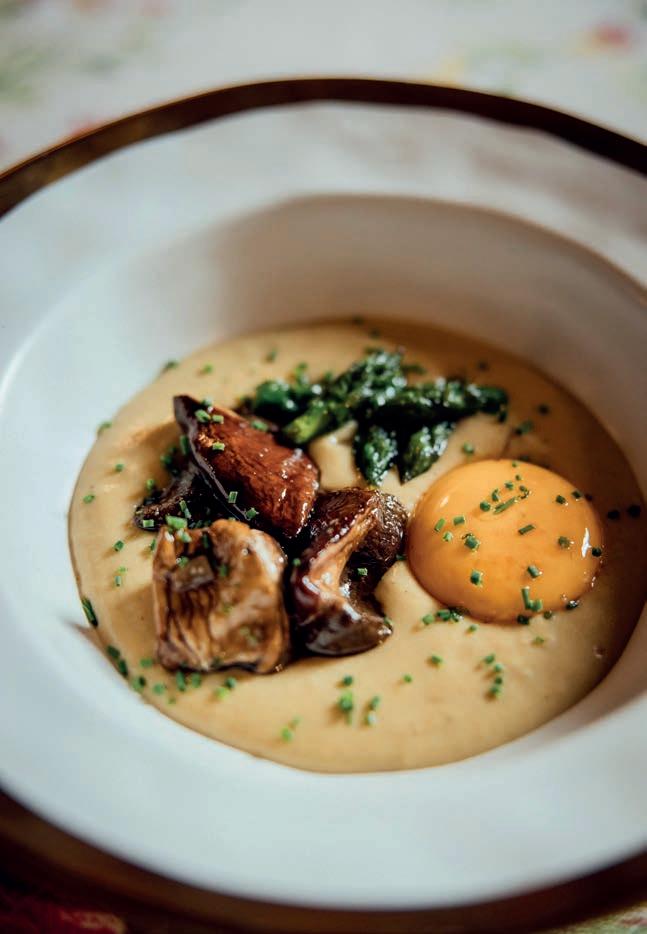
In sync with the seasons (this page and opposite) For sister-and-brother team Esther and Nacho Manzano of Narbasu, showcasing the best of Asturia’s local produce and adapting traditional dishes is key – and that means working with whatever ingredients are available at any given time, many of them sourced from local farmers and producers, or even harvested from their own kitchen garden. Their beautiful restaurant and hotel, housed in a converted 14thcentury mansion between two mountain ranges, wears its sustainability credentials – including a Michelin Green star – lightly and naturally
Housed in a converted 14th-century mansion in a lush, tranquil valley between the Picos de Europa and Sierra del Sueve mountain ranges, sustainability is at the heart of this Michelin Green-Starred hotel and restaurant. Sister-and-brother team Esther and Nacho Manzano champion seasonal cuisine, giving traditional Asturian dishes a contemporary twist. Many ingredients are sourced from the Manzanos’ extensive kitchen gardens, and they also work closely with local farmers and breeders. narbasu.com
El Molino de Urdániz, near Pamplona, Navarre
At this restaurant, housed in a converted stone-built mill in the countryside near Pamplona, sustainability has been a central part of the philosophy since it opened in 2004, reflected in its Michelin Green star (it also has two Michelin stars). Chef and owner DavidYárnoz is proud of the fact that 80% of the restaurant’s suppliers are local, and his menu showcases the wild mushrooms, fish, game and herbs of the surrounding region. The restaurant also takes a green approach to energy and water usage, recycling and waste disposal. elmolinourdaniz.com
Spain has some of the finest food markets in Europe, offering exceptional fresh local produce year round. Few are more alluring than Valencia’s ornate Art Nouveau Central Market – the largest fresh produce market in Europe, and one of the most architecturally impressive. Beneath lofty domed ceilings adorned with brightly coloured stained glass and mosaics, almost 300 stalls are piled high with plump, ripe fruit, leafy lettuces and luscious vegetables, all grown in the swathe of fertile land around the city known as the Huerta mercadocentralvalencia.es
The Spanish tend to eat their meals later than elsewhere in Europe. Lunch is usually served between 2pm and 4pm, and most Spaniards won’t sit down for dinner before 8pm at the very earliest in northern Spain. Evening meals more typically start at 9pm or 10pm at weekends, especially in the south. If you’re booking a restaurant table for dinner, it’s worth bearing in mind that, if you want to eat earlier, you’ll often be eating alone.


 Sail and explore Ferries to Bilbao are an open invitation to explore the towns and villages along the Basque coast, such as Mundaka
Sail and explore Ferries to Bilbao are an open invitation to explore the towns and villages along the Basque coast, such as Mundaka

Travelling from Portsmouth to Santander by sea might not be fast, but it offers something truly precious to travellers: time for reflection
Words by Meera Dattani Ferry to Spain
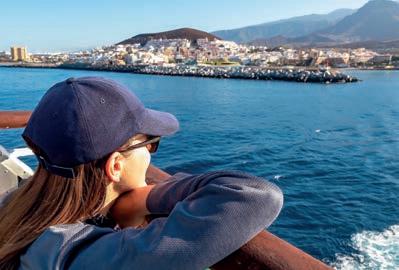

“It’s definitely not the wine,” a fellow passenger told me as they boing-boinged their way along a corridor.We both laughed.This, I came to realise, is the standard ‘ferry walk’ when the sea is, let’s say, at its most playful.You quickly understand why there are handrails everywhere on ferries.
It was my first time travelling to Europe on Brittany Ferries’ overnighter from Portsmouth to Santander: two nights on the way out, one night on the return journey. Check-in, customs and immigration was a breeze, relatively speaking, at Portsmouth Ferry Terminal – certainly less of an ordeal than the standard airport experience. And it was a Friday night, so the onboard bar was already buzzing. Indeed, the spirit of camaraderie on a ferry definitely beats the jostle for overhead cabin space on your average flight.
First things first, I checked out my new home: the Santoña ferry. For the outbound journey, I was in a club cabin complete with window. I’m not sure if there’s anything more pleasing than the sound of the sea as you drift off to sleep, or the sight of waves crashing outside while you’re cosy inside.The cabin and en suite was neat, clean and compact –everything you need and nothing you don’t. There was also video-on-demand and wifi (limited free time, then chargeable).
I headed straight up to the top deck to catch the views and breathe in the night air. It was dark and the skyline was all a-twinkle as we sailed out of Portsmouth harbour and into the English Channel. Back in the Plaza Mayor bar, I sussed out the entertainment programme: there was a morning stretch, trivia quiz, evening cabaret, board games, kids’ craft activities. It was like being at camp – or on a cruise without the commitment, knowing you’ll get off in a couple of days.
Dinner was in the Commodore C-Club Lounge, a perk of the club cabin booking, where food and drink is included.With a limited number of passes for non-club-cabin guests, it’s wise to book early. On entering, I was greeted by a life-size ‘Menina’ sculpture, created by Spanish pop artist Felipao. Inspired by the Baroque painter Diego Velázquez’s masterpiece ‘Las Meninas’ (which resides in Madrid’s Prado Museum and depicts a royal court scene during the reign of King Philip IV), the sculpture is one of several homages to local culture onboard. There’s also a virtual interactive exhibition called the House of Las Meninas to devour.
I helped myself to fresh salad, pasta and wine before returning for coffee and cake. As well as the lounge, there’s also the Azul fine-dining restaurant for three-course meals; Taberna deTapas for, well, tapas, but also
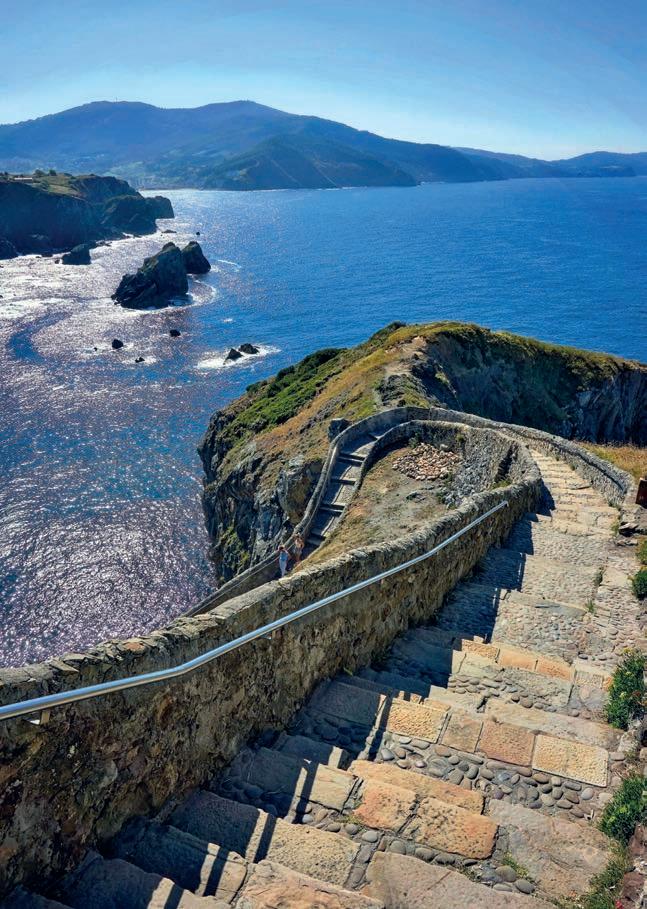


sandwiches, salads, soups, pasta, paella and more; and the Plaza Mayor bar.While the food is reasonably priced, eating onboard can add up, and I soon spotted several passengers cunningly armed with cool bags containing snacks and food that could last a day or so.
As bedtime beckoned, I headed to my cabin with a full belly, navigating the corridors and stairs with my newfound ‘ferry walk’.Wine or waves, who knows? What happens on the Santoña stays on the Santoña
It’s exciting to think that the ferry can arrive directly at the beautiful cities of either Bilbao or Santander. Bilbao is set to a backdrop of green mountains and is home to the iconic Guggenheim Museum.
Santander is home to the grand Magdalena Palace, once Spain’s royal summer residence, and the pleasant Paseo Pereda promenade, which runs alongside the refreshing Pereda Gardens.
In the morning, after nodding off lulled by the rocking of the ship and the sound of the sea, I took a walk around the deck. Surrounded by nothing but the big blue ocean, I realised how frenetic life at home was, and couldn’t remember the last occasion when I felt time move this slowly. Unlike on a flight, you’re aware of every single mile you’re travelling when you’re on a ship; the next moment, you’re downloading an app, tracking your journey and ship-spotting. Later that day, back on the deck, nature treated us to a deep orange sunset, its fiery hues slowly spreading across the sky.
I was travelling at the start of spring, but during the warmer months there’s a good chance of seeing whales. Brittany Ferries is a partner with ORCA, an organisation that protects whales, dolphins and porpoises around the world, and the ferry even includes a dedicated education room.
In-season, there are experts onboard to help you make wildlife sightings, especially in the Bay of Biscay, which is one of the best spots for catching a glimpse of a playful cetacean. In fact, on the return leg, we were treated to a pod of playful dolphins ducking and diving in the waters around the ship. Wildlife aside, the top deck also has an outdoor gym, if you’re inclined to move a little faster. Other facilities on the ship include indoor and outdoor children’s play areas, a Duty Free shop and a new cinema (payable).
It’s tricky to calculate the carbon footprint of a ferry voyage, as it depends on the ferry, its age and the combination of people, cars and cargo. However, the Santoña (which I sailed on) and Salamanca are brand-new ships and the first ferries from the UK to use Liquefied Natural Gas (LNG) instead of
Finding your sea legs (clockwise from right) Jeff Koons’ puppy sculpture stands outside Bilbao’s Guggenheim museum; Santander’s Gothic cathedral survived the fire that destroyed much of the city in 1941; a ferry pulls into Santander after a 33-hour journey from the UK

diesel.This is considered one of the cleaner fuels in the shipping industry; plus, there are also efforts being made onboard to reduce water wastage and single-use plastic.
On overnight ferries, passengers must book a cabin or a lounge seat (which reclines) to travel – there is strictly no sleeping on chairs or loungers, airport-style. Cabins include standard, deluxe and even pet versions, which have an animal bed and are located close to an exercise area (these feature on six ferries, including those on the UK-Spain route).The journey takes anything between 20 and 36 hours, depending on the route taken and the departure time. Ferries usually sail twice a week to both Bilbao and Santander from Portsmouth; two times a week from Plymouth to Santander; and twice a week from Rosslare (Ireland) to Bilbao.
After a second night’s sleep, I awoke to the sounds of ‘Dihun – Le Réveil’ by Carlos Núñez, a track from his Celtic Sea album. This is the ship’s wake-up call on the day of arrival. We were finally in Santander after a day and a half of, relatively speaking, smooth sailing.The city slowly came into view and there was a palpable sense of having ‘travelled’ to get here – even if that ‘travel’ mostly involved eating, drinking and sleeping.
At the end of the day, 33 hours on a ferry might not be everyone’s copa de vino (even if that wine is on tap) – after all, why travel for 33 hours when you could do it in two? But, as a self-confessed productivity fiend who is constantly trying to maximise time,
slowing right down before my escape began in earnest turned out to be a great way to get into the holiday mood.The return journey was just as rewarding, offering a chance to process the trip and quieten the mind before being spat back out into everyday life. There’s a lot to be said for this super-slow-mo way of travel.
Brittany Ferries offers two sailings a week (one or two nights on board) on the following routes: Portsmouth–Bilbao, Portsmouth–Santander, Plymouth–Santander (the shortest crossing; one night each way) and Rosslare (Ireland)–Bilbao. Sample fares from Portsmouth to Santander start from £360 one-way for a car plus two people in an en-suite cabin; foot passengers from £189 one-way with a reclining seat. Club lounge entry is from £35 per person (included with Club cabins). You can book up to ten months in advance via brittany-ferries.co.uk or on the phone (0330 159 7000). If you want to access specific facilities (such as a pet-friendly or Club cabin), it’s worth booking ahead. Early Bird fares apply 60 days or more before sailings, but you can find good deals if you keep an eye on any offers.

Take a look at some of the key projects and initiatives in place to promote a more sustainable way of living and travelling. From improving Spain’s accessibility to preserving ancient Mediterranean seagrass, these projects spotlight how Spain is building travel experiences that benefit the environment and local communities.
 Alamy
Posidonia seagrass is endemic to the Mediterranean Sea and crucial for maintaining a thriving marine ecosystem
Alamy
Posidonia seagrass is endemic to the Mediterranean Sea and crucial for maintaining a thriving marine ecosystem

Discover how Mallorca’s Responsible Tourism Pledge, launched in 2023, aims to protect the island’s natural and cultural heritage while enriching visitors’ experiences
Words by Anna Nicholas What lies beneath The islet of Cabrera, accessible only by small boat, is guarded by the dramatic ruins of a medieval castle. But the real marvels in this Maritime National Park lie below the waves, including Posidonia seagrass and loggerhead turtles
Sun-drenched coastline, pristine waters, mesmerising landscapes, rich cultural heritage – no wonder Mallorca, largest of the Balearic Islands, welcomes millions of holidaymakers each year. Now, in an effort to maximise benefits for communities and reduce the negative impacts of mass tourism, a new Responsible Tourism Pledge has been launched. Here are just a few of its inspirational ideas to help visitors enjoy their stay while preserving the island’s natural beauty and culture.
With its varied landscapes and wild beauty, Mallorca is a playground for hikers, cyclists and nature lovers.The Serra deTramuntana range, the cultural landscape of which is a UNESCOWorld Heritage Site, stretches some 90km just inland from the island’s north-western coast. Encompassing no fewer than 54 peaks over 1,000m, it is also home to diverse plants and animals including the protected and endemic Mallorcan midwife toad and the cinereous (aka black) vulture. Both species had teetered to the edge of extinction two decades ago but, thanks to local conservation efforts, the toad population is thriving and the island now hosts 200 cinereous vultures, including 35 pairs nesting in the Serra deTramuntana.
Hikers can traverse the entire range along the GR221 Drystone
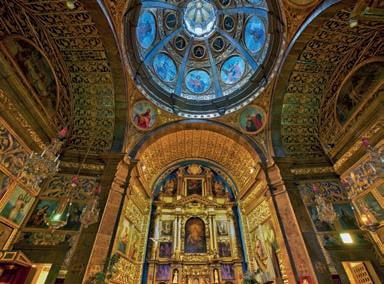
Route.This testing 140km trail takes in such key sights as Lluc Monastery, an important pilgrimage site founded in the 13th century; the SóllerValley, shaded by olive and orange groves; and the Biniaraix Gorge, one of Mallorca’s most dramatic ravines, leading to the turquoise waters of the Cúber reservoir. Hike, cycle or take the bus to stroll alongside this enormous artificial lake, which provides an essential water supply for the island, especially during the dry, scorching summer months.To preserve the range’s delicate ecosystem, stick to designated paths, take away any litter, don’t pick or tread on plants, and avoid disturbing wildlife.


On the north-east coast is tranquil S’Albufera Natural Park. Spanning close to 2,000 hectares, the Balearics’ largest wetland reserve encompasses coastal dunes, marshes and canals. It’s a haven for wildlife including critically endangered European eels; around 303 bird species have been recorded, with some 10,000 birds wintering here.Watch for a host of ducks, kites, herons, shags, egrets, warblers, terns and many more – including distinctive purple gallinules, little bitterns and purple herons – spotted from hides along well marked footpaths. One striking winter visitor is the greater flamingo, which is also found in large gatherings at Salobrar de Campos in the south of the island, where salt flats, reedbeds and brackish water provide
 High and wild (above, clockwise from middle) The endangered Mallorcan midwife toad is making a comeback in the Serra de Tramuntana thanks to concerted local conservation efforts; little egrets are among more than 300 bird species recorded at S’Albufera Natural Park, the Balearics’ largest wetland reserve, spanning some 2,000ha; famed for its vivid turquoise waters and spectacular rock-cradled setting, the Cúber reservoir is a highlight of the GR221 Drystone Route, a long-distance hiking trail snaking some 140km along the full length of the Tramuntana range above Mallorca’s north-west coast
High and wild (above, clockwise from middle) The endangered Mallorcan midwife toad is making a comeback in the Serra de Tramuntana thanks to concerted local conservation efforts; little egrets are among more than 300 bird species recorded at S’Albufera Natural Park, the Balearics’ largest wetland reserve, spanning some 2,000ha; famed for its vivid turquoise waters and spectacular rock-cradled setting, the Cúber reservoir is a highlight of the GR221 Drystone Route, a long-distance hiking trail snaking some 140km along the full length of the Tramuntana range above Mallorca’s north-west coast
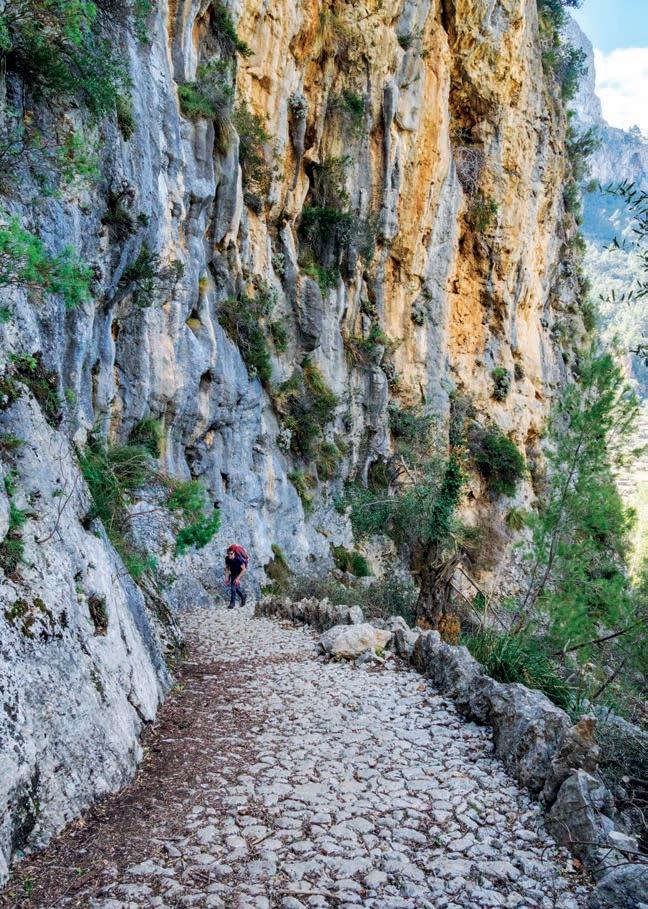



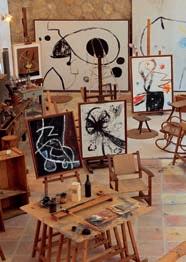

Sensory safari (this page; clockwise from top left) Snail-shaped ensaïmada pastries are among the treats on offer in Palma’s bustling Mercat de L’Olivar; watch for rare cinereous vultures in northern Mallorca; the distinctive round form of 14th-century Castell de Bellver gazes out across Palma’s harbour; tour the artisan pottery workshops of Pòrtol and Sa Cabaneta to admire traditional crockery made with local clay; the Pilar and Joan Miró Foundation in Palma explores the life and paintings of that latter influential artist, who worked and died in Mallorca

excellent conditions for flamingos to overwinter. When visiting either site, keep quiet to reduce disturbance, and don’t bring food or drink into the hides.
Book a guided excursion on the private Ternelles estate on the north coast near Pollença. Here you might see cinereous vulture, booted eagle and Eleonora’s falcon; you’ll certainly visit oak forests, a flour mill and ancient lime kilns. Enjoy views to the medieval Castell del Rei, now home to a vulture colony, and down to the pristine beach, a conservation zone. visitaguiadaternelles.com
For a compact island, Mallorca packs a mighty punch in terms of traditional culture, not least gastronomy and winemaking. A visit to Bodega Ribas – the island’s oldest winery, established in 1711 in Consell – is a wonderful way to explore organic farming and sustainable production methods while also sampling its fine wines. bodegaribas.com
For foodies, a trip to the Mercat de L’Olivar in Palma is a must. At this bustling market, seafood bars stand alongside stalls selling fresh local produce and typical foods such as sobrasada (paprika-spiced pork sausage) and the snail-shaped pastry ensaïmada. Ask stallholders’ permission before taking photos. mercatolivar.com/en/home/
Visit the Teixits Vicens artisan textile factory, established in Pollença in 1854, to learn about the production of traditional Mallorcan flame-patterned ikat fabric. Or follow the Ruta de Fang (Mud Route) through the towns of Pòrtol and Sa Cabaneta, north-east of Palma to visit artisan pottery workshops and buy a brightly painted siurell (whistling figurine) or crockery made with local clay. teixitsvicens.com
Budding archaeologists head to one of the largest and best-preserved Talayotic sites in the Balearic Islands – Ses Païsses, in the eastern town of Artà, a megalithic settlement dating from around 1,000 BC.Visitors are asked to respect the integrity of the site.
In Palma, the Es Baluard Contemporary Art Museum and the Pilar and Joan Miró Foundation attract art-lovers; the latter painter worked and died in Mallorca. esbaluard.org/en; miromallorca.com/en/
Also near Palma is the 14th-century Gothic Castell de Bellver, renowned for its unique circular construction. Set in attractive grounds, it sits high on a hill providing sweeping views to the Mediterranean.


Diverse island (this page; above) The craggy islet of Sa Dragonera, adrift off Mallorca’s south-west coast, is uninhabited – by humans, that is. Visit to amble its rocky paths, watching for birds such as Eleonora’s falcon and keeping an eye out for Lilford’s wall lizard, endemic to the Balearic Islands
Join a workshop to learn traditional weaving with llata, leaves of dwarf palms collected in the island’s east – a craft preserved thanks to the efforts of talented female artisans.This ancient skill, handed down from generation to generation, is centred around the pretty town of Capdepera. laescuelaartesana.com
Discover the thriving biodiversity of the surrounding Mediterranean on a visit to a marine sanctuary. The most important is Cabrera Maritime National Park, protecting an archipelago of islets off Mallorca’s southern coast. Home to some 500 marine species including loggerhead turtles, sea urchins and octopuses, it also attracts diverse birdlife such as falcons and ospreys. Under the waves sway pristine meadows of posidonia – the protected seagrass known as ‘the lungs of the Med’ that produces oxygen, filters pollutants from seawater, and offers shelter to countless marine animals.Take a sailing trip to Cabrera, spotting dolphins en route, and visit the main island’s 14th-century castle, museum and lighthouse, then swim in the famed Blue Cave. Remember to carry any rubbish away with you; if sailing there, don’t anchor near posidonia banks to prevent damage.
The uninhabited islet of Sa Dragonera off the island’s south-west is another exceptional natural park hosting no fewer than 361 plant species, precious posidonia meadows, slipper lobsters, loggerhead turtles and birds such as Eleonora’s falcon and Audouin’s gull. During a walk on the island you’re certain to spot the ubiquitous Lilford’s wall lizard, endemic to the Balearic Islands. Keep to designated paths and avoid disturbing wildlife.
“Under the waves sway pristine meadows of Posidonia – the protected seagrass known as ‘the lungs of the Med’ that produces oxygen”
Head to Palma Aquarium for memorable encounters with sharks, rays and some 700 other fish species, and to learn about the aquarium’s work with rescued loggerhead and leatherback turtles. If you find an injured turtle on a beach, be sure to call 112 for guidance. palmaaquarium.com/en/
Volunteer to join a beach clean-up or one of the scientific marine expeditions run by the Save the Med Foundation, which carries out marine regeneration projects and aims to reduce plastic pollution via education programmes and working with businesses to promote change. savethemed.org/en/ join-us/volunteer/
For more information on the Responsible Tourism Pledge,visit: pledge.fundaciomallorcaturisme.net/en
MMallorca is your temporary home from home, so please don’t leave waste behind in nature, and help us to keep the island clean and litter-free.
AAppreciate and protect natural biodiversity and fragile ecosystems on mountain hiking trails ,and keep coastlines clean. Be careful not to uproot or trample plants.
L
Leave only footprints by opting for cycling, walking or electric vehicles and public transport. Be mindful of water usage.
LLocal matters: support farmers by buying and consuming delicious local produce. Keep the economy buoyant by purchasing handicrafts and goods from markets and island artisans.
OObserve marine life and enjoy underwater activities without harming coral and other marine species. Preserve the marine ecosystem and avoid anchoring your boat near the vulnerable posidonia seagrass meadows.
RRs to save the environment: remember to reuse, reduce, and recycle while in Mallorca. Buy eco-friendly products and carry a reusable water bottle to help decrease the use of plastic packaging.
CCommunities at heart. Show respect for the local community and your neighbours by treating them with kindness and respect. Take time to appreciate the rules of coexistence.
AA wonderful destination. Endorse the Responsible Tourism Pledge, because your support and input really matters. Share your views and sustainable ideas with us to help make Mallorca an even more eco-friendly destination.

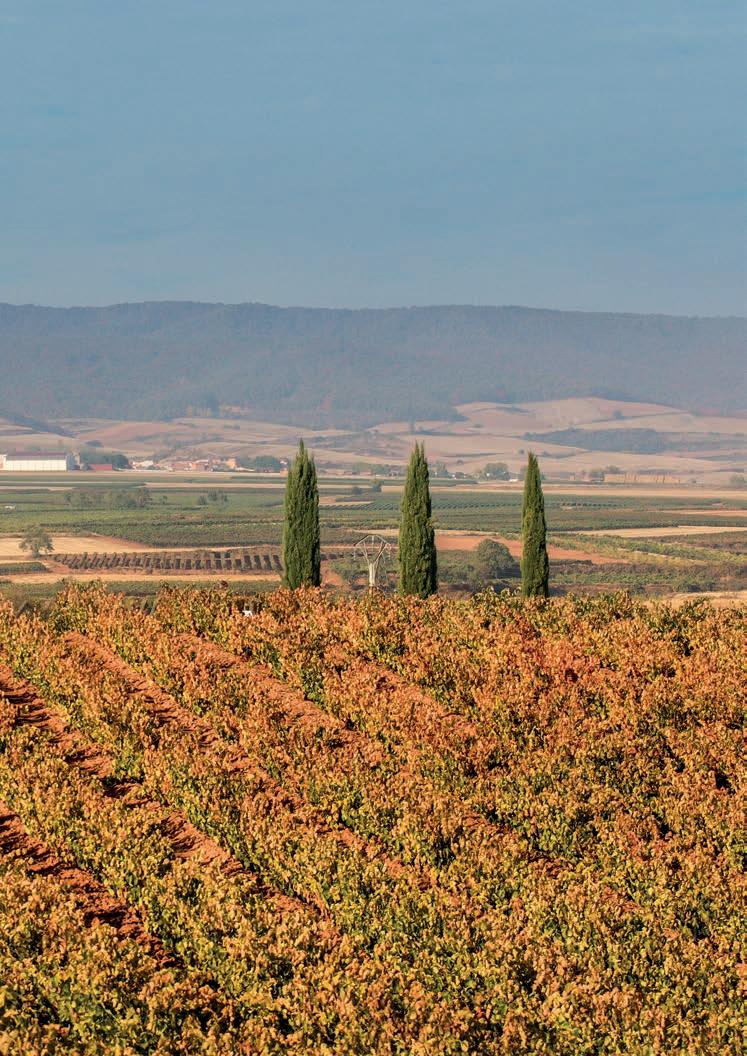
Explore the vineyards in this renowned wine region that are adapting their methods to enhance both nature and local communities
Words by Laura Field




are adopting a host of practices to promote sustainable production, reduce carbon footprints and
include using solar or geothermal energy to control temperatures in wineries; using gravity to move wines, reducing energy usage; planting grape varieties best suited to local environments; using biological controls rather than chemical pesticides in vineyards; and building innovative eco-friendly visitor centres, tasting rooms and other facilities at wineries to minimise energy consumption
Admiring the flavours and textures of a glass of full-bodied Rioja wine is a cherished pastime for many of us. But rarely do we stop to think about where and how the grapes that went into that wine were cultivated, nor how the process of bottling it might have contributed to sustainable rural development, boosting a regional economy.
It’s thought that vines were first introduced to La Rioja by the Phoenicians around 600 BC. So viticulture has been practised in this fertile region of northern Spain for perhaps two and a half millennia.
Today, wineries in La Rioja are prioritising sustainable winemaking that reduces waste, enhances biodiversity and creates economic opportunities for local communities.We’ve gathered stories from just a few of the many wineries in La Rioja that are transforming grape cultivation and processes to ensure that production is as sustainable as their wine is delightful for epicureans who sip the fruits of that labour.
Bodegas Beronia


Focusing on sustainability from the ground up, this winery near Ollauri in the heart of La Rioja Alta was designed to blend in with the surrounding landscape. Partially underground, it uses geothermal energy, has a plant-covered roof, ensures efficient waste management and uses rainwater in its production process. Indeed, it was the first winery in Europe to gain LEED (Leadership in Energy Efficiency and Sustainable Design)V4 certification for its building.The winery is open for tours and tastings from 10am to 3pm, Monday to Friday. beronia.com
This group of sites in northern Spain, named after its flagship winery in Haro, is dedicated to sustainable practices. It’s allocated 16 hectares of vineyards to organic viticulture, and installed shelters for ‘allied microfauna’ such as insects and arachnids that contribute to the longevity of the vines while boosting biodiversity. Energy produced by the company’s solar farm in Álava has reduced CO2 emissions by over 41 tonnes annually. Visit the historic La Rioja Alta, S.A. winery in Haro, La Rioja, to sample the delectable results.Tours in English run at 10.15am Monday to Friday. riojalta.com
Set on an elevated plateau above the Ebro Valley, just outside Logroño, the Campo Viejo winery is a state-of-the-art facility built in 2001 to ensure sustainable production. Its multi-level structure allows for gravity-

Warm welcome (this page) Most wineries in La Rioja offer guided tours and tastings, introducing not only the famed vintages but also their eco-friendly methods, and sometimes showing just how grapes are grown to produce the best sustainable drops
powered movement of wine, thus limiting energy consumption, and social areas are heated using geothermal energy. Bottles for CampoViejo Ecológico Rioja, a blend of Tempranillo and Garnacha varietals, are made with 75% recycled glass and labelled with FSC-certified recycled paper. Campo Viejo was also the first Spanish winery to be certified carbon neutral. Choose from a range of visitor experiences, from an aroma workshop to a cellar tour. visits.campoviejo.com
This winery near the small town of OyónOion belongs to the Familia Martínez Zabala company, owned by sisters Carmen and
Lourdes Martínez Zabala. It was one of the first in the region to be awarded Sustainable Wineries for Climate Protection certification, recognising its holistic approach to sustainable viticulture.This involves the elimination of chemical pesticides in favour of biological controls for vineyard diseases, and adapting the grape varieties selected to grow in a habitat that’s precisely suited to their specific characteristics. Find out more at the new Legacy of Bodegas Faustino visitor centre – designed by Foster+Partners, and consuming only 20% of the energy it generates – and join a tour to learn about the fusion of viticulture, sustainability and nature in La Rioja. bodegasfaustino.com/en

Now the world’s tree-friendliest city, Spain’s capital is combatting overheating and boosting quality of life
Words by Laura Field Green dreams Spanning 125ha encompassing the delicate Crystal Palace, El Retiro park represents the green lungs of central Madrid. But the capital has plans to become greener still, planting hundreds of thousands of trees



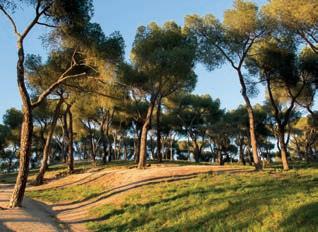
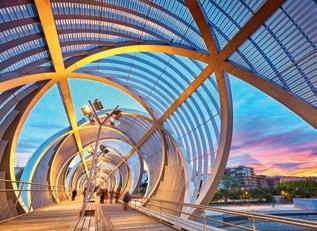 Park life (this page, clockwise from top) Casa de Campo is a sprawling natural space to the west of Madrid, and is the capital’s largest public park; El Retiro Park is packed with historic structures such as the Velázquez Palace, built for a major exhibition in the 1880s; Madrid Río Park is the largest public park in the capital; Dehesa de la Villa park is lined with pine trees; you might catch a glimpse of a red squirrel in one of Madrid’s green spaces; (right page) El Retiro is festooned with kaleidoscopic blooms in spring and summer
156 The Wanderlust Sustainable Travel Guide to Spain
Park life (this page, clockwise from top) Casa de Campo is a sprawling natural space to the west of Madrid, and is the capital’s largest public park; El Retiro Park is packed with historic structures such as the Velázquez Palace, built for a major exhibition in the 1880s; Madrid Río Park is the largest public park in the capital; Dehesa de la Villa park is lined with pine trees; you might catch a glimpse of a red squirrel in one of Madrid’s green spaces; (right page) El Retiro is festooned with kaleidoscopic blooms in spring and summer
156 The Wanderlust Sustainable Travel Guide to Spain
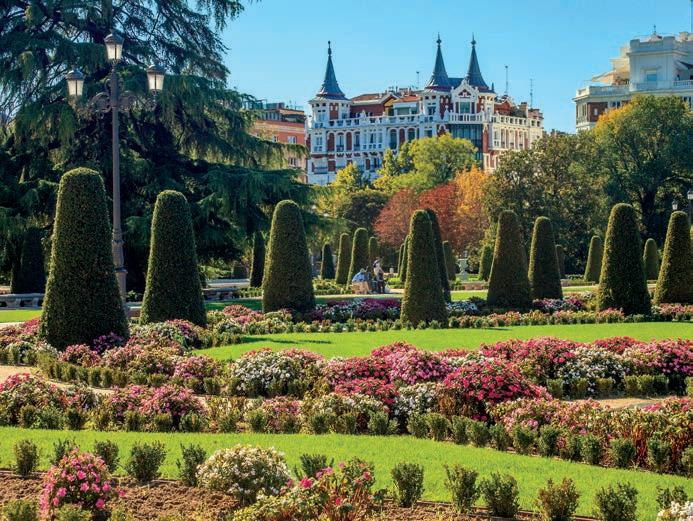
Many cities claim to be ‘green’ – but none walk the talk quite like Madrid. Named Tree City of the World for five years in a row, as recognised by the UN’s Food and Agriculture Organization, Spain’s capital planted 210,000 trees in just four years between 2019 and 2023 – and plans are in the works to plant another 500,000 trees over the next few years.
So why the push to plant?Well, the benefits of all this greenery are manifold. For starters, it’s much more enjoyable – for visitors and residents alike – to stroll around a city with so much refreshing foliage. Such swathes of greenery provide shade from the intense sun and heat prevalent in the warmest summer months, when the mercury can climb above 35°C.
Of course, trees are also vital for cooling temperatures globally and locally. On a large scale, they absorb carbon dioxide from the air and release oxygen. But trees also
transpire – they absorb water through their roots and then release it as vapour, which cools the surrounding air.
The capital’s ongoing commitment to increasing the number of green spaces is evident in projects such as the Madrid Nuevo Norte development, set to create a Central Park revolving around the Wind Garden, an extraordinary spiral green structure creating its own microclimate. This expansive public space, currently being created, will encompass over 14 hectares of greenery in northern Madrid, with trees planted over the train tracks of Chamartín station.The wider Nuevo Norte project aims to increase biodiversity by encouraging the pollination of flowers, and to provide better conditions for pedestrians throughout the
changing seasons, to improve social cohesion and unite surrounding neighbourhoods in the north of the city.
Diversity is key in urban areas as well as the countryside, and Madrid is home to numerous types of tree, including arbutus, poplar, acacia, elm and cypress, as well as shrubs such as oleander and regionally native species like the Iberian holm oak.
“Swathes of greenery provide shade from the intense sun and heat prevalent in the warmest summer months in the Spanish capital”
Even in such a vibrant and energetic city, you can find tranquillity in Madrid’s green spaces –ambling around the parks of El Retiro, the Casa de Campo or the Dehesa de laVilla, for example.These urban mini-wildscapes are important havens for animals such as magpies and squirrels. In short, Madrid’s abundant trees help to break up the urban environment and breathe green life into Spain’s capital city.


Sea of cloud (left) Spain’s highest mountain – and the world’s third-highest volcano – 3,718m Mount Teide dominates its namesake national park in the heart of Tenerife, drawing hikers and nature lovers; (right) pilot whales are among the 20-odd species of cetaceans recorded in the waters around Tenerife
On the largest Canary Island, sustainable tourism initiatives aim to preserve the beauty of its volcanic peaks, forests and waters bustling with life
Words by Robin McKelvieTenerife is a clean, green oasis in the Atlantic, blessed with a wealth of flora and fauna. Despite the effects of largescale tourism in places, much of the island is more Jurassic Park than theme park: an ancient wilderness of active volcanoes and swathes of ancient forest. This wildscape needs protection, though – and Tenerife has emerged as a pioneer in eco-tourism and sustainable development, with a whopping 48% of the Canary Island protected for nature.
In 2021, Tenerife was named a UNESCO Biosphere Destination. Together with the Island Council of Tenerife – the island’s most senior government body – and Turismo de Tenerife, local volunteer groups contribute to a model of circular tourism.
Tenerife’s Strategic Plan for Biodiversity 2020-2030 aims to develop tourism while conserving the island’s 887 endemic plant species – among more than 10,000 wild species that thrive here. And in 2020, a Charter for the Sustainability of Activities in Nature was launched, aiming to help local businesses improve the quality and sustainability of nature-based tourism.
One great NGO promoting sustainable tourism in the Canary Islands is Canary Green. As well as producing the Discover travel guide and Greenscape travel magazine sharing ideas for visitors, it offers opportunities for volunteers to get stuck in. canarygreen.org
Indeed, Tenerife offers many chances to engage with the island’s plants and wildlife while supporting conservation and putting money back into fragile communities, in turn enabling them to engage with sustainability.
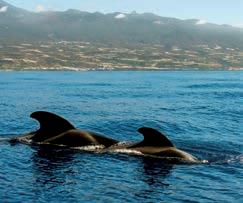
Tenerife is a pioneer in sustainable marine tourism. In its waters you might encounter cetaceans ranging from dolphins to pilot and humpback whales, with the volcanic island providing a spectacular backdrop to any whale-watching excursion.
Take the Teno-Rasca marine strip, stretching for over 22km along Tenerife’s west coast. This 70,000-hectare expanse was declared a Special Area of Conservation in 2011. In fact, the wider Tenerife-La Gomera Marine Area that encompasses the strip has been designated a marine Hope Spot by the international organisation Mission Blue, and a Whale Heritage Site by the World Cetacean Alliance – reflecting the fact that around 20 of the world’s 90-ish cetacean species have been spotted in these waters.
Protection of the island’s marine mammals is bolstered by Tenerife’s Sustainability Charter for Whale and Dolphin Watching, a voluntary commitment by local tour operators to respect marine species

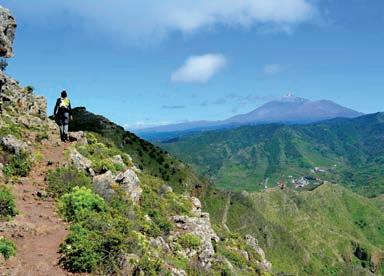



and the environment while ensuring a firstrate visitor experience that educates guests on sustainability. By the end of 2022, 18 companies using more than 20 vessels had signed up to the charter. Look for the ‘blue boat’ logo to book with one of these companies and be sure you’re helping to preserve the marine environment.
Tenerife has a network of well-marked, world-class walking trails totalling over 1,000km, accessing spectacular scenery and enabling adventurous travellers to hike through ancient forests, up ridges and to the tops of active volcanoes, viewing the island’s wealth of flora and fauna in a sustainable way. New trails are regularly developed and existing ones improved, so there is always something new for repeat visitors.
The highlight of Spain’s most-visited national park is mighty Mount Teide, the country’s tallest peak and the world’s third highest volcano at 3,718m.Teide last erupted in 1909, and today its activity is closely monitored.This hulking volcano looms over the core of its eponymous national park – a UNESCO World Heritage Site, with 41 hiking trails stretching over 190km. Most visitors take the cable car up to 3,555m, but hikers can apply for permits to continue to the summit; for an unforgettable experience, stay overnight at the Altavista Refuge (3,260m), then ascend to witness the most spectacular sunrise.
This UNESCO Biosphere Reserve at the island’s northernmost tip is truly remarkable. Here you can hike through ancient laurel rainforests and see how nature is protected alongside farming and fisheries, ensuring harmony between communities and the natural world. New development is strictly controlled, with redevelopment of existing structures encouraged. It’s accessible on a day trip but, to experience its beauty in more depth and to contribute directly to local communities, stay in the park. By hiking on the marked trails and spending money here, you’ll help secure its future. For a fabulous day excursion, walk down through Anaga’s craggy ravines and catch a boat back to Santa Cruz de Tenerife, watching for marine mammals en route.
At this UNESCO Biosphere Reserve in the

far west of the island, the needs of the local population are woven into conservation initiatives. Choose from 13 hiking trails guiding visitors through this fragile wild world in a way that brings money to local communities.Teno’s spectacular landscapes encompass sheer emerald valleys, sweeping ridges, rugged cliffs and thick laurel forests. Top hikes include the Masca Valley,Teno Alto Circular and the El Palmar Valley. Look out for the soaring red flower spikes of the tajinaste plant and the purplish neck and orange eyes of the laurel pigeon – both endemic to the Canary Islands. By sticking to the trails and spending money locally, you’re helping tourism support communities, allowing them to survive without encroaching on nature.
Tenerife’s rich bounty of fresh local produce is rightly lauded, and you can enjoy it in restaurants, shops and markets across the island.What you might not realise, though, is just how sustainable and eco-friendly much of it is.
A shining example of this is Finca La Calabacera, a farm near Playa San Juan in the island’s west, which has an impressive and unwavering dedication to ecological farming.This family-run oasis also works hard to preserve sustainable techniques for future generations, using organic farming techniques and avoiding unnecessary waste.The result is a range of delicious and healthy fruits and vegetables.

Food scraps are recycled as rich compost to fertilise crops. Chickens are regularly rotated around the farm to spread natural fertiliser. Other simple actions result in big pay-offs, such as placing netting over plants to fend off damaging insects without the use of pesticides.
Real thought goes into the entire process – water is conserved through a dripping irrigation system, which nourishes the famous plantains while reducing water consumption. Look for the finca’s products in local supermarkets, in restaurants and at weekly markets in Playa San Juan and Alcalá, a little to the north. gourmetslacalabacera.com
Tenerife’s ‘eternal spring’ climate makes it a tempting destination year round. In summer, trade winds help keep temperatures cooler than in mainland Spain, though hikers may want to avoid the hottest months of June, July and August. Winter is glorious, with temperatures typically above 20°C.
Several airlines serve Tenerife from the UK, with easyJet (easyjet.com) alone flying from nine UK airports in around four to five hours. Fred Olsen Express (fredolsen.es) and Naviera Armas (navieraarmas.com) sail to Santa Cruz de Tenerife from Huelva in around 38 hours; the voyage from Cádiz with Transmediterranea (transmediterranea.es) is a little longer.
The world’s second largest Carnival sets the island alight for 15 days each year, usually in February, with the hottest action taking place in the capital, Santa Cruz de Tenerife.
Further information www.webtenerife.co.uk
Protected for life (this page; above) The jagged ridges of Anaga Rural Park rise within a UNESCO Biosphere Reserve at Tenerife’s northern tip; (below) the rare endemic Tenerife blue chaffinch, a must-spot for avid birdwatchers, is found in the Canarian pine forests surrounding Mount Teide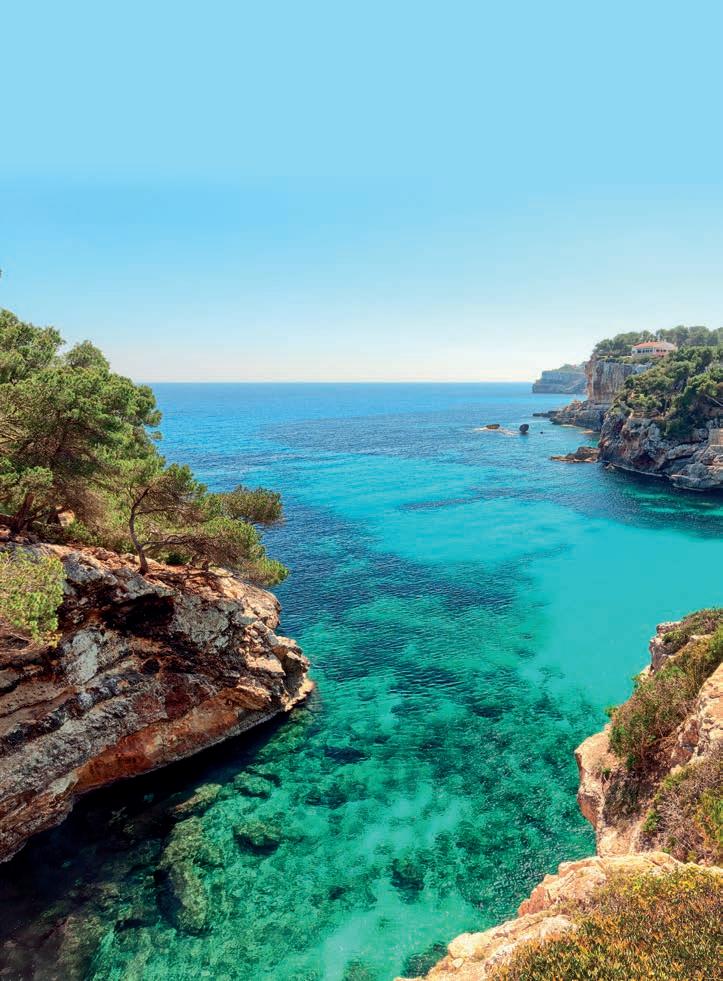
Spain is making great strides in ensuring that cities, museums, beaches and islands are accessible to people with limited mobility or other kinds of disability
Words by Laura Timm
Spain remains the number-one holiday destination for British travellers. Now the Spanish Tourist Office has launched its Spain for All campaign, promoting accessibility and diversity throughout the country.
What is the Spain for All initiative?
At the heart of the campaign is a commitment to improve accessibility and promote social inclusivity in the country’s tourism sector. Involving government agencies, tourism boards and local communities, this initiative is not just about meeting regulatory requirements. It intends to create an environment where everyone can fully participate in and enjoy the wonders of Spain – regardless of ability.
Manuel Butler, Director of the Spanish Tourist Office in the UK, stated that the aim is “to create geographic and economic sustainability with a socially inclusive tourism model that spreads the benefits around the country, 365 days of the year”.
How will this work in practice?
The first phase of the Spain for All initiative includes establishing an advisory panel to gather industry feedback, in order to pinpoint key challenges and opportunities. Holidaymakers can find support and information through Spain is Accessible, an online platform endorsed by Spanish institutions to standardise accessibility criteria across various sectors. It provides information on culture, food and nature, as well as support for visitors with disabilities, allowing them to plan their trips with ease. Simply filter by tourist destination, theme or type of disability to find all the information you need. spainisaccessible.com
All airports in Spain offer free assistance services for people with reduced mobility or with mental, hearing or visual impairments. The form to request this assistance is available in Spanish and English on the website of the airport operator Aena, where you’ll also find information on meeting points and details specific to each airport. On arrival at a terminal, an assistant will be available to offer support throughout check-in, security control, boarding, disembarking and baggage collection. aena.es
Are the big cities set up with accessible infrastructure?
Spain has been proactive in implementing accessibility regulations and ensuring that public spaces, transport systems and accommodation options are designed to ⊲
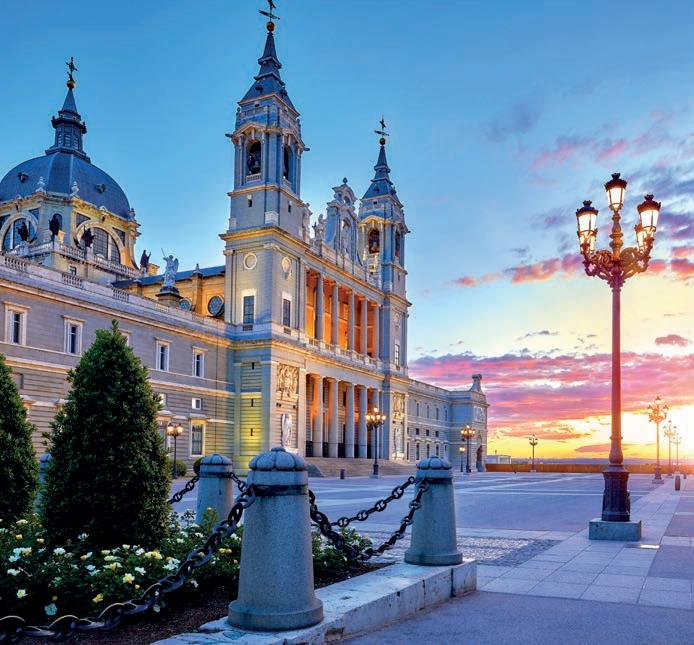
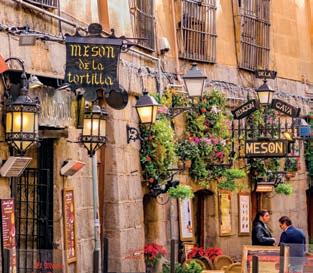
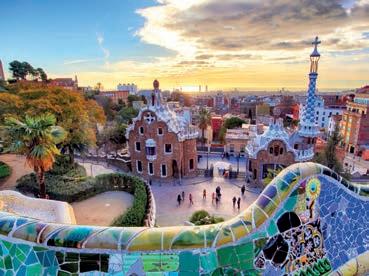
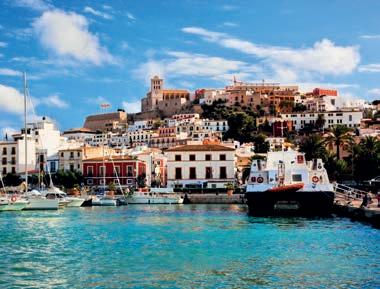 Access all areas (this page; clockwise from top left) Madrid’s Almudena Cathedral has ramps and wheelchair-accessible lifts; Barcelona’s colourful and curvaceous Parc Güell, designed by renowned Catalan architect Antoni Gaudí, has a wheelchair-friendly route visiting its most iconic sites; the capital’s streets are mostly flat, with audio signals at crossings; (opposite page; clockwise from top left) streets and public buildings in Eivissa (Ibiza Town) are largely accessible; 26 of Ibiza’s alluring beaches are now accessible to people with reduced mobility; Barcelona’s Metro train system is almost entirely wheelchair-accessible
164 The Wanderlust Sustainable Travel Guide to Spain
Access all areas (this page; clockwise from top left) Madrid’s Almudena Cathedral has ramps and wheelchair-accessible lifts; Barcelona’s colourful and curvaceous Parc Güell, designed by renowned Catalan architect Antoni Gaudí, has a wheelchair-friendly route visiting its most iconic sites; the capital’s streets are mostly flat, with audio signals at crossings; (opposite page; clockwise from top left) streets and public buildings in Eivissa (Ibiza Town) are largely accessible; 26 of Ibiza’s alluring beaches are now accessible to people with reduced mobility; Barcelona’s Metro train system is almost entirely wheelchair-accessible
164 The Wanderlust Sustainable Travel Guide to Spain

serve people with diverse needs. Cities such as Madrid and Barcelona, for instance, have made great strides in ensuring the accessibility of their metro systems, with ramps, lifts and tactile paths making it easier for visitors with mobility challenges to get around on these networks.
Most of Madrid’s main attractions are wheelchair accessible and offer wheelchair rental services. Streets are largely flat, with ramps at most junctions.To further assist pedestrians, audio signals are installed at all crossings.
Barcelona is widely regarded as one of the most accessible cities in the world, especially in terms of public spaces and streets. Car-park entrances are designed to be unobstructed, and most streets are wide enough for wheelchair users.The city also has an extensive range of social services that provide advice, assistance, information, and financial support for people with disabilities.
How accessible are the beaches, attractions and roads on the Costa del Sol?
This stretch of the Andalusian coastline is renowned for its spectacular shorescape – and for its accessible beaches for visitors with disabilities. Misericordia Beach in Málaga is one of the best in this respect, catering not only to visitors with mobility restrictions but also to those with visual and hearing impairments. It offers reserved parking, access ramps, boardwalks, amphibious chairs, accessible toilets and showers, and

dedicated support staff. Other features include a beach totem, marine information beacons, distress beacons, and a waterproof transmitter clock.
Most attractions, restaurants and streets on the Costa del Sol are now disability friendly, ensuring an enjoyable visit for all. Shopping centres, too, are wheelchair accessible and offer reserved parking close to the entrance.
How about the islands?
Spain’s two archipelagos, the Balearic Islands and the Canary Islands, are particularly attractive holiday destinations for British travellers.With their spectacular landscapes and postcard-perfect beaches, these islands have long been a magnet for visitors seeking both adventure and relaxation. And accessibility in both island groups has improved enormously.
Are the Balearic Islands accessible?
To ensure accessibility for all in the Balearic Islands, amphibious chairs and crutches, accessible walkways and ramps have been introduced at beaches such as Es Pujols on Formentera and on Palmanova and Alcúdia, Mallorca. All of the islands also offer accessible hiking trails for visitors with reduced mobility, including the Finca Pública de Galatzó estate in the heart of the Serra de Tramuntana range, and the historical Camí de Cavalls trail that winds around the coast of Menorca.

In addition, cultural attractions such as the Museo Puget in Ibiza and the Balearic Museum of Natural Science in
Mallorca have installed wheelchair ramps, audio and sign guides, and tactile exhibits to facilitate communication.
Making a concerted effort to improve accessibility, the Canary Islands are being transformed to make it easier for everyone to discover their beauty. From accessible beach ramps to adapted accommodation and wheelchair-friendly hiking trails, the major islands of Tenerife, Gran Canaria and Lanzarote are leading the way.
One shining example is Lanzarote’s Timanfaya National Park, a UNESCO Biosphere Reserve renowned for its lunarlike landscapes.Thanks to recent accessibility improvements, such as adapted transport, accessible viewpoints and guided tours with trained staff, visitors with mobility challenges can now explore this natural wonder with ease.
Efforts aren’t just about improving physical accessibility – they also aim to create a welcoming and inclusive atmosphere. Local businesses and adapted holiday providers such as LanzAbility in Lanzarote cater to the diverse needs of holidaymakers, offering unique experiences such as scuba diving and parasailing for wheelchair users.
“True accessibility entails two key elements: having adapted infrastructure across all areas of life, and focusing on your abilities, not your disabilities,” said David Penney, founder of LanzAbility.
To plan a fully accessible holiday in Spain, visit Spain is Accessible to read about wider accessibility provision across the country, or get in touch with local adapted holiday providers such as LanzAbility. lanzability.com


The Balearics might be better known for nightlife and pristine beaches, but Ibiza and Formentera’s aquamarine waters also hide one of Europe’s most delicate – and under-threat – ecosystems
Words by Isabelle Kliger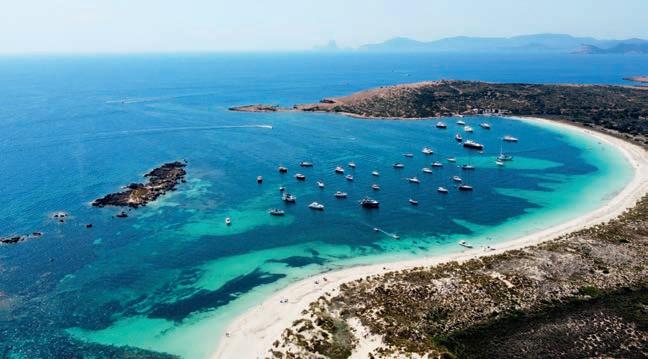


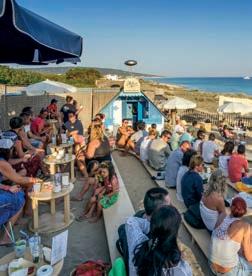

If you have been fortunate enough to visit the Balearic Islands, you may have found yourself wondering what makes the powder-sand beaches and crystal-clear waters surrounding Ibiza and Formentera quite so postcard-perfect. Part of the answer can be found in an unassuming-looking seagrass with a suitably grandiose name: Posidonia oceanica, or neptune grass.
Contrary to popular belief, posidonia is not an alga, but rather a marine plant, complete with a root, stem, leaves, fruit and flowers. It forms expansive, swaying seagrass meadows that can be found between the water’s surface and depths of up to 40m, such as those located off the coasts of Ibiza and Formentera, where 55,795 hectares of endemic posidonia play a crucial role in the Mediterranean ecosystem.
While this seagrass is little thought of by most travellers here, it is the engine behind much of what you see – and is finally being recognised as such.The meadows found in the Ses Salines Natural Park that spans the waters off Ibiza and Formentera are thought to be some 200,000 years old, and scientists say that they may even be among the planet’s oldest living organisms.They were declared a UNESCO Biodiversity and Culture MarineWorld Heritage site in 1999. It’s what posidonia does that makes it so important. It plays a huge role in helping to maintain the quality and oxygenation of the Balearic Sea by filtering sediments and giving the water its exceptional transparency.The meadows also provide a home to a complex marine ecosystem of more than 400 species of marine plants and 1,000 species of marine animals – from molluscs and fish to spiny crustaceans, echinoderms and gentle sea turtles. For travellers, this is its biggest appeal.The visually stunning treasure trove of colourful plant life and
fascinating sea creatures makes this corner of the Mediterranean a must for divers and snorkellers.
But posidonia isn’t just a unique environment to explore, it has plenty of wider-reaching effects too. Its stray leaves form barriers that shield the coastline from the impact of storms, preventing coastal erosion and helping to maintain that famously beautiful white Balearic powder sand. At the same time, it is a key weapon in the fight against climate change. A hectare of posidonia can store 15 times more carbon than a similar area of Amazon rainforest.
Posidonia plays a vital role in maintaining the appeal of Ibiza and Formentera, putting them among Europe’s most desirable beach and water-sports destinations and contributing to the economy of the Balearic archipelago. Sadly, this popularity also explains why a fragile ecosystem now finds itself under threat. In addition to climate change, which is slowly heating up the Mediterranean to the point where it may no longer be able to support the posidonia, tourism threatens its very existence. Marine pollution, bilge water discharge and the anchors from boats – which sweep the seabed clean, pulling up entire meadows – are some of the greatest threats to the seagrass beds, as are the wider fishing practices within the region.
raised go exclusively to the conservation of the posidonia. Each one-euro contribution is used to preserve a single square metre of these undersea meadows, and donors can choose whether or not they wish to be named in the official list of sponsors.
The Island Council of Formentera has also passed a ‘Posidonia Law’ to manage human activity, so as not to further damage the seagrass. A limit has been put on the number of cars allowed on the island in summertime, and buoys have been strategically placed to help boaters avoid the meadows. An anchoring patrol is also helping to educate sailors and uphold the rules at sea.
“A hectare of posidonia can store 15 times more carbon than a similar area of Amazon rainforest”
In addition to sponsoring the project, you can also do your bit to protect this endangered seagrass while on dry land in the Balearics. Reducing water and energy consumption, avoiding single-use plastics, never throwing waste in the sea and making sure to only anchor in clearly designated places are just some of the ways to ensure your visit to the islands doesn’t negatively impact its posidonia meadows.
In 2017, the Save Posidonia project was launched. Supported by the Island Council of Formentera, this fundraising programme seeks to promote sustainable tourism and to protect and preserve the seagrass meadows. Donations are welcomed and all funds
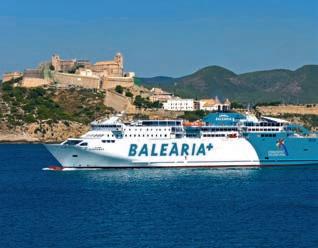
Last but not least, when visiting Ibiza and Formentera, you can opt to spend your hard-earned cash within the network of hotels, restaurants, cafés, bars and shops that have pledged to dedicate a portion of their profits to the Save Posidonia project. Examples include the Trasmapi ferry company that transports travellers between Ibiza and Formentera, the Beso Beach club in the Ses Salines Natural Park, the Blue Bar beachfront Mediterranean restaurant and the ultra-chic Gecko Hotel and Beach Club. Visit saveposidoniaproject.org/en/


Stories and insights from the people behind a variety of sustainable travel experiences in Spain. From a flamenco dancer to a birdwatching guide, these sustainable travel pioneers share what’s so special about their country and their passions.
 Sara Baras is a renowned Spanish flamenco dancer and choreographer
Sofia Wittert
Sara Baras is a renowned Spanish flamenco dancer and choreographer
Sofia Wittert
Interviewed by Russell Maddicks
Francisco Contreras Gil, known to his friends as Fran, is a journalist, radio reporter, broadcaster and author who has been exploring the history, legends and mysteries of Spain for over 30 years. His book, Guía Mágica del Camino de Santiago ( Magical Guide to the Way of St James), takes readers to the heart of the most important pilgrimage route in the world – the trail leading to the shrine of Saint James in Santiago de Compostela, representing a model of sustainable tourism since the Middle Ages.
When did your relationship with the Camino de Santiago begin?
Twenty years ago I was working for the national radio station Cadena SER on a popular programme called Milenio 3 , which investigated the world of mysteries. I was inspired and proposed that we should produce a special programme on the Camino de Santiago. Throughout its history, the Camino has been a sacred route for pilgrims seeking a transformative connection – with their religion, with nature, with themselves. The Camino de Santiago was the world’s most important pilgrimage route in medieval times, and this is still the case today in the 21st century.
So you decided to walk the whole Camino, and make a programme about your journey?
Yes – to report on the day-to-day reality for a pilgrim walking the route. In October 2004, I set out on a 900km journey on foot, which took me 40 days to complete. Each day, I recounted my own experiences – but also the legends, secret histories and folk tales of the places through which I had passed.
You have since walked those same kilometres many times –but what was that first experience like?
It was a journey that transformed my life. The Camino goes way beyond the physical effort of trekking long distances or hiking over mountains. It is an experience that affects you as a human; it is spiritual and meditative. As you walk, you meet other pilgrims; many people form lifelong bonds. But it also connects you with all who have trodden these ancient paths over the centuries, right back to the Neolithic nomads, Celts and Visigoths who roamed these lands.
It also led to various reports and books you’ve written since... It opened up a fascinating treasure trove of amazing stories, both ancient and modern, to discover and write about. Walking the full length of the Camino Francés, you pass through five autonomous regions – virtually the width of northern Spain, an area packed with incredible legends, historic places to visit, amazing people to interview, and some of the best food and drink you will find anywhere in Spain.
How many times have you walked the Camino de Santiago since that first hike in 2004?
It’s important to remember that there are many Caminos de Santiago. For me, the genuine path is the Camino Francés (French Way), which starts near the French border in Roncesvalles in Navarre. Alternatively, you can start in Jaca in Aragon, and join the Camino Francés in Puente la Reina. From Santiago de Compostela, it continues to Finisterre on the Galician coast. I have walked this route 13 times.
Pilgrims’ progress Twelve centuries after the first pilgrim reached Santiago de Compostela, more than 400,000 people complete the journey each year, the majority of them following the Camino Francés (French Way) across northern Spain

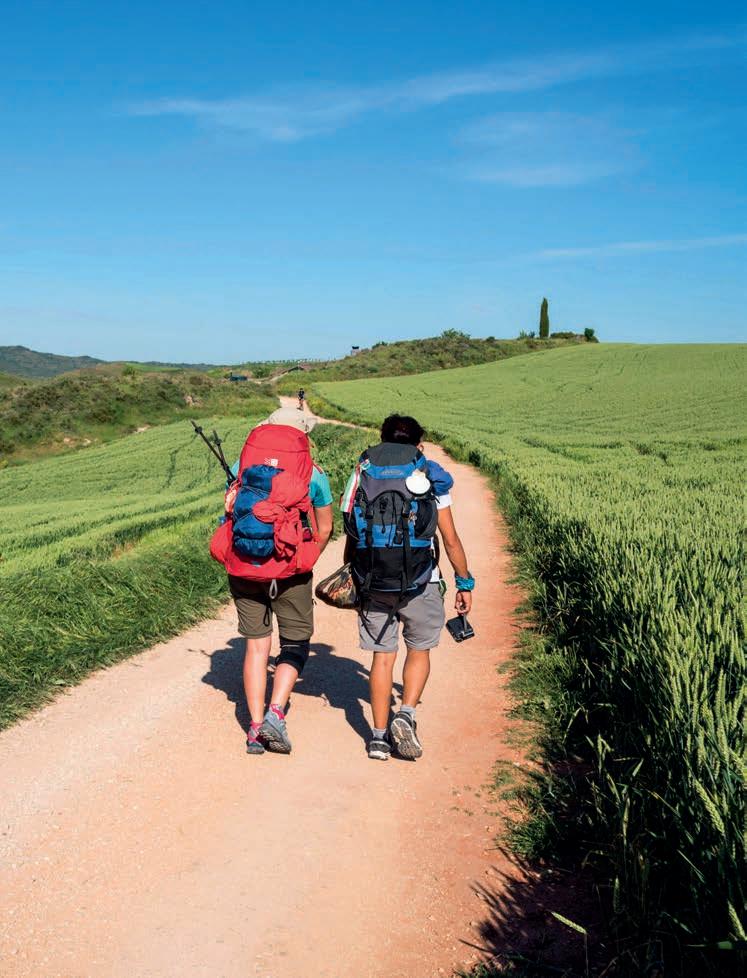
 Many ways, one destination (this page) The Camino de Santiago is not one route but many throughout Europe, all ending at the magnificent cathedral in Santiago de Compostela, home of the reputed remains of Saint James the Apostle; (right page; top–bottom) pilgrims encounter countless historic sites en route, including the 11th-century Puente la Reina bridge in Navarre; Camino variants are well served with albergues (pilgrim hostels) and other places to stay and eat; Fran on one of the group tours to key places along the Camino that he organises; all Camino trails are waymarked with the distinctive scallop-shell symbol
174 The Wanderlust Sustainable Travel Guide to Spain
Many ways, one destination (this page) The Camino de Santiago is not one route but many throughout Europe, all ending at the magnificent cathedral in Santiago de Compostela, home of the reputed remains of Saint James the Apostle; (right page; top–bottom) pilgrims encounter countless historic sites en route, including the 11th-century Puente la Reina bridge in Navarre; Camino variants are well served with albergues (pilgrim hostels) and other places to stay and eat; Fran on one of the group tours to key places along the Camino that he organises; all Camino trails are waymarked with the distinctive scallop-shell symbol
174 The Wanderlust Sustainable Travel Guide to Spain
Have you walked any of the other Caminos to Compostela?
I have explored many Caminos. I have walked the 1,000km-plusVia de la Plata (Silver Way), which starts in Seville in southern Spain and follows an old Roman road to Gijón on the north coast. I have also followed the popular Camino del Norte (Northern Way) along the coast flanking the Bay of Biscay; the Camino Portugués (Portuguese Way); and the Camino de San Andrés, which ends at the church of Saint Andrew in the historic, misty and magical village of San Andrés de Teixedo in far northern Galicia. One of my favourites is the oldest of all, the Camino Primitivo (Original Way) from Oviedo to Santiago.
“The Camino de Santiago has been the model for responsible tourism since medieval times – maybe even the first form of tourism”
he told the local bishop.The two of them went to the forest, where they unearthed a tomb.There were no written records of who was buried there but, using ‘divine science’, they inferred that the tomb was that of Saint James the Apostle, one of Jesus’ 12 disciples. According to tradition, after his martyrdom his remains had been carried from the Holy Land to the Iberian Peninsula.
What led you to publish your book GuíaMágicadelCamino deSantiago?
I had all these stories, and practical experience of walking the Camino, so I put them together in a book that explains the different Caminos. The book provides maps, detailed daily itineraries and lists of albergues (hostels for pilgrims) and places to eat. I also explain the history and background of all the ancient places you encounter along the way, which no other guide does. In 2015, having completed seven more Caminos, I thoroughly updated and expanded it.
Do you also lead guided tours on the Camino?
Two or three times a year, I organise and guide group tours, especially for foreign visitors from France, Italy, the UK and the Americas. Over seven, ten or 20 days we travel to key places along the Camino. I reveal the ancient and modern history of the region, and the magical places that were sacred even before Christianity.We travel slow, stay local and enjoy all the amazing specialities and wines that make northern Spain such an important gastronomic region.
Who were the first pilgrims to Santiago de Compostela, and how did the pilgrimage to begin?
In the early ninth century, when the Iberian Peninsula was largely controlled by Muslim states, a hermit called Pelayo saw strange lights, like shooting stars, in the sky over the Libredón forest near Compostela. Believing this represented an important message,
The two men then informed the Asturian King Alfonso II, known as the Chaste, who made a pilgrimage from his castle in Oviedo to pay homage to the Apostle. Alfonso informed the Pope that the tomb of Saint James had been found, and Rome gave official approval to the relics. The town where James’ remains were buried became known as Santiago de Compostela, and the Camino de Santiago was born as a pilgrimage trail.The route that Alfonso took from Oviedo forms the basis of the path now known as the Camino Primitivo.
How does the Camino fit within the growing movement among travellers seeking to reduce their carbon footprint and travel responsibly?
The Camino de Santiago has been the model for responsible tourism since medieval times – maybe even the first form of such tourism.The GalicianTourism Board recently launched a Sustainable Galicia campaign to extend this ethos to all tourism in the region. It promotes zero-kilometre gastronomy – consuming food right where it is produced to support local food suppliers – and traditional dishes. It also promotes slow travel on foot, by bicycle or by trains such as the Renfe Cercanías (formerly Feve) narrow-gauge railway that runs along the coast from Bilbao in Basque Country through Cantabria and Asturias to Ferrol in Galicia. But the whole of northern Spain has always embraced slow travel. It is not about rushed visits – rather, it is about food, nature and traditions.
With so many established walking routes leading through historical towns and villages, and so many stretches of incredible coastline to discover, a Camino pilgrimage is all about slowing down and enjoying something new each day. The Camino gives you more than sore feet and a sense of accomplishment; it gives you time to think, to wonder about the big things: spirituality, the world, nature and your place in it.
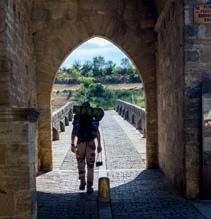





Artisan cheesemonger Clara Diez
What is Formaje, and why did you create it?
I founded Formaje in 2018 with my husband, Adrián.We’d both been working in the world of cheese for four years, focusing on artisanal cheese production.We’d started to develop a deep understanding of the world of artisanal cheese, as well as of the challenges that small cheese producers were facing.
That’s when we decided to found Formaje. We created it as a platform to help educate people on artisanal farming and cheesemaking, but in a modern and engaging way.
We wanted to change the image of artisanal cheesemaking to connect more with a younger audience. Our ambition was always to rejuvenate the cheese sector and speak of artisanal practices in a way that
was accessible to the wider public.We have a cheese boutique in Plaza de Chamberí in central Madrid, and sell artisanal cheeses from Spain and across Europe online.
We feel that we have a vocation to encourage people to experience cheese. It’s not just about buying, but also about engaging in conversations and allowing consumers to come and discover different cheeses.The idea is that this experience is a sensory one – it allows us to show all the work that goes into the products.
You’ve called yourself a cheese activist. What do you mean?
For me, an activist is someone who fights to create visibility around something that ordinarily isn’t widely spoken about, or of which there isn’t enough awareness in society. I believe that all of us who defend something
related to artisanal production are activists, because we’re trying to defend a way of consuming that isn’t so common today. Our society mostly nourishes itself now with industrial products rather than artisanal ones.These industrial products remove any link with the countryside and the people who create the products. Formaje opposes this.
We’re trying to show people that by eating a delicious, artisanally made, gastronomically rich cheese, they are also contributing to an entire process that creates value and helps keep these artisanal practices alive.
This is why we see ourselves as working on a form of activism – we’re trying to make visible ways of consuming that don’t occupy the space and position in society that they should. I’m not the only activist; anyone who defends an artisanal way of consuming produce is also an activist.
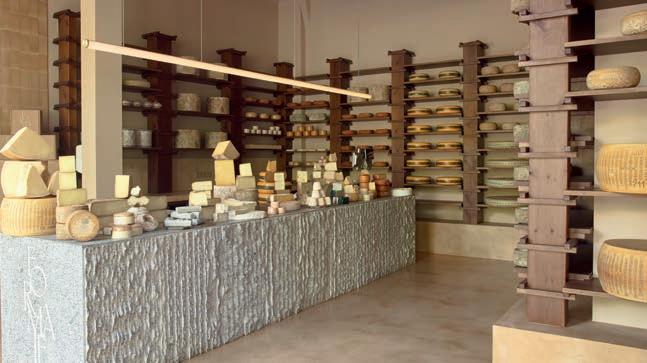 Dairy queen (opposite) cheesemonger Clara Diez has, together with her husband, Adrián, made it her mission not only to shake up the image of artisan cheesemaking, but also to champion the importance of artisan food production over industrial methods; (above) the Formaje boutique shop in central Madrid is a treasure trove of specialist cheeses from all over Spain and across Europe, available to buy in person or to order online for delivery
Dairy queen (opposite) cheesemonger Clara Diez has, together with her husband, Adrián, made it her mission not only to shake up the image of artisan cheesemaking, but also to champion the importance of artisan food production over industrial methods; (above) the Formaje boutique shop in central Madrid is a treasure trove of specialist cheeses from all over Spain and across Europe, available to buy in person or to order online for delivery
Passionate advocate Clara is keen not only to encourage people to enjoy a multi-sensory experience tasting cheese, but also to ensure that traditional artisanal practices endure



Do you have a favourite Spanish cheese or food region?
Galicia is a fabulous place. It’s a region that’s really pushing its cheese production – though it has always been an important cheese-producing area.Thanks to its rainy climate and plenty of space for grass to grow, there’s lots of nourishment for animals – cows, importantly. It’s historically been a place grazed by cattle, unlike other parts of Spain that have drier climates. Galicia has always interested me – but now, more than ever, we’re seeing new, innovative cheesemakers surging there.
You can try extremely ancient varieties in Galicia – for example, Queixo do Pais (‘country cheese’), traditionally made at home by women using milk from the two or three cows owned by their family.There are also new cheeses made by the likes of Airas Moniz, which has really boomed in Spain in recent years, bringing something new to Galicia in the form of a blue cheese, which isn’t typically produced there. Galicia’s natural landscapes also make it an unbeatable place – it’s beautiful.
What does sustainable travel mean to you?
For me, sustainable travel is all about respecting the place that you’re visiting – adapting to the way of living and being


there. I think it’s very important not to impose ourselves on the places that we visit. I like to find connections and links to places and experiences – things that make me feel closer to how life is truly lived on a daily basis.
What should visitors to Formaje expect when they come to see you in Madrid?
The Formaje boutique is open from 10am to 9pm, Monday to Saturday.We also offer

two-hour cheese tastings during which we share our knowledge about various cheeses in a convivial space under our cheese shop. By doing so, we encourage people to come and both enjoy the flavours of artisanal cheese, and to learn about the processes of creating it.These tastings usually take place on Thursdays, Fridays and Saturdays, and can be booked on our website. formaje.com

The land calls. It whispers: “come back” to emigrants and to their descendants, because it yearns for those who established strong connections with its nature and its people.
Hugo Sánchez Mateos, born in Madrid in 1987, returned to his parents’ homeland in Extremadura ten years ago to work as a technician in forest and natural environment management. More recently, he has devoted himself to ornithology full time.
Hugo absorbed his father’s passion for birds long before he learned to hold binoculars.The north of Cáceres province is his favourite birdwatching area, and the Portaje reservoir is his top destination “because of emotional memories, I guess, from having been there a lot since I was little”.
Since 2016, Hugo has coordinated the Extremadura Rarities Committee, which he founded together with five field ornithologists with the aim of compiling and standardising records of birds considered regional rarities.The recently publishedVII report includes the first regional sighting of a greater spotted eagle, seen at his favourite reservoir, and four records of the lanner falcon, listed as regionally extinct in the Red Book of the Birds of Spain 2021.
Hugo balances his work as a nature guide for Iduna Tours (idunatours.com/en-gb) with time sharing scientific information and his voluntary service as a bird ringer for the NGO SEO/BirdLife. In 2018, his team

confirmed a visit from an aquatic warbler, one of the “most endangered species and one of the most exciting”, on migration. This bird, which weighs only about 10g, makes a trip of around 6,000km from its breeding grounds in Eastern Europe to winter in sub-Saharan areas.
Although it can sometimes take him ten days to capture a single specimen, and occasionally there are years in which no birds are ringed, he describes his contribution to ornithology as “one of the greatest joys”. He cites the moment when his team recorded a Siberian chiffchaff, marking the first sighting of this subspecies in Extremadura.
Within the region, some areas are particularly favourable for certain breeding species – for example, the Arrocampo reservoir.This is the only site in Extremadura with a population of bearded reedling, and the only reservoir in Cáceres province where there is evidence of breeding great bittern and ferruginous pochard, the latter of which is at risk of extinction in Spain.

historically dominated by agriculture and livestock farming. Partly as a result, it is home to a wide range of Mediterranean birds, some of them considered threatened or of conservation interest, such as the black stork, Bonelli’s eagle and steppe birds.
“Extremadura is home to a range of Mediterranean birds, some threatened, including the black stork and Bonelli’s eagle”
Despite the success of some conservation and endangered birdlife recovery projects in several Special Protection Areas, Hugo believes that there is still much work to be done. He pleads for a more sustainable introduction of renewable energy schemes, for changes in land management and agricultural subsidies, and for the promotion of sustainable tourism all over Extremadura. Hugo is also highly self-critical, conscious of his duty as a nature guide to raise ecological awareness among travellers.Through his work leading for Iduna Tours, he aims to contribute by placing great emphasis on respect for ornithology, and by being rigorous with the data and information provided on these tours.
Extremadura is a land of diverse natural charms.The preservation of its ecosystems was one of the few positive consequences of the lack of industrialisation in a region

Extremadura is undoubtedly one of the best birdwatching destinations in Europe –and we are all responsible for preserving the wildlife habitats of these lands that welcome visitors so warmly.



RENOWNED SPANISH FLAMENCO DANCER FROM ANDALUSIA
Words by Eddi Fiegel Step by step Flamenco‘s roots are thought to lie in the Roma migration from Rajasthan in northwestern India to Spain, where the Roma migrants brought musical instruments including tambourines, bells and wooden castanets Flamenco dancer Sara BarasFor a tradition dating back thousands of years, Spanish flamenco culture is not just alive and well, but flourishing the world over. From the vibrant colours, swirling frills and polka dots of the traditional ‘traje de flamenco’ dresses worn by female dancers – often referenced by contemporary fashion designers – to the polyrhythmic handclapping, dynamic guitar instrumentals, visceral vocals and rapid fire of the dancers’ zapateando footwork, flamenco’s influence is far reaching.
Thought to have been brought to Andalusia by Gitanos, or Roma, from India’s Rajasthan somewhere between the 9th and 14th centuries, the story goes that these people’s music and dance mixed with the rich traditions of the Jews and Moors in Al-Andalus and a new culture was born.
of Flamenco’ and has performed on the world’s most prestigious stages, from London and Paris to NewYork and Tokyo. In 2020, she won the UK’s Olivier Award for Outstanding Achievement in Dance.
A child prodigy, Baras started dancing at the age of five in her native Cádiz, and aged just 21 she performed at the 1992 Seville Expo. Suddenly the whole world’s eyes were fixed on her talent and virtuosity, as well as flamenco culture in general, and she has never looked back since.
“This isn’t just a job that you do from nine to five. It’s my means of expression and my way of feeling. For me, dancing is my life”
Seven centuries on, superstar Spanish dancer Sara Baras is known as the ‘Queen
She had initially made a name for herself in Spain by dancing the ‘farruca’ – a dance traditionally only performed by men, and characterised by its intense footwork and sweeping turns.
More than thirty years on, Baras is still dancing the ‘farruca’, albeit in a new style.
“It was something that defined me,” she told me in 2019, “and I’m even braver now because I can do it with a violin and a saxophone, or however I want.”
Whilst for many visitors to Spain, flamenco is little more than an evening’s entertainment; for Baras and many of her fellow musicians and dancers, it is much more. “This isn’t just a job that you do from nine to five,” she explains. “It’s my means of expression and my way of feeling. For me, dancing is my life.”
If you really want to sense the sweat, sawdust and passion of flamenco, the small bars, also known as tablaos, of Seville and Jerez are hard to beat. Madrid also has tablaos, so you can enjoy flamenco when visiting the capital too. Otherwise, look out for annual events such as the Festival Flamenco Fuengirola Juan de la Loma in October, the Semana Flamenca Benalmádena in November and the Feria de Sevilla (Seville Fair) in April.
In the UK, Sadler’s Wells Theatre hosts an annual Flamenco Festival.
 Sofia
Sofia
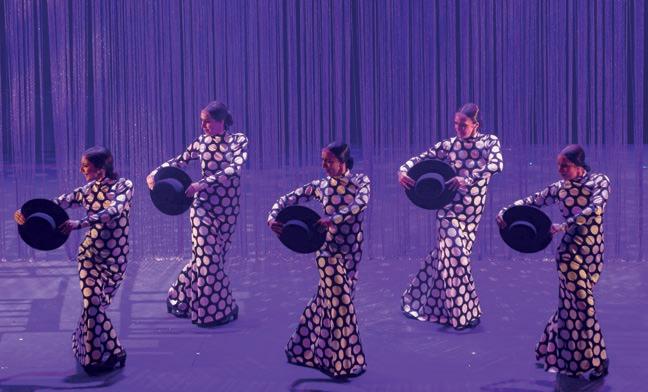


In the spotlight (this page; clockwise from top) Flamenco is far more than a form of entertainment in Spain – for many it’s an essential form of expression; there are three elements of flamenco, which include the dance as well as guitar playing and singing; Sara Baras is known as ‘the Queen of Flamenco’ and has performed all around the world; (opposite page) the intricate details of the flamenco dresses worn by performers are an art form in their own right
Flamenco dancer Sara Baras
DIRECTOR AND REWILDER, LA MALEZA WILDLIFE PARK
Interviewed by Jessica VincentProtecting swathes of natural landscape, and involved in the release of Spain’s first semi-wild herd of the specially bred cattle called tauros, Parque de Fauna La Maleza (La Maleza Wildlife Park) is paving the way for a wilder, more biodiverse future in the Iberian Highlands. The park’s director, Ricardo Almazán, discusses the work being carried out, and explains how you can visit and what to expect here.
How did La Maleza become a wildlife park and rewilding centre?
The park used to be a zoo, with bears and other large animals in tiny cages. It broke my heart to see them like that. When the zoo closed, my husband and I sold our business and bought these 23 hectares of land [in south-west Aragon] with a vision to conserve the natural landscape and turn it into a sanctuary for rescued animals. Our ultimate goal
was to teach people about the wild species that once roamed freely across Spain. The rewilding project came later, when Rewilding Spain contacted me to help facilitate the release of the first herd of tauros – a cow bred to behave like the extinct aurochs – and semiwild Pottoka ponies [read more on page 100].
What animals do you have there?
We house only animals that are native to the Iberian Highlands or well suited to this environment, such as Iberian wolves and foxes, ibex, wild boar and deer. All of our animals are here because they cannot be released into the wild, usually because of injury or because they have been born in captivity elsewhere and would no longer be able to survive in the wild.
How is La Maleza different from a zoo?
First, the enclosures are much bigger than in zoos, and built in harmony with the
The good life (this page; clockwise from top left) Ricardo Almazán is passionate about creating a more biodiverse future for the Iberian Highlands; visitors to La Maleza Wildlife Park can enjoy safari expeditions in partnership with Rewilding Spain to learn about the fauna of the area



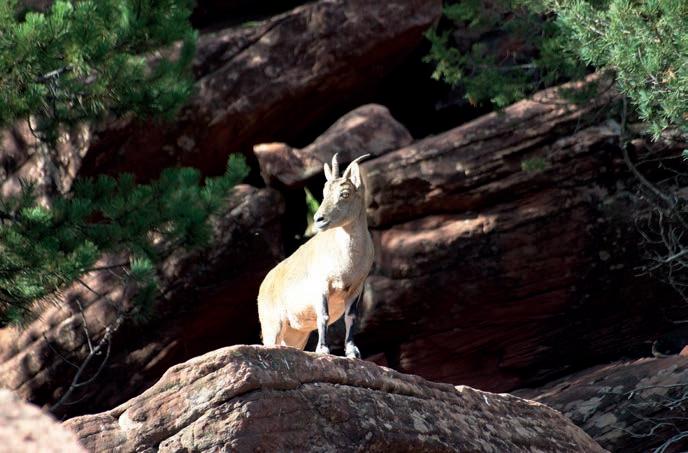
natural landscape. Because of this, the animals spend most of the day undisturbed by humans, in a state of semi-freedom. The only time visitors will see the wolves, for example, is during public feeding time, once a day.
The types of animals we rescue are also an important differentiator.We accept only species that are naturally adapted to this landscape and climate – so no penguins or giraffes.This is because, first, it’s cruel to keep animals in environments they’re not used to, and second, we want to teach people about animals native to this region. But the biggest difference is our approach to education, which is centred around rewilding. At a zoo, you walk past animals –many of which have been bred specifically for captivity – behind a glass window or in a wire cage. Maybe there’s an information plaque to explain what the animal eats and how big it grows. But here, we want to make people think. Most days, I give talks about our wolves, foxes and tauros, explaining why they’re under threat and how important they could be in regenerating our landscapes. We want people to question how they think about wildlife, especially the species that are often misunderstood or demonised, such as wolves and foxes.
I recommend arriving in the morning, and to spend some time walking our marked trails, which take in all of our animal enclosures.Then join our educational talks on the tauro (12.30pm), the Iberian wolf (1pm), and the fox (1.30pm), at which you’ll learn about the species and their
impacts on the environment. In the case of the wolves and foxes, you’ll also be able to see them feeding during these times. If you’re here between spring and autumn, finish your visit with a sunset safari to our nearby rewilding territory, where you’ll be able to see herds of free-roaming tauros and endangered Pottoka ponies.
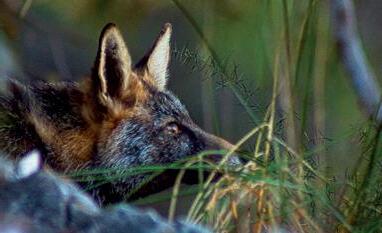

Standing atop the cliffs of Galicia’s dramatic Costa da Morte (Death Coast), the hotel Parador Costa da Morte is a beacon of responsible hospitality in Spain. Director Julio Castro Marcote discusses its conception, and how this scenic escape has been encouraging conscious travellers to flock to Spain’s green corner.
Can you tell us about Parador Costa da Morte and its origins?
The Parador Costa da Morte opened in June 2020.The decision was taken to build a Parador hotel on the Costa da Morte in 2002, after an environmental disaster caused by an oil-tanker spill off the Galician coast led to the collapse of the local fishing industry for more than a year. It was decided that tourism in this area needed a boost, and this would in turn create local employment opportunities and help to protect the environment.
Galician architect Alfonso Penela was chosen to create the hotel. He conjured a modern glass building that overlooks the Costa da Morte, an area that is known for its rugged coastline and powerful, foaming waves.When you enter the hotel, it initially seems modest in size; however, because it has been built in tiers that gradually rise up the sloping hillside, you soon realise, once inside, that it’s a lot bigger than you first thought.
The Paradores group – a national network of hotels located in restored heritage buildings and unique sites around Spain – has


more than one million loyal guests who enjoy staying at its properties across the country. Parador Costa da Morte is one of the most popular stays in the network, which is a great source of pride to us. Just as importantly, it also offers a regular income stream to the local community, since 80% of our staff are from the surrounding area.
How have you made responsible hospitality a focus?
Thanks to the hotel’s construction, which uses a large amount of glass, we are extremely energy efficient.The building faces east, so we receive light from the rising sun in the morning and throughout the day, meaning the central building is heated naturally – even in winter.This sustainable approach goes for our outdoor swimming pool and spa with indoor pool, too, which are heated using aerothermal energy.
In addition, we have planted vegetation on the roof of the building that helps regulate the temperature of the rooms.We water the roof – as well as our 13 hectares of land – daily, so water conservation is very important to us. Consequently, we built two stations on site that purify our wastewater and allow us to recycle it to water our fields and plants.
Similarly, we source as much of our food as possible from local Galician producers, following the philosophy of zero-kilometre gastronomy.We are committed to preparing and serving traditional Galician recipes that celebrate locally sourced ingredients, such
as octopus, rice with lobster, and caldeirada, which is a traditional fish and potato stew.
What can visitors expect to see and do at the hotel?
We encourage our guests to enjoy the natural elements of the local area as part of the Paradores ‘Nature for the Senses’ programme. Our guests can enjoy spectacular coastal hikes that lead to beaches and lighthouses such as the one at Finisterre.We have breathtaking views over the ocean as well as out to Cape Vilan and its distinctive lighthouse, where you’ll also find a cemetery that is the final resting place of 170-plus British sailors who lost their lives when their ship (HMS Serpent) sank off the Costa da Morte in 1890.
We also offer horseriding excursions and the opportunity to learn how to dive.There are many shipwrecks here; in fact, that’s how the Costa da Morte got its name, because of how treacherous it was.
Guests can also learn the Galician craft of making bobbin lace.A local artisan regularly comes to run workshops and courses for anyone wanting to try this historic craft.
Do you have any further sustainable initiatives planned for the near future?
We’re currently installing eight charging stations for electric cars.We also plan to add solar panels within the next five years so that we can produce even more of our energy from renewable sources.

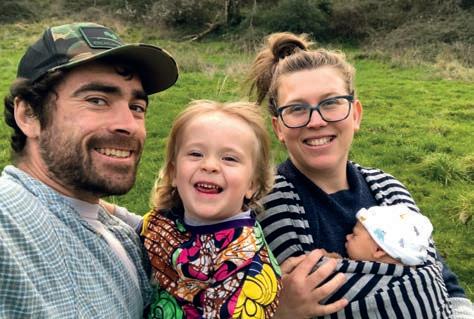
Discover how a hands-off approach is allowing wildlife to thrive in a famously green corner of northern Spain
Words by Cathy Robinson“We’re trying to create a safe space for wildlife,” smiles Luke Massey, amid the deliberately messy oasis of Wild Finca. “I like to call it agriwilding – a mixture of rewilding and nature-friendly farming.” Butterflies tumble around in tireless courtship like blossom caught on the breeze, and the air is heavy with the coconut scent of gorse.
This farm sits in a pocket of Asturias, northern Spain, a leisurely 90 minutes’ drive from the nearest major city, Santander in neighbouring Cantabria. Its carpet of exuberant green is tucked beneath the looming bulk of the snow-bonneted Picos de Europa mountains. In fewer than five years, Luke and his wife, Katie Stacey, have transformed this patch of land into a place exploding with life – largely by letting nature do its own thing.
Luke nods at a buff-coloured bird perched at the top of a gorse bush, its stubby yellow beak crooning a scratchy song. “Corn buntings arrived for the first

time in 2023…” He tails off as a raptor soars overhead, before apologising because it’s only a buzzard, and he wants visitors to see a short-toed eagle or a vulture.
Wild Finca evokes a sense of wildlifebursting-at-the-seams living. Luke and Katie were inspired to try rewilding and living sustainably, alongside nature in Asturias, some years ago. Since then they’ve been joined by toddlers Roan and Albus,

The good life (this page; clockwise from top left) Luke Massey, Katie Stacey and their children, Roan and Albus, have made a farm in Asturias their home – and also home to thriving nature, from coconut-scented gorse to a host of butterflies, including these meadow browns



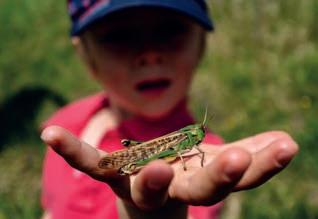


whose idea of a birthday treat is to venture out with their parents on the trail of owls or salamanders.
The couple chose Asturias, renowned as ‘green Spain’, for its mild climate as well as for its nature. “It’s a biodiversity hotspot with a potential unmatched in Europe,” says Luke.The farm had previously been heavily grazed, with uniform fields of grass, fences and not much else.That’s quickly changing. By their own admission, the couple aren’t experts in nature conservation but are driven by a passion to create something positive for the natural world. “We’re learning as we go,” says Katie, adding that “Wild Finca is an experiment for us, really.”
Luke and Katie’s largely hands-off approach has changed the landscape radically. Scrub such as gorse, bramble and blackthorn now provide valuable wildlife habitat, while profuse beds of nettles buzz with insects. At the last count, 108 bird species and more than 30 different mammals – including 16 bat species – have been spotted in Wild
Finca’s modest 16 hectares. “Different things pop up every year, and we can never tell what’s going to happen,” adds Luke. “Nature does as she pleases.”
Although the couple allow nature to take the lead and run its course almost all of the time, the habitat is managed where beneficial. Luke is in the middle of planting 4,500 native trees, and the couple are pondering what the future of a newly acquired field in the middle of their land will hold.
“We know it’s currently good hunting habitat for red-backed shrike,” says Katie of their new patch. This bird, with its bluegrey bonnet, pirate eye patch and chestnut back, is known for spearing its prey on barbed-wire fences and thorns. “If we let the land revert to grass and scrub, it won’t suit them,” she says, thoughtfully. “So we might create a traditional hay meadow, with plenty of wildflowers.” For the moment, the field stands in stark, barren contrast to its flourishing
surroundings, a reminder of the farm’s previous incarnation.
Katie and Luke aren’t working ecosystem magic here alone.To help, they’ve introduced Asturcón ponies and Casina mountain cattle – native breeds that graze and trample the land, creating a mosaic of different habitats that suit a wide variety of wildlife.
“At the last count, 108 bird species and more than 30 different mammals have been spotted”
The project hasn’t all been plain sailing, as can be imagined with any undertaking of this size.“We did have sheep,” says Luke, “but they trashed our ponds and ate all the wildflowers. So we replaced them with the cattle. They graze an area for a day or so, trampling and fertilising as they go, then I move them on to go elsewhere.”
This type of rotational grazing is carefully planned to maximise the chance of wildflowers blooming and seeding, and to protect ground-nesting birds. Since the cattle have arrived, more orchids have bloomed where the sheep previously munched.
Wild wonders (this page; clockwise from top left) The couple are acquiring more land to manage for the benefit of species such as red-backed shrikes, which impale prey on thorns; smaller creatures including grasshoppers thrill young nature-lovers; lizards thrive among the vegetation, while tours farther afield yield encounters with larger mammals such as Cantabrian brown bears – among the once-widespread mammals that Luke would love to see returning to the area



Luke surveys a field in which wildflowers dance in the breeze. It’s criss-crossed with flattened areas of vegetation where the cows have wandered, decorating the grass with dollops of manure. “This is exactly how I want it,” Luke nods approvingly. “Just this amount of grazing is enough.”
He then points out a small area of turnedover earth, sprouting with tiny plants including a delicate scarlet pimpernel. “Wild boar,” he explains. After these bristly beasts have rootled around in the soil, all sorts of plants appear in the bare earth. “Boars have a reputation for being destructive, yet they only ever turn over small patches at a time here,” observes Luke. “I think it’s because we don’t use fertiliser. I’ve had hunters offer to solve my wild boar problem for me – but I told them that I don’t have a problem.”
Neither do the couple see wolves or foxes as a threat. Quite the opposite – all nature is welcome at Wild Finca. “Yes, they will take some livestock, if measures aren’t put in place,” say Luke. In the mountains, shepherd dogs have traditionally been used to protect sheep from these animals. But take
away the predators at the top of the tree, and knock-on effects ripple out like sound waves.
Luke and Katie are keen to show Wild Finca to others. Luke leads half-day walks around the site, so visitors can learn about rewilding, nature-friendly farming and the wildlife it nurtures. Day tours venture into the surrounding mountains to seek species absent from Wild Finca – for now – like wolves and bears.The income from these tours goes towards buying more land and maintaining this wildlife-rich habitat.
“If we can inspire anyone to make some space for nature, then we’ve done our job,” says Katie.The couple aim to work with schools to connect future generations with the natural world, demonstrating how nature-friendly farming can improve resilience to climate change.
Luke makes his apologies as he goes back to tree planting. “The voles…” he raises his eyebrows. “They’re eating so many of my saplings” – a problem linked to the lack of predators such as foxes, weasels, wildcats
and, of course, wolves.This is what happens when the ecosystem becomes unbalanced.
For centuries, humans waged war on predators. “People so often see nature as an enemy to be eradicated,” Luke sighs. “But the trees destroyed by voles have cost us far more than the livestock we would have lost to predators that would have eaten the voles.
“It will be so interesting to see what this place is like in ten years’ time,” he adds, as we watch a buzzard soaring on thermals.
“Our biggest surprise has been how quickly nature bounces back.” Judging from Wild Finca’s energetic life, this precious piece of Spain is in good hands.
Flights from various UK cities serve Asturias Airport. Brittany Ferries sail frequently overnight from Portsmouth and Plymouth to Santander.
Wild Finca offers day tours and longer trips in the region; visit wildfinca.com
This refers to ‘the variability of living organisms, between and within species, and the changeability of the ecosystems to which they belong’ (The Convention on Biological Diversity)
The carbon dioxide (CO2) emissions of a person, operation or business, typically measured in tonnes. CO2e, or carbon dioxide equivalent, is the standard unit for measuring carbon footprints across industries.While there are more greenhouse gases that contribute to climate change, emissions are currently and typically measured in terms of CO2.
The balance between emitting, and the voluntary reduction and compensation (offsetting) of emissions, to achieve a neutral emission equilibrium.
A circular economy is regenerative and aims to reduce the consumption of finite virgin resources. It encourages the evolving or adaptation of mostly lifestyle products so that they can be reused for longer, and when no longer usable, can be recovered for parts. It is a systemic approach designed to benefit businesses, society, and the environment.
Putting the host community at the centre of the travel experience, the aim of CBT is to ensure local people benefit from the income generated from the travel industry. This includes owning and managing their own surroundings, economy and business.
CBTs are seen on responsible tour operator itineraries – such as Intrepid Travel’s immersive experiences and Experience Travel Group’s ‘Give Back Experiences’. Community-based tourism initiatives may also be supported by donations from an operator’s non-profit arms, such as Planeterra by G Adventures, the Intrepid Foundation or the Great Plains Foundation.
A certification of sorts that suggests an environmentally-positive operation. However, accreditation varies in standard and integrity and only external professional bodies should be considered as trustworthy. Even then, it’s important to consider the criteria for certification – as some accreditations are basic, others are more stringent.
According to the International Ecotourism Society, eco-tourism is “responsible travel to natural areas that conserves the environment, sustains the well-being of the local people, and involves interpretation and education”.The term is often used interchangeably with ‘sustainable tourism’, although the latter can relate to any area of sustainability within the sector, not only nature-based tourism.
This is a very loose term and can, technically, cover a whole manner of scopes –including those that may seem ‘green’ on the surface but aren’t on a deeper look. Businesses with a genuinely positive impact tend to offer more detail than this simple term.
Being ‘green’ is used to describe actions or initiatives that are conducted in a sustain-
able way, in an attempt to reduce impact on planetary resource limits. However, the word can be used to describe actions or initiatives that do not actively do this, but rather convey an ethos of being planet-friendly; eg being outside, walking or riding a bike.This can be considered ‘greenwashing’ (see below).
This is when an individual or company paints an action as credibly sustainable when, in fact, it is an action that benefits them, or that should be considered the bare minimum.This is typically in the form of an overstated or exaggerated claim of environmental or social impact. Sometimes, greenwashing can be unintentional due to a lack of understanding of what is genuinely impactful, but often it is deliberate disinformation intended to engage clients.
Net zero refers to the balance between the amount of greenhouse gas (GHG) that’s produced and the amount that’s removed from the atmosphere. It can be achieved through emission reduction and emission removal.
Renewable energy comes from (typically) naturally replenishing sources such as solar, wind, geothermal or hydroelectric (contested).They can be accessed via a public grid system or produced locally, perhaps on-site at a hotel or resort. Renewable energy is typically used for electricity.
According to the ResponsibleTourism Partnership, ‘ResponsibleTourism requires
that operators, hoteliers, governments, local people and tourists take responsibility, and take action to make tourism more sustainable. Behaviour can be more or less responsible, and what is responsible in a particular place depends on environment and culture’.The concept was defined in CapeTown in 2002 alongside theWorld Summit on Sustainable Development.
The process of protecting an environment and returning it to its natural state; for example, bringing back wild animals that used to live there (Cambridge Dictionary).
An approach to travel that emphasises a connection to local people, cultures, food and music. It relies on the idea that a trip is meant to educate and have an emotional impact, while remaining beneficial for local communities and the environment.
“Development that meets the needs of the present without compromising the ability of future generations to meet their own needs. Sustainable development requires the elimination of institutional fragmentation, ensuring that environmental, social, and economic concerns are integrated throughout decision-making processes and development that is fair, equitable and just.” (World Commission on Environment and Development)
The quality of being able to continue over a period of time, or the avoidance of the depletion of natural resources in order to maintain an ecological balance (Cambridge Dictionary).
Biosphere reserves are sites for testing interdisciplinary approaches to understanding and managing changes and interactions between social and ecological systems, including conflict prevention and management of biodiversity.They are places that provide local solutions to global challenges. Biosphere reserves include terrestrial, marine and coastal ecosystems.
A movement reducing the distance between producers and sales and
consumer establishments to a radius of under 100 kilometres, with the aim of minimising the effects that large-scale industry have on the planet, including soil erosion, water pollution, and habitat loss for wild species.
Zero waste is a set of principles that are focused on waste prevention and are geared around prolonging resource life cycles so that all products are repurposed and/or reused (see ‘Circular economy’). The idea is that this should ensure that no waste ends up in a landfill.
Awarded to cities over 100,000 habitants, to recognise and reward local action towards a transition to a greener, more sustainable future.Winning cities include their citizens in this transition, improve the urban environment, combat pollution and mitigate and prepare for more resilience to climate change.
Winners: Vilnius (2025),Valencia (2024),Tallinn (2023), Grenoble (2022), Lahti (2021), Lisbon (2020), Oslo (2019)
Developed by the US Green Building Council, Leadership in Energy and Environmental Design (LEED) is the most widely-used building sustainability rating system. For hotels and accommodation (buildings), this is assessed against areas such as energy and water efficiency, materials used, indoor air quality and awareness and education.
Editor-in-Chief George Kipouros
Founding Editor Lyn Hughes
Associate Editor Gareth Clark
Special Features Editors Rosie Fitzgerald & Rhodri Andrews
Special Features Assistant Editor Laura Field
Sub Editor Paul Bloomfield
Sustainability Contributing Editor Karen Edwards
Sustainability Editor at Large Ketti Wilhelm North America Editor Jacqui Agate
Writers
Marti Buckley, Ross Clarke, Esme Fox, Robin Catalano, Xenia Taliotis, Eddi Fiegel, Emerson Mendoza Ayala, Isabelle Kliger, Donna Richardson, Paul Stafford, Mark Eveleigh, Jessica Vincent, Meera Dattani, Anna Nicholas, Robin McKelvie, Laura Timm, Russell Maddicks, Cathy Robinson, Laura Field
Art Director Graham Berridge
Art Editor Lisa Duke
Map Illustration Scott Jessop
Digital Creative Director Anil Karwal
Digital Editor Jessica Reid
Chief Commercial Officer Adam Lloyds
VP Brand Partnerships David Read
Senior Creative Partnerships Manager Simon Bryson
Chief Operating Officer Elliot Wellsteed-Crook
Production Manager Peter Helfrich
Marketing & Social Media Manager Christina Wildman Mullett
Digital & Social Media Executive Nefeli Syriopoulou Wanderlust Club Manager Maria Manta
© Wanderlust Travel Media Ltd, 2024, ISSN 1351-4733
Published by Wanderlust Travel Media, Capital House, 25 Chapel St, Marylebone, London NW1 5DH. All rights are reserved. Reproduction in any manner, in whole or in part, is strictly forbidden without the prior written consent of the publishers. All prices are correct at time of press. No responsibility for incorrect information can be accepted. Views expressed in articles are those of the authors, and not necessarily the publishers. Wanderlust is a registered trademark.
Published by
Supported by
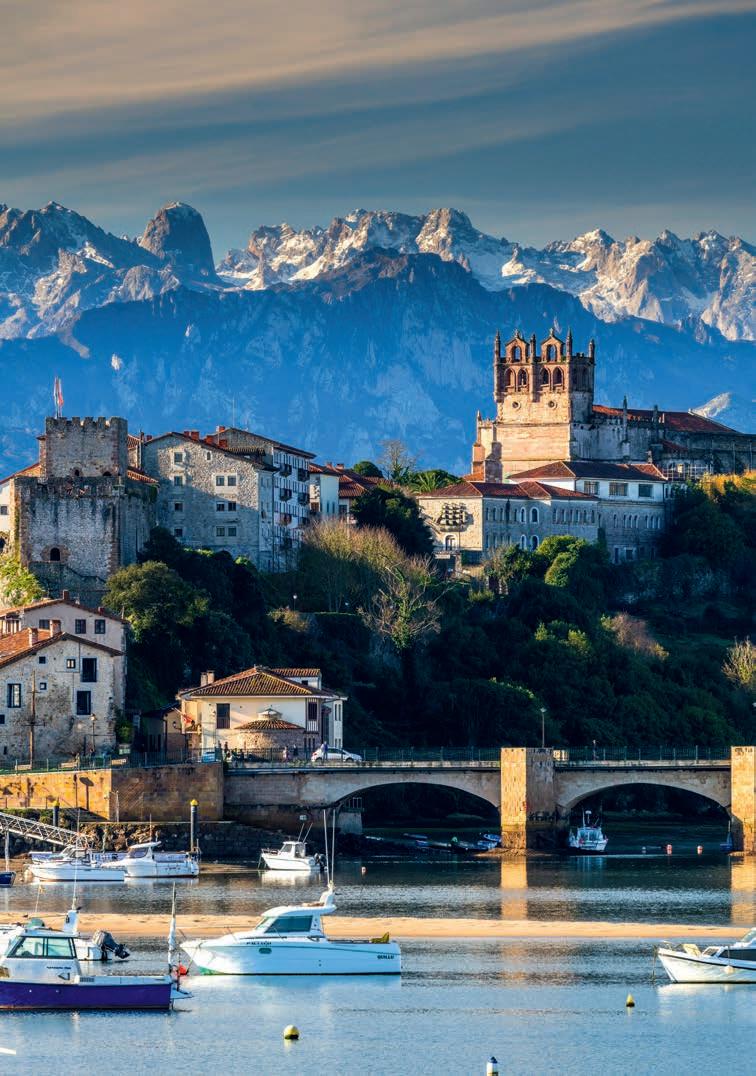
Spain recognises the vital importance of sustainable travel for preserving the habitats and local communities that make the country so enchanting. This special edition is packed with ideas and stories about the most spectacular sustainable travel experiences to inspire your adventures across Spain.

